Madrid, Spain's capital city, has preserved historic neighborhoods with modern infrastructure. The city was visited before Madrid by Córdoba, declared a World Heritage Site in 1984 for its well-preserved Roman and Islamic architecture. Consuegra featured windmills made famous by Don Quixote, while Toledo offered the Alcázar fortress, Gothic Cathedral, and Plaza de España, featuring statues of Cervantes and his characters.
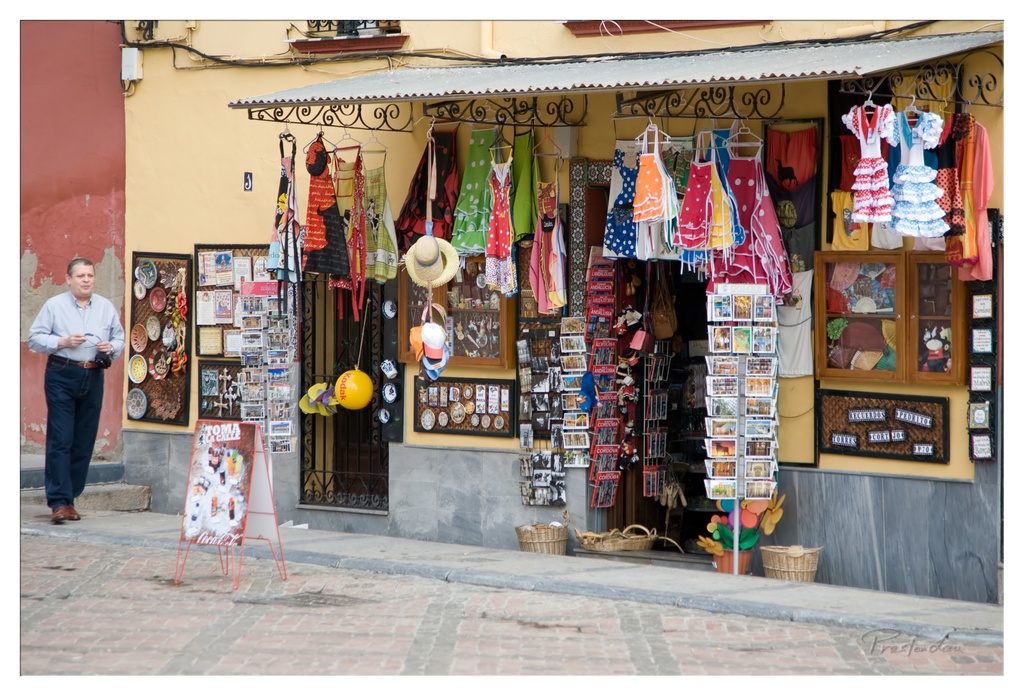

1. Overall Rating (0–10) — 6.8
This photograph captures the vibrant charm of a traditional souvenir shop in a European town, where color and texture tell a story of local culture. The bright array of clothing, postcards, and crafts creates a lively, inviting scene, though the composition feels slightly overloaded, with too much visual information competing for attention. The man walking by adds a sense of scale and narrative, grounding the image in everyday life, yet the overall effect is more documentary than artistic—capturing a moment without fully elevating it into a compelling visual statement.
2. Composition (0–10) — 6.0
The image is framed with a wide perspective, including too much of the surrounding environment, which dilutes focus on the shop’s colorful display. The man on the left creates a sense of balance, but the cluttered arrangement of goods and signage draws the eye in multiple directions, weakening the central narrative.
3. Lighting (0–10) — 7.0
Natural daylight illuminates the scene evenly, highlighting the rich colors of the merchandise without harsh shadows. The light is soft and diffused, enhancing the textures of the fabrics and wicker baskets, though it lacks dramatic contrast or mood.
4. Color & Tone (0–10) — 7.5
The palette is vibrant and varied, with warm yellows, reds, and blues creating a festive, inviting atmosphere. The contrast between the bright merchandise and the muted stone pavement adds depth, and the overall tonal balance supports the lively subject matter.
5. Creativity (0–10) — 6.5
The image is a strong representation of place, capturing authentic cultural elements with a keen eye for detail. However, it remains largely observational, with little innovation in framing or perspective—more of a snapshot than a creative interpretation.
6. Technical Quality (0–10) — 8.0
The image is sharp and well-focused, with clean details throughout. The depth of field is adequate, allowing both the foreground and background elements to be clear. There are no visible technical flaws, and the composition, while busy, is technically sound.
7. Emotional Impact (0–10) — 6.0
The photograph evokes a sense of nostalgia and wanderlust, inviting the viewer to imagine the sounds and smells of a bustling market street. While it captures the essence of travel and local life, it stops short of emotional resonance, feeling more like a record of a moment than an experience.
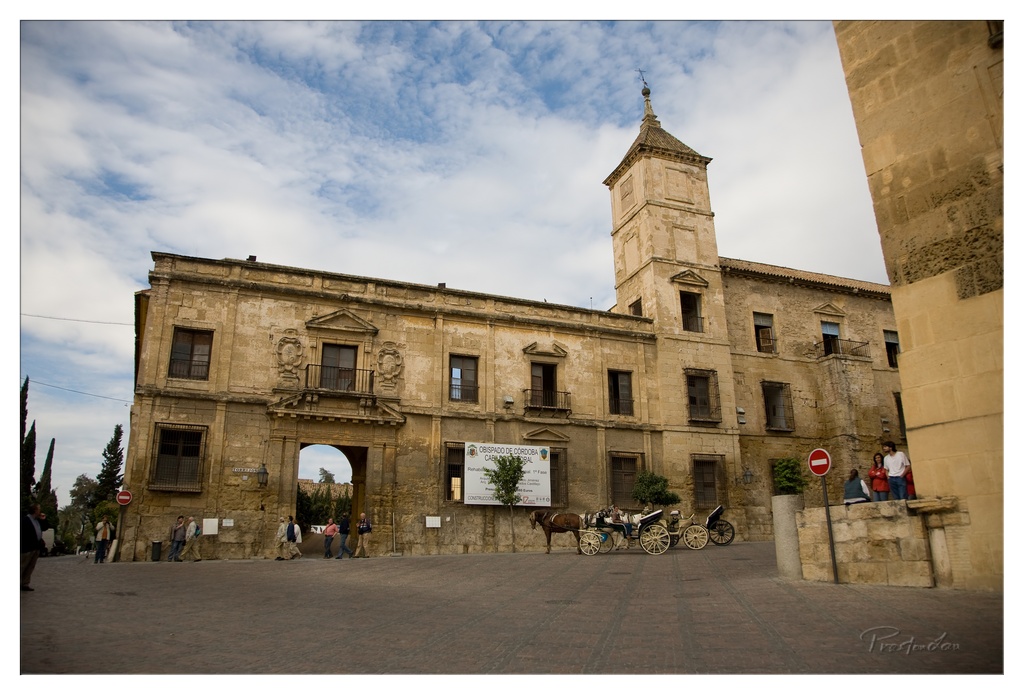

1. Overall Rating (0–10) — 7.0
This photograph captures the timeless grandeur of a historic Spanish plaza, where weathered stone and soft sky converge to evoke a sense of enduring legacy. The composition draws the eye toward the central archway and tower, while the presence of people and a horse-drawn carriage grounds the scene in daily life. Though the image is strong in atmosphere and historical resonance, it lacks the dynamic tension needed to elevate it beyond a pleasant document of place.
2. Composition (0–10) — 7.0
The low-angle perspective emphasizes the scale of the architecture, while the archway creates a natural leading line into the frame. The partial obstruction by the wall on the right adds depth, though it slightly disrupts visual flow.
3. Lighting (0–10) — 7.5
Soft, diffused light from the overcast sky enhances texture and detail in the stonework without harsh shadows. The scattered clouds add subtle contrast and movement to the sky, enhancing the mood.
4. Color & Tone (0–10) — 6.5
The warm, earthy tones of the stone are well-represented, but the overall palette leans slightly muted, lacking vibrancy. The blue of the sky provides a gentle contrast, but the image could benefit from more saturation to enliven the scene.
5. Creativity (0–10) — 7.0
The inclusion of the horse-drawn carriage and modern signage creates an interesting juxtaposition of past and present, suggesting a living history. The framing and timing convey a narrative of continuity, though it remains grounded in traditional architectural documentation.
6. Technical Quality (0–10) — 8.0
Sharp focus across the frame ensures clarity in both foreground and background. The image is well-exposed with no significant technical flaws, and the watermark is discreet.
7. Emotional Impact (0–10) — 7.0
The image evokes a sense of nostalgia and quiet contemplation, inviting the viewer to imagine the stories embedded in the stone walls. The human presence adds a touch of warmth, making the historical space feel accessible and alive.
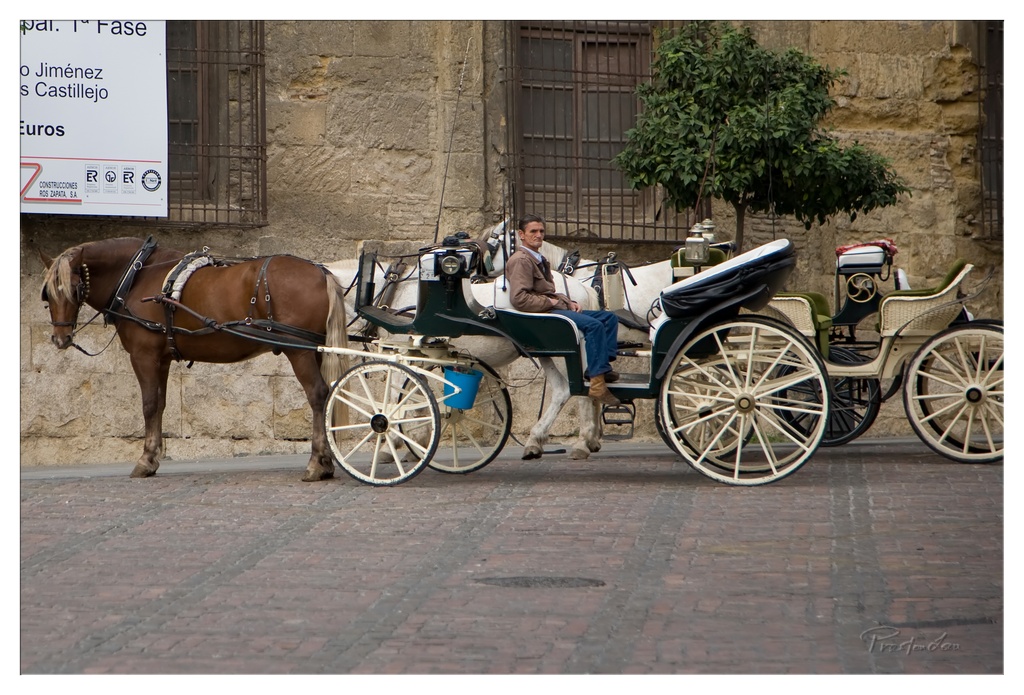

1. Overall Rating (0–10) — 7.0
This photograph captures a timeless moment in a historic European setting, where tradition and daily life intersect. The presence of the horse-drawn carriage, the stone architecture, and the casually seated driver evoke a sense of nostalgia and cultural continuity. While the composition is visually engaging and rich in texture, the slightly cluttered background and neutral lighting prevent it from achieving a more refined aesthetic.
2. Composition (0–10) — 6.5
The horizontal framing effectively captures the length of the carriage and the surrounding environment, but the inclusion of the sign and the second carriage on the right introduces visual distractions. A tighter crop would enhance focus on the main subject and improve overall balance.
3. Lighting (0–10) — 6.0
The lighting is even and natural, likely from an overcast day, which softens shadows and preserves detail across the scene. However, the lack of strong directional light or contrast limits the image’s depth and atmospheric quality.
4. Color & Tone (0–10) — 6.5
The palette is composed of earthy tones—browns, creams, and muted greens—that harmonize well with the historic setting. While the colors are natural and appropriate, they lack vibrancy, giving the image a slightly flat appearance.
5. Creativity (0–10) — 7.0
The image successfully captures a slice of life with a sense of authenticity and narrative. The juxtaposition of the traditional carriage with the modern signage adds a subtle layer of commentary on time and change, elevating the photograph beyond mere documentation.
6. Technical Quality (0–10) — 7.5
The image is sharp and well-focused, with clear details in the horse’s harness, the carriage’s woodwork, and the cobblestone pavement. The exposure is balanced, and the resolution is high, indicating strong technical execution.
7. Emotional Impact (0–10) — 6.5
The photograph evokes a quiet sense of calm and nostalgia, inviting the viewer to reflect on a slower pace of life. While the emotional resonance is present, it remains restrained, held back by the somewhat generic setting and lack of dramatic lighting or mood.
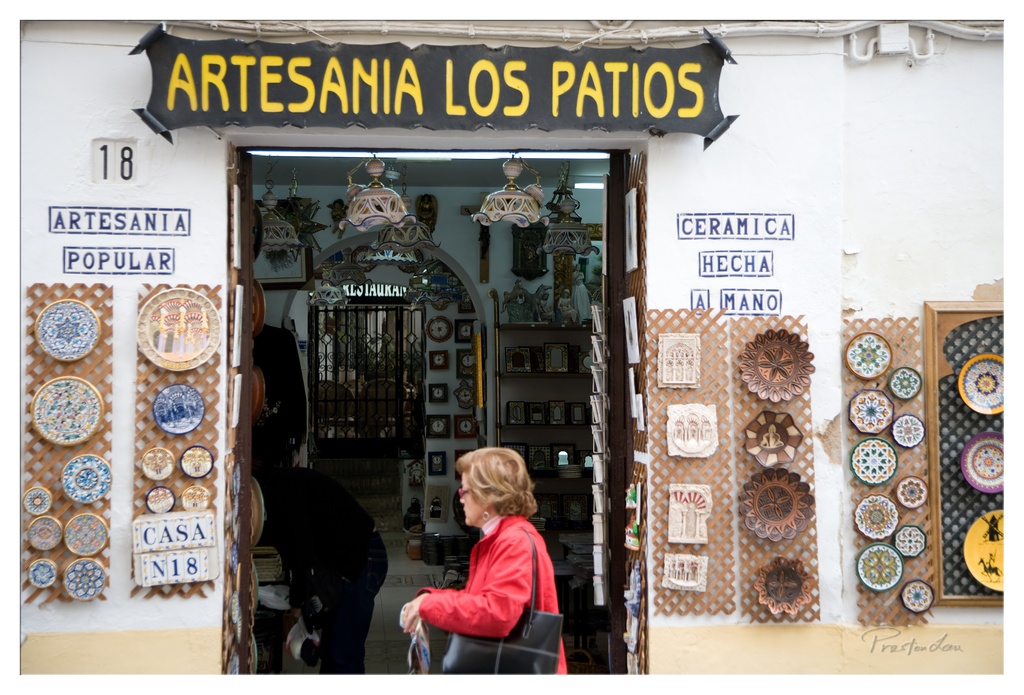

1. Overall Rating (0–10) — 7.5
This photograph captures the vibrant charm of a traditional artisan shop in a Mediterranean town, where handmade ceramics and warm textures evoke a sense of cultural authenticity. The composition draws the viewer into the inviting doorway, where a passerby adds a touch of life and narrative, while the bold signage and colorful wares create a rich visual tapestry. The image is strong in storytelling and context, though slight overexposure and cluttered details prevent it from achieving a more refined aesthetic.
2. Composition (0–10) — 7.0
The framing centers the shop entrance, creating a natural focal point, while the symmetry of the ceramic displays on either side adds balance. The woman in the red jacket provides a dynamic element, guiding the eye into the scene, though the depth of field could be tighter to reduce visual noise.
3. Lighting (0–10) — 6.5
Natural daylight illuminates the scene evenly, but the bright overhead light creates some glare on the ceramics and overexposes parts of the white walls. The interior remains shadowed, limiting detail in the back of the shop.
4. Color & Tone (0–10) — 7.5
The palette is rich and varied, with the deep blues and earthy tones of the ceramics contrasting beautifully against the white stucco. The red jacket stands out as a strong accent, enhancing the image’s visual energy and warmth.
5. Creativity (0–10) — 7.0
The image successfully blends documentary realism with artistic composition, capturing both the cultural specificity of the location and a fleeting human moment. The inclusion of text and objects as part of the visual language adds layers of meaning.
6. Technical Quality (0–10) — 7.0
The image is sharp and well-focused, with clear details in the ceramics and signage. However, some areas are slightly overexposed, and the depth of field is wide, resulting in a mix of sharp and soft zones that slightly dilute clarity.
7. Emotional Impact (0–10) — 7.0
There’s a warm, inviting atmosphere that evokes curiosity and nostalgia, suggesting a place where tradition and daily life intersect. The presence of the woman adds a human touch, making the scene feel lived-in and relatable.
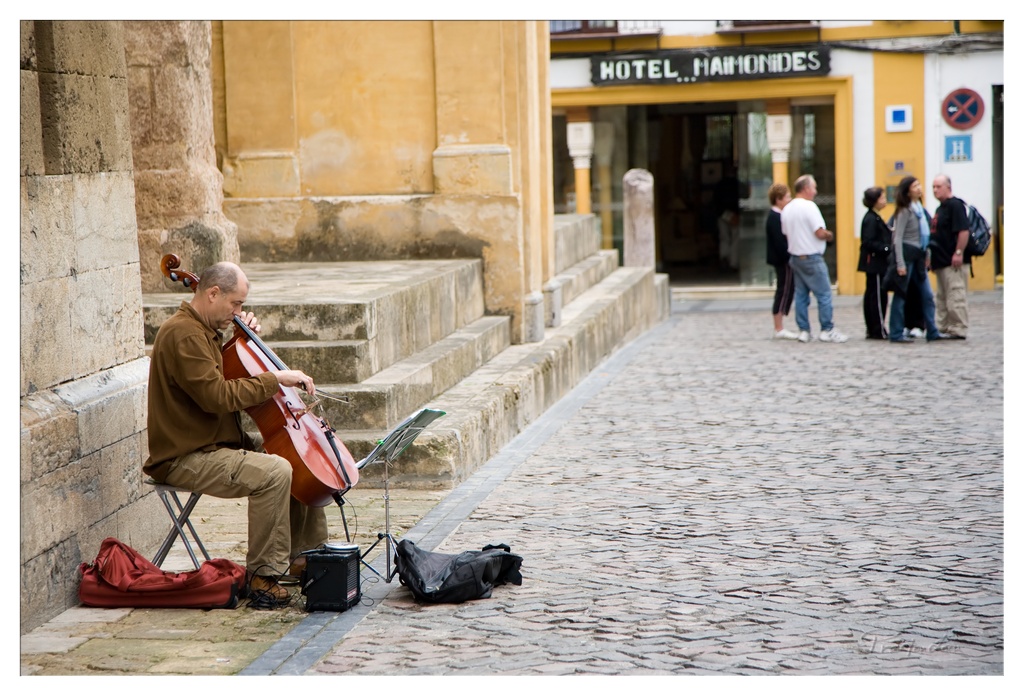

1. Overall Rating (0–10) — 7.0
This photograph captures a quiet moment of street performance, where the cello player’s focused immersion contrasts with the casual passersby in the background. The composition draws the eye naturally from the musician to the distant hotel, creating a sense of place and narrative. While the image feels candid and authentic, the muted lighting and slightly cluttered foreground keep it from achieving a more refined aesthetic.
2. Composition (0–10) — 6.5
The diagonal lines of the cobblestone street and stone steps guide the viewer’s eye toward the cello player, who is well-positioned on the left third of the frame. The background group of people adds context but slightly distracts from the central subject, creating a subtle imbalance.
3. Lighting (0–10) — 6.0
Natural daylight provides even illumination, though it lacks dramatic shadows or highlights. The light is soft and diffused, giving the scene a calm, documentary-like quality without enhancing mood or depth.
4. Color & Tone (0–10) — 6.5
The warm yellow tones of the building contrast gently with the cool grays of the cobblestones and the earthy browns of the musician’s clothing. The color palette is harmonious but restrained, with a slightly desaturated feel that limits vibrancy.
5. Creativity (0–10) — 7.0
The image succeeds in capturing a slice of everyday life with a narrative edge—music, movement, and stillness coexisting. The juxtaposition of the solitary musician and the indifferent crowd suggests a quiet commentary on public art and attention.
6. Technical Quality (0–10) — 7.5
Sharp focus on the cello player and clean detail throughout the image demonstrate strong technical execution. The depth of field effectively isolates the subject while still preserving background context.
7. Emotional Impact (0–10) — 6.5
There’s a quiet dignity in the musician’s concentration, and the scene evokes a sense of solitude and dedication. While not overtly stirring, the image invites reflection on the value of art in public space.
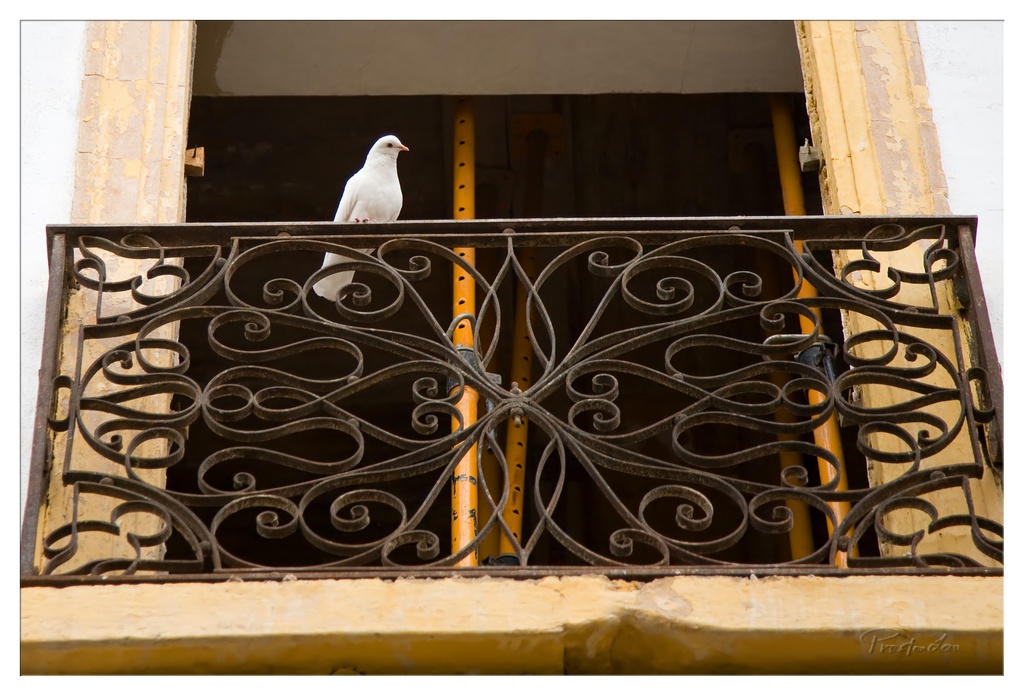

1. Overall Rating (0–10) — 7.5
This photograph captures a quiet moment of contrast between nature and urban decay, where a pristine white dove perches atop an ornate, weathered balcony. The interplay of the delicate bird and the intricate ironwork creates a poetic stillness, while the peeling yellow paint and industrial scaffolding hint at a city in transition. Though the image is rich in symbolism and mood, it feels slightly restrained by its straightforward composition and muted tonal range.
2. Composition (0–10) — 7.0
The bird is placed off-center, creating a sense of balance with the ornate railing, which dominates the frame. The leading lines of the wrought iron guide the eye toward the dove, though the cluttered background slightly distracts from the focal point.
3. Lighting (0–10) — 6.5
Natural daylight illuminates the scene evenly, highlighting the texture of the iron and the purity of the dove’s feathers. The light is soft and diffused, avoiding harsh shadows but lacking dramatic contrast.
4. Color & Tone (0–10) — 7.0
The warm yellow of the walls complements the white dove, creating a harmonious palette. The dark iron provides strong contrast, while the overall tone remains subdued, emphasizing the aged textures of the environment.
5. Creativity (0–10) — 8.0
The juxtaposition of the peaceful dove against the decaying architecture and modern scaffolding suggests a narrative of resilience and coexistence. The image feels intentional and layered, inviting contemplation beyond the surface.
6. Technical Quality (0–10) — 8.0
Sharp focus on the bird and railing ensures clarity in detail. The exposure is well-balanced, with no significant loss of detail in highlights or shadows.
7. Emotional Impact (0–10) — 7.5
The image evokes a quiet sense of peace amid urban decay, resonating with themes of hope and continuity. The stillness of the moment and the symbolic presence of the dove create a contemplative, almost meditative mood.
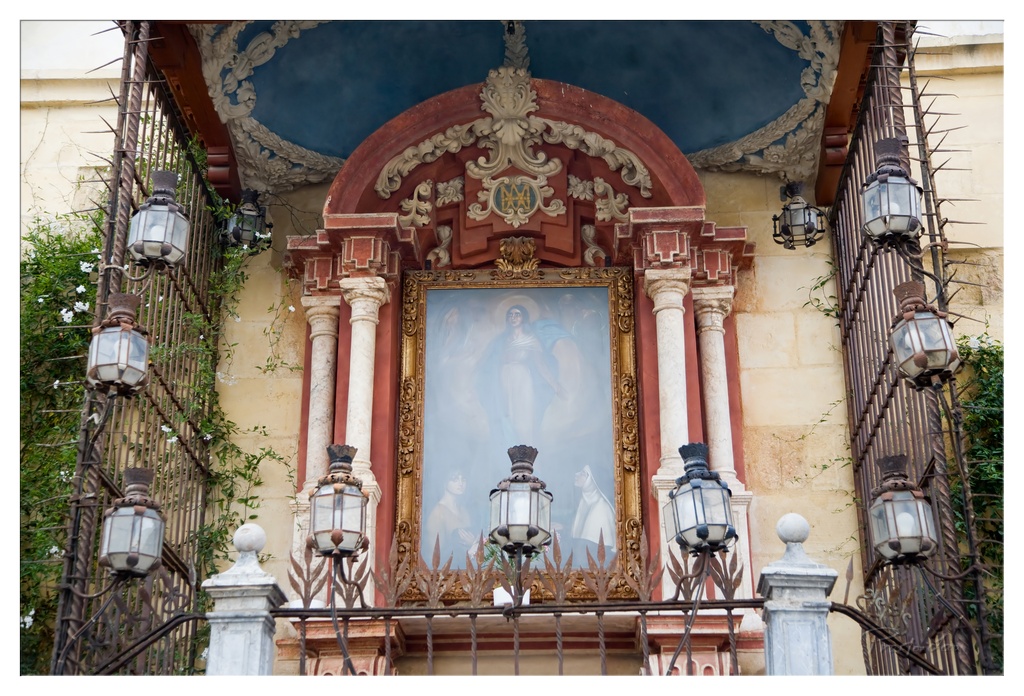

1. Overall Rating (0–10) — 7.5
This photograph captures the solemn grandeur of a religious shrine, where ornate architecture and spiritual symbolism converge in a quiet moment of reverence. The interplay of light, shadow, and texture—especially in the weathered stone and intricate carvings—gives the image a timeless, almost sacred quality. While the composition is strong, the muted tones and slightly overcast lighting temper its emotional punch, keeping it more observational than deeply moving.
2. Composition (0–10) — 8.0
The central placement of the painted icon draws the eye naturally, framed by symmetry in the columns and flanking lanterns. The surrounding wrought-iron gate adds depth and visual rhythm, creating a layered, balanced structure that guides the viewer’s gaze toward the focal point.
3. Lighting (0–10) — 6.5
Soft, diffused daylight illuminates the scene evenly, avoiding harsh shadows but also reducing the dramatic contrast that could enhance the monumentality of the structure. The light is functional but not particularly evocative, slightly flattening the richness of the textures.
4. Color & Tone (0–10) — 7.0
The palette is restrained—dominated by warm terracotta, cream, and deep blue—creating a harmonious and historically resonant atmosphere. The subtle tonal shifts in the stone and the faded hues of the painting lend a sense of age and authenticity, though the overall saturation is modest.
5. Creativity (0–10) — 7.5
The photograph presents a familiar subject with a thoughtful eye for detail and symmetry. By framing the religious icon within a decorative architectural niche and including the iron gate as a framing device, the image transforms a simple architectural detail into a layered narrative of faith and heritage.
6. Technical Quality (0–10) — 8.0
The image is sharp and well-focused, with clear details visible in the ornate moldings and lanterns. The depth of field is well-managed, keeping both the foreground and background elements in acceptable clarity without distracting blur.
7. Emotional Impact (0–10) — 7.0
There is a quiet reverence in the image that speaks to devotion and continuity. The viewer is invited to pause and reflect, but the emotional resonance is subtle—more contemplative than stirring, allowing the viewer to interpret the scene through their own lens of meaning.
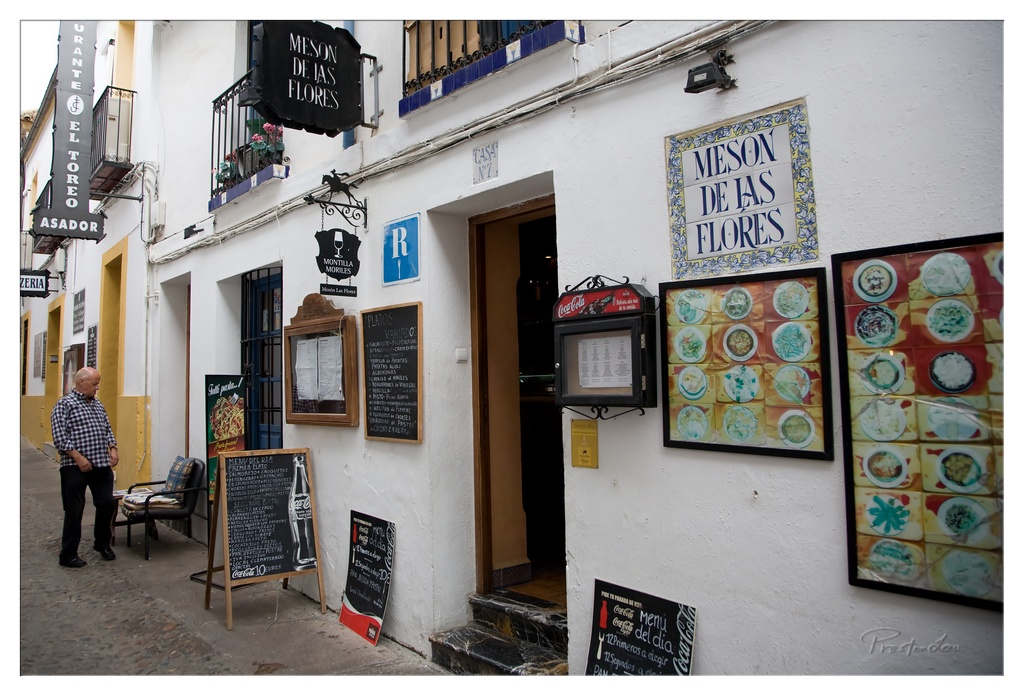

1. Overall Rating (0–10) — 7.0
This photograph captures the soul of a traditional Spanish tapas bar with rich authenticity and inviting detail. The layered signage, warm textures, and candid presence of a man strolling by lend a sense of lived-in charm and cultural depth. While the scene is visually dense and slightly cluttered, it successfully conveys the essence of a neighborhood gathering place—its strength lies in its narrative richness rather than formal composition.
2. Composition (0–10) — 6.0
The image employs a wide-angle perspective that captures the full façade of the restaurant and its surroundings, but the left side feels slightly unbalanced due to the overhang of the sign and the man’s placement. The diagonal lines of the alley and signage create visual tension, which could be more deliberately guided to draw the eye toward the entrance.
3. Lighting (0–10) — 6.5
Natural daylight illuminates the scene evenly, preserving texture and color without harsh shadows. The light is soft and diffused, suggesting a late morning or early afternoon, which enhances the warm, welcoming atmosphere of the setting.
4. Color & Tone (0–10) — 7.0
The palette is grounded in warm whites and yellows, accented by vibrant blues and greens in the tile signs and menu boards. The contrast between the bright façade and the darker door and shadows adds depth, while the occasional pop of red from the Coca-Cola branding adds visual interest without overwhelming.
5. Creativity (0–10) — 7.5
The image tells a story not just through its subject, but through the accumulation of details—signs, menus, tiles, and a quiet passerby. This layered approach reflects a keen eye for capturing everyday culture, transforming a simple street scene into a moment rich with context and character.
6. Technical Quality (0–10) — 8.0
Sharp focus is maintained throughout, with excellent clarity in the textures of the stucco walls and signage. The exposure is well-balanced, and the wide dynamic range allows for detail in both highlights and shadows, indicating strong technical execution.
7. Emotional Impact (0–10) — 7.0
There’s a quiet warmth and nostalgia in the image—evoking a sense of community, tradition, and slow-paced life. The viewer is invited to imagine the smells of cooking, the sound of conversation, and the comfort of a familiar place, making the photograph feel both intimate and universally relatable.
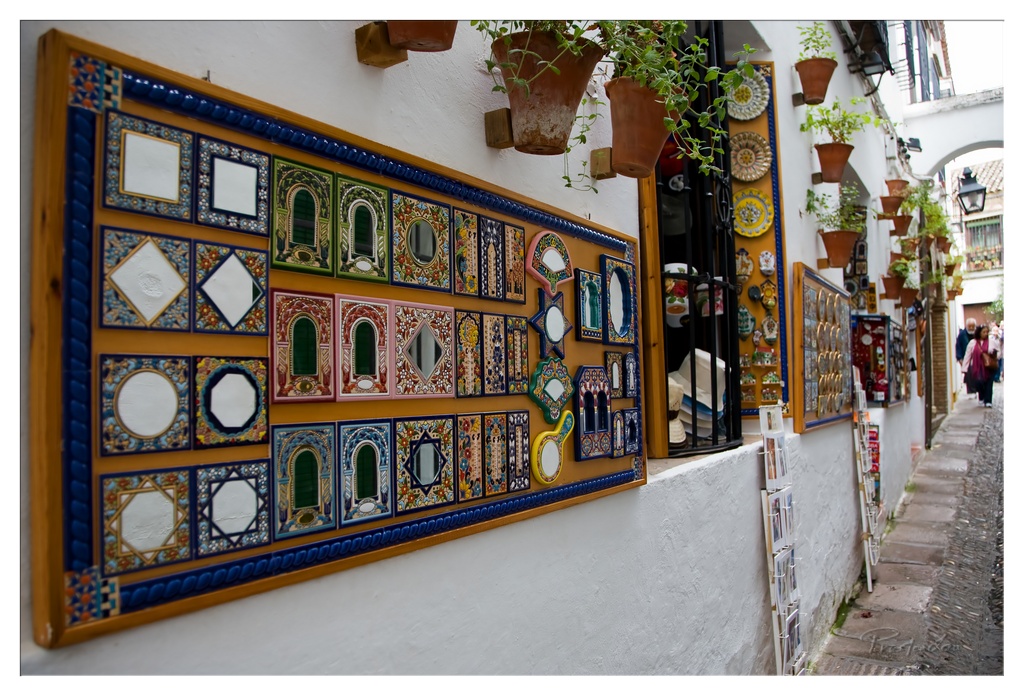

1. Overall Rating (0–10) — 7.5
This photograph captures the vibrant charm of a Mediterranean street, where intricate tilework and cascading greenery evoke a sense of timeless craftsmanship. The rich textures and patterns of the ceramic mirrors create a dynamic focal point, while the narrow cobblestone alley adds narrative depth. While the image is visually engaging, its potential is slightly diminished by a lack of atmospheric lighting and a composition that feels more documentary than artistic.
2. Composition (0–10) — 7.0
The diagonal sweep of the alley draws the eye into the frame, while the tiled display anchors the left side, creating a balanced yet dynamic structure. The inclusion of pedestrians in the distance adds scale and life, though their placement slightly disrupts the visual harmony.
3. Lighting (0–10) — 6.0
The light is even and diffused, likely from an overcast sky, which softens shadows and allows the colors of the tiles to stand out. However, the lack of directional sunlight or contrast reduces the image’s dramatic depth.
4. Color & Tone (0–10) — 8.0
The palette is rich and varied, with deep blues, warm terracotta, and earthy greens creating a harmonious yet lively visual rhythm. The contrast between the colorful tiles and the stark white wall enhances the vibrancy of the scene.
5. Creativity (0–10) — 7.5
The photograph successfully captures the cultural essence of the location, using the tiled display as both a subject and a storytelling device. The interplay between tradition and daily life adds layers of meaning, though the approach remains largely observational.
6. Technical Quality (0–10) — 8.0
The image is sharp and well-focused, with clear detail in the tile patterns and textures. The exposure is balanced, and there is no noticeable noise, indicating strong technical execution.
7. Emotional Impact (0–10) — 7.0
The scene evokes a sense of wanderlust and quiet wonder, inviting the viewer to imagine the stories behind the tiles and the people passing by. While emotionally resonant, the connection is subtle, relying on the viewer’s appreciation of cultural detail rather than an overt emotional charge.
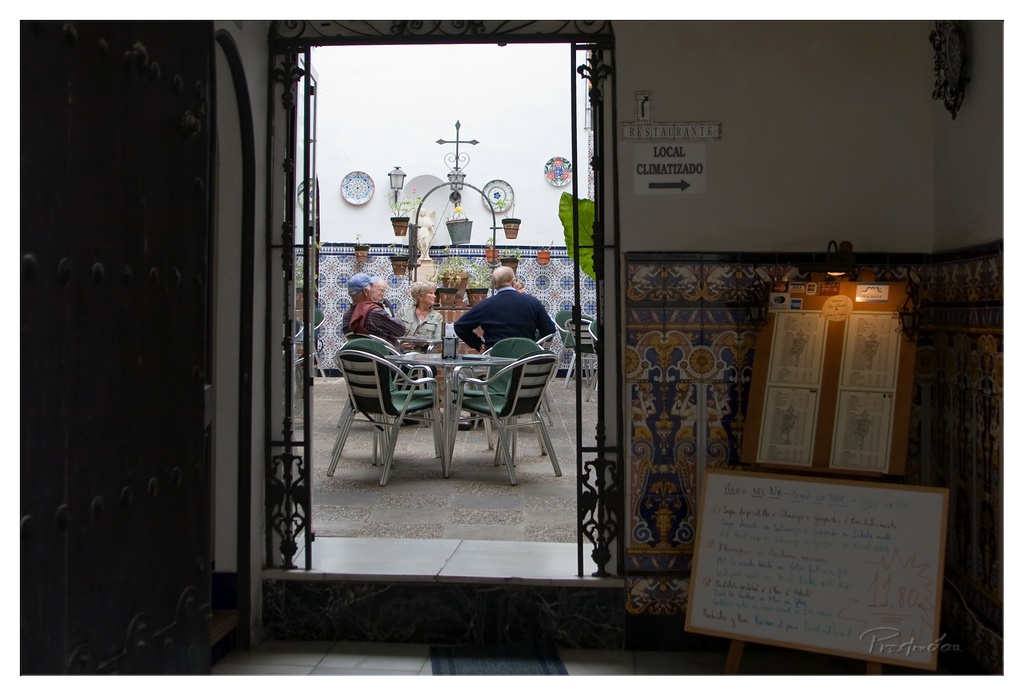

1. Overall Rating (0–10) — 7.5
This photograph captures the inviting stillness of a traditional Spanish café, framed by a dark, ornate doorway that draws the eye into a sunlit courtyard. The contrast between shadow and light enhances the sense of discovery, while the warm tones and cultural details evoke a quiet, lived-in charm. While the composition is strong, the scene’s narrative depth is slightly muted by a lack of dynamic interaction, leaving the moment feeling observed rather than lived.
2. Composition (0–10) — 8.0
The frame uses the doorway as a natural vignette, creating depth and directing attention toward the central table. The placement of the diners off-center adds balance, while the surrounding tiles and signage provide contextual richness without cluttering the scene.
3. Lighting (0–10) — 8.0
The interplay of deep shadow in the foreground and bright, even daylight in the courtyard creates a dramatic contrast that enhances mood and dimension. The natural light feels authentic, highlighting the textures of the tiles and the relaxed posture of the patrons.
4. Color & Tone (0–10) — 7.5
The warm, earthy tones of the tiles and the soft sunlight give the image a Mediterranean warmth. The palette is cohesive, though slightly subdued, with the green chairs and blue-and-white ceramics adding subtle pops of color that reinforce the cultural setting.
5. Creativity (0–10) — 7.0
The photograph is conceptually strong, using framing and contrast to suggest a story of daily life in a historic setting. The focus on quiet human interaction within a richly detailed environment shows thoughtful composition, though the moment itself lacks a strong emotional or narrative climax.
6. Technical Quality (0–10) — 8.5
The image is sharp and well-exposed, with clear focus on the courtyard and excellent control of depth of field. The dark edges of the doorway are properly rendered without losing detail, and the overall clarity supports the scene’s atmospheric intent.
7. Emotional Impact (0–10) — 7.0
The photograph evokes a sense of peaceful observation, inviting the viewer to step into a moment of quiet community. The intimacy of the setting and the relaxed demeanor of the subjects generate a gentle warmth, though the lack of a focal emotional moment keeps the connection from being fully compelling.
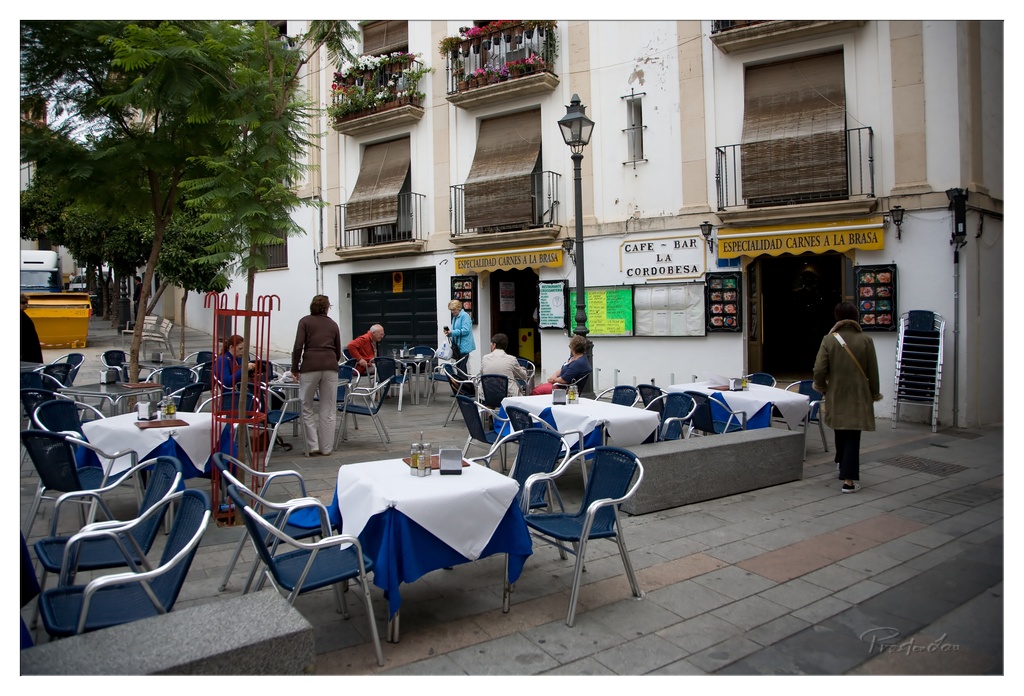

1. Overall Rating (0–10) — 6.8
This photograph captures the quiet charm of a Spanish street café, where daily life unfolds with understated grace. The composition balances human activity with architectural detail, and the soft, diffused light enhances the scene’s natural rhythm. While the image feels authentic and lived-in, it lacks a strong focal point, slightly diminishing its visual impact.
2. Composition (0–10) — 6.5
The frame includes a variety of elements—tables, people, and buildings—creating a layered scene, but the central focus is diffuse. A tighter crop or more deliberate subject placement would improve visual flow and draw the eye more effectively.
3. Lighting (0–10) — 7.0
The overcast sky provides soft, even light that minimizes harsh shadows and enhances texture in the stone pavement and façade. This diffused quality suits the relaxed mood of the café scene, lending it a calm, contemplative atmosphere.
4. Color & Tone (0–10) — 7.0
The palette is grounded in muted earth tones, punctuated by the bold blue and white of the tablecloths, which create a subtle visual rhythm. The colors feel natural and cohesive, with a slight coolness that reflects the lighting conditions.
5. Creativity (0–10) — 6.0
The image presents a slice of everyday life with a documentary sensibility. While it successfully captures the ambiance of the location, it offers little in the way of conceptual innovation or dramatic framing, leaning more toward realism than artistic expression.
6. Technical Quality (0–10) — 7.5
The image is sharp and well-focused, with clean detail in the foreground and background. The lens flare and depth of field are controlled, and the watermark is subtle and unobtrusive.
7. Emotional Impact (0–10) — 6.5
The photograph evokes a sense of peaceful observation, inviting the viewer to pause and imagine the quiet conversations and rituals of the café. While it doesn’t provoke a strong emotional reaction, it effectively conveys a moment of quiet urban life.
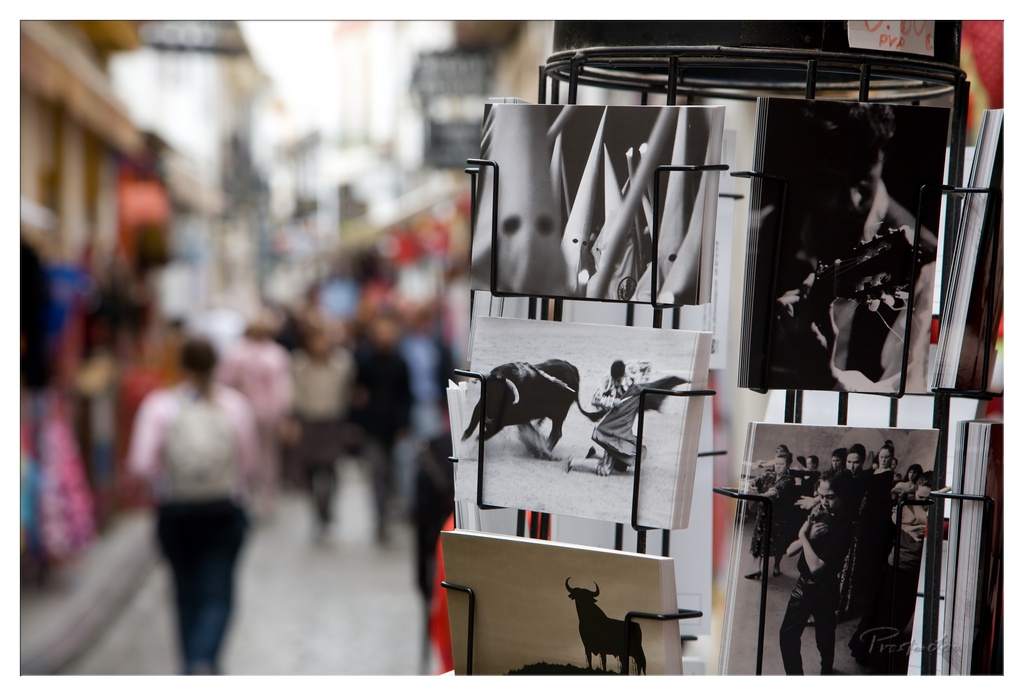

1. Overall Rating (0–10) — 7.0
This photograph captures the vibrant energy of a bustling street market, where the sharp focus on a display of postcards contrasts beautifully with the soft blur of passing pedestrians. The black-and-white imagery on the postcards adds a layer of cultural depth, suggesting themes of tradition and memory. While the shallow depth of field creates a compelling visual hierarchy, the composition feels slightly overburdened by the clutter of the foreground, which risks overwhelming the viewer’s attention.
2. Composition (0–10) — 7.0
The subject is well-placed in the foreground, drawing the eye immediately, while the blurred background provides context without distraction. The diagonal lines of the street and the postcard rack create a dynamic flow, though the composition could benefit from more balanced negative space to enhance visual breathing room.
3. Lighting (0–10) — 6.0
Natural daylight illuminates the scene evenly, with soft shadows suggesting an overcast or midday sky. The lighting is functional and clear, but lacks dramatic contrast or directional warmth, which limits its ability to evoke a stronger mood.
4. Color & Tone (0–10) — 6.5
The overall palette is muted, dominated by neutral tones in the background and the monochrome of the postcards. While the black-and-white images provide visual cohesion, the lack of vibrant color in the environment slightly dampens the scene’s energy and cultural richness.
5. Creativity (0–10) — 7.5
The juxtaposition of the sharp, historical imagery on the postcards against the fleeting motion of the street offers a compelling narrative about memory, tourism, and cultural identity. The selective focus and thematic layering demonstrate a thoughtful approach to storytelling.
6. Technical Quality (0–10) — 7.5
The image is sharp in focus where intended, with clean detail on the postcards and a well-controlled depth of field. The slight grain and noise in the background are acceptable for the lighting conditions, and the overall exposure is balanced.
7. Emotional Impact (0–10) — 6.5
The photograph evokes a sense of quiet observation and nostalgia, inviting the viewer to consider the stories behind the images on display and the lives of the people passing by. While it captures a moment, it doesn’t fully engage the viewer emotionally, remaining more documentary than intimate.
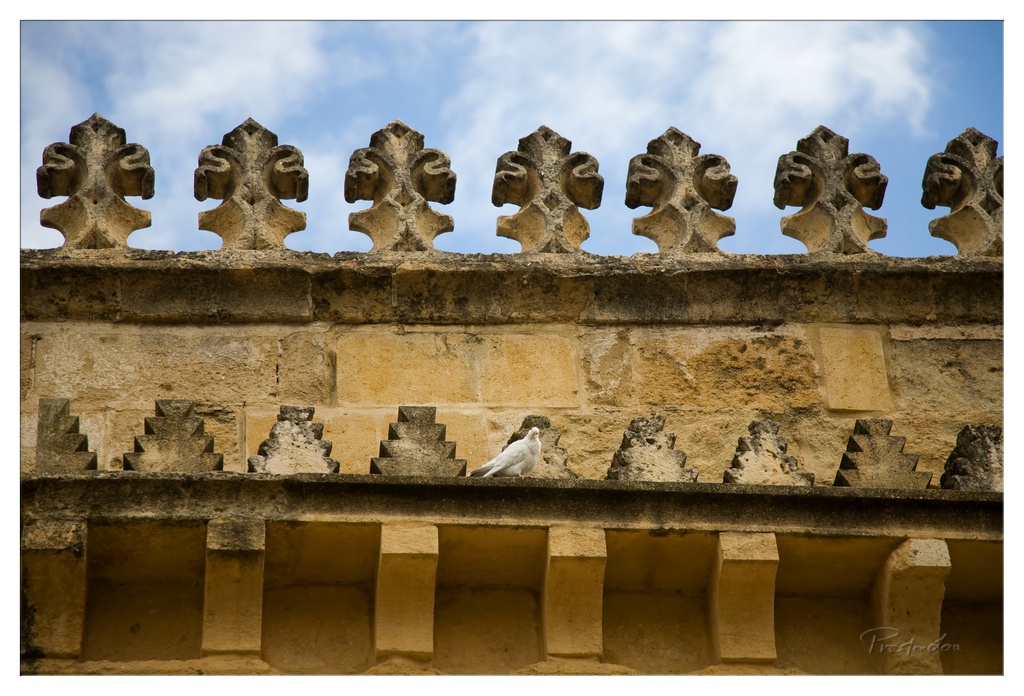

1. Overall Rating (0–10) — 7.5
This photograph captures a serene moment where stillness and history converge, with a lone white dove perched against the weathered grandeur of an ornate stone structure. The juxtaposition of the soft, living bird against the rigid, aged architecture evokes a sense of peace and continuity. While the image is visually striking and rich in texture, the composition's symmetry slightly diminishes the natural spontaneity of the scene.
2. Composition (0–10) — 7.0
The bird is well-placed off-center, creating a balanced yet dynamic focal point. The repeating stone finials form a strong horizontal rhythm, while the architectural layers add depth and structure.
3. Lighting (0–10) — 8.0
Natural daylight highlights the texture of the stone and casts subtle shadows that emphasize the three-dimensional quality of the carvings. The soft clouds diffuse the light, preventing harsh contrasts and enhancing the tranquil mood.
4. Color & Tone (0–10) — 7.5
The warm, golden tones of the stone harmonize beautifully with the bright blue sky and the crisp white of the dove. The contrast between the earthy palette and the vivid sky adds visual interest without overwhelming the scene.
5. Creativity (0–10) — 7.0
The image captures a quiet, poetic moment that blends nature and architecture in a thoughtfully composed frame. The choice to highlight the dove as a symbol of peace within a historic setting adds a subtle layer of meaning.
6. Technical Quality (0–10) — 8.5
The image is sharp and detailed, with excellent focus on the bird and the intricate stonework. The exposure is well-balanced, and the depth of field effectively isolates the subject from the background.
7. Emotional Impact (0–10) — 8.0
The photograph evokes a sense of calm and timelessness, inviting the viewer to reflect on the quiet beauty of moments suspended between the past and present. The dove’s stillness against the ancient stone creates a deeply resonant emotional connection.
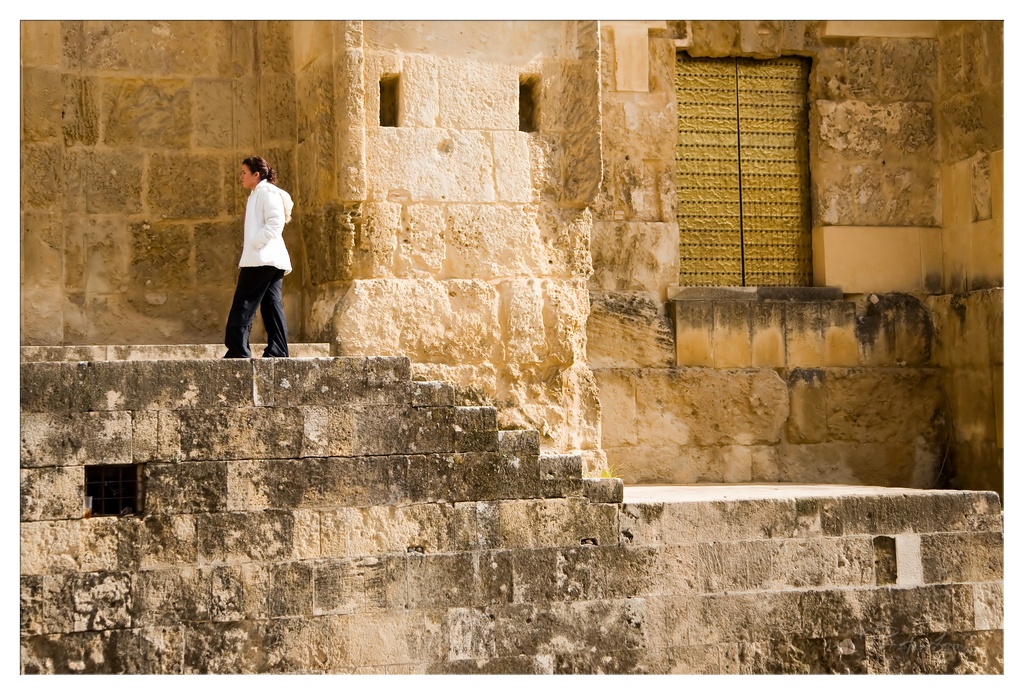

1. Overall Rating (0–10) — 7.0
This photograph captures a quiet moment of solitude within an ancient stone setting, where the interplay of light and texture gives the scene a timeless, contemplative quality. The figure in white provides a striking contrast against the warm, weathered stonework, drawing the eye and suggesting a narrative of passage through history. While the image is strong in mood and composition, it slightly lacks dynamism, holding back from full emotional immersion.
2. Composition (0–10) — 7.5
The subject is placed off-center, following the rule of thirds, which enhances visual balance. The diagonal lines of the steps lead the eye naturally toward the figure, while the surrounding architecture frames the scene effectively, creating depth and a sense of place.
3. Lighting (0–10) — 8.0
Warm, golden light bathes the stone walls, enhancing texture and creating soft shadows that give the image dimension. The light appears to be from late afternoon, casting a gentle glow that accentuates the age and character of the structure.
4. Color & Tone (0–10) — 7.5
The palette is dominated by warm, earthy tones—beiges, ochres, and soft yellows—that harmonize beautifully with the subject’s white jacket. The contrast between the bright white and the muted background is effective, while the tonal range remains rich and cohesive.
5. Creativity (0–10) — 7.0
The image evokes a sense of historical journey and quiet reflection, using the juxtaposition of human presence against ancient architecture to suggest time and memory. While conceptually sound, the approach is somewhat conventional, relying on familiar visual motifs of heritage and solitude.
6. Technical Quality (0–10) — 8.0
The image is sharp and well-focused, with fine detail visible in the stone texture and fabric of the jacket. The exposure is balanced, and there is no noticeable noise or distortion, indicating strong technical execution.
7. Emotional Impact (0–10) — 6.5
The scene conveys a sense of calm and introspection, inviting the viewer to pause and reflect on the passage of time. The solitary figure and aged surroundings evoke a gentle melancholy, though the emotional resonance is subtle rather than overwhelming.
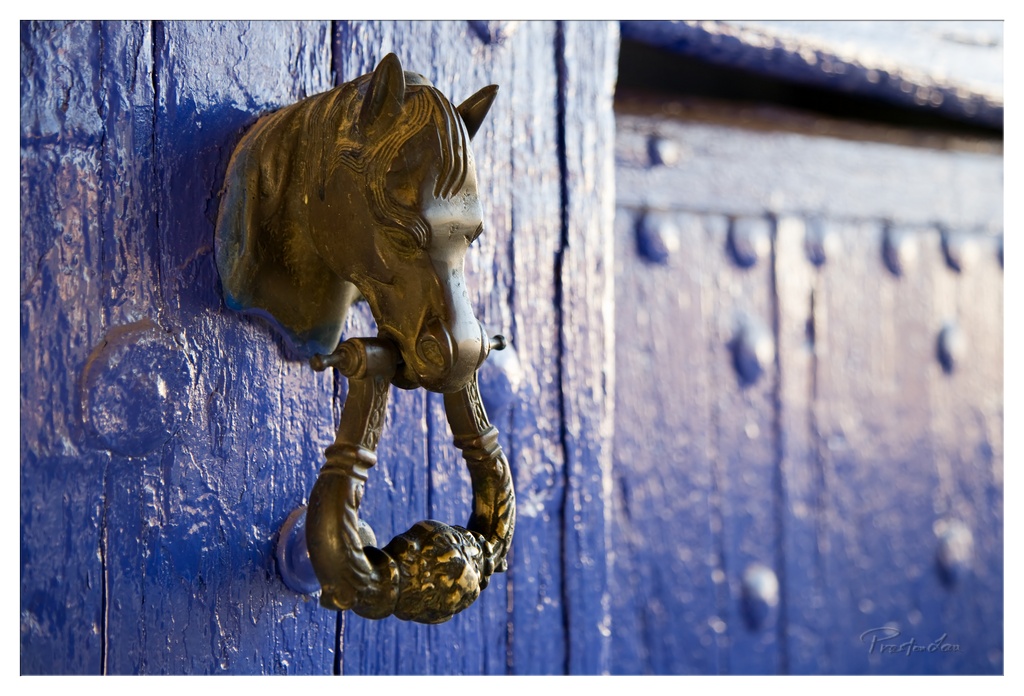

1. Overall Rating (0–10) — 8.0
This photograph captures a striking contrast between the aged patina of a brass horse-head knocker and the vibrant, weathered blue of the wooden door, evoking a sense of history and craftsmanship. The interplay of texture and color gives the image a tactile richness, while the shallow depth of field isolates the knocker as a focal point of narrative and artistry. Though the composition is strong, the lack of a broader context slightly limits its storytelling potential.
2. Composition (0–10) — 8.0
The subject is well-placed off-center, drawing the eye naturally to the knocker while allowing the textured door to serve as a complementary backdrop. The diagonal line of the door’s planks adds subtle dynamism, and the soft blur of the background enhances focus on the intricate details of the knocker.
3. Lighting (0–10) — 7.5
Natural light highlights the metallic sheen of the brass and accentuates the grain and wear of the wood. The direction of light creates soft shadows that enhance texture, though a touch more contrast would deepen the three-dimensionality.
4. Color & Tone (0–10) — 9.0
The rich cobalt blue of the door provides a bold, harmonious backdrop for the warm, tarnished bronze of the knocker. The color palette is both vibrant and balanced, with excellent saturation and tonal depth that enhances the image’s visual appeal.
5. Creativity (0–10) — 8.0
The choice of subject—a horse-head knocker on a weathered blue door—suggests a story rooted in tradition and place. The photographer’s focus on texture and detail transforms a simple architectural element into a poetic, almost anthropomorphic figure.
6. Technical Quality (0–10) — 8.5
Sharp focus on the knocker with a smooth bokeh background demonstrates strong technical control. The image is clear, well-exposed, and shows attention to detail in both the foreground and the subtle gradations of light on the surface.
7. Emotional Impact (0–10) — 7.5
The image evokes a quiet nostalgia and a sense of enduring craftsmanship. The viewer is drawn into a moment of stillness, prompted to wonder about the stories behind the door and the hands that have turned its knocker over time.
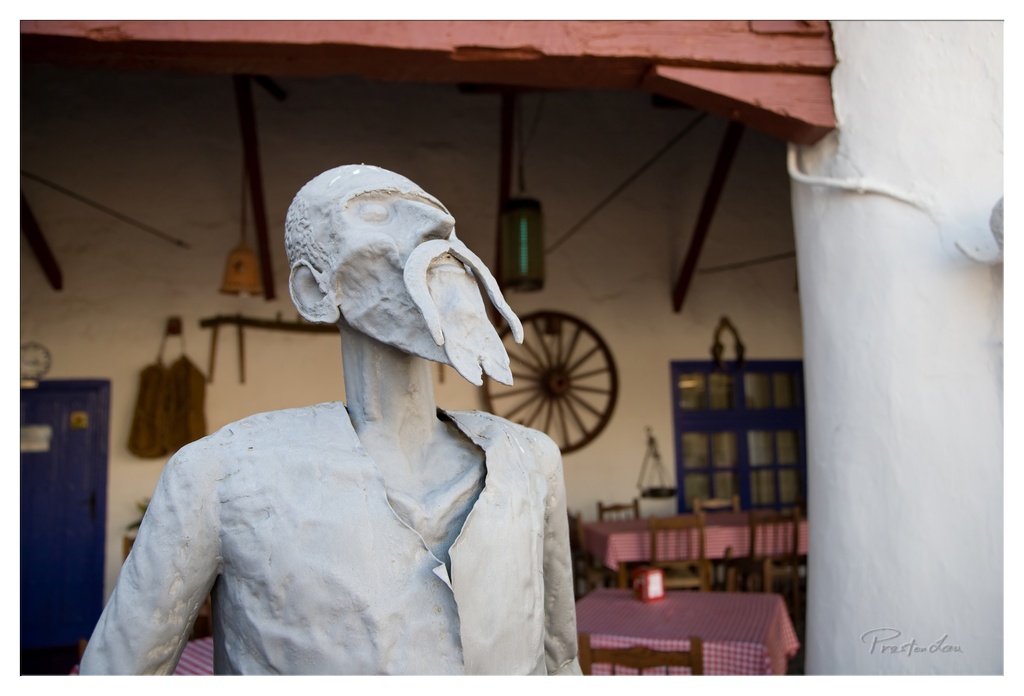

1. Overall Rating (0–10) — 7.0
This photograph captures a striking, almost surreal statue of a bearded man set against the backdrop of a rustic, Mediterranean-style café. The contrast between the weathered, white sculpture and the colorful, lived-in interior creates a compelling visual tension. While the composition draws the eye effectively, the slightly cluttered background and muted lighting prevent the image from achieving greater emotional depth or clarity.
2. Composition (0–10) — 7.5
The statue is well-placed off-center, creating a natural focal point, while the surrounding architectural elements—wooden beams, a wagon wheel, and red-checkered tables—frame the scene organically. The depth of field is used effectively to blur the background, enhancing the prominence of the subject.
3. Lighting (0–10) — 6.0
The lighting is soft and diffused, likely from an overcast sky or late afternoon sun, which minimizes harsh shadows and gives the scene a calm, subdued mood. However, the overall exposure is slightly flat, reducing the richness of textures in both the sculpture and the background.
4. Color & Tone (0–10) — 6.5
The dominant white and cream tones of the statue and walls are balanced by pops of blue and red, particularly in the door and tablecloths. The color palette is harmonious but restrained, with a slight cool cast that slightly dampens the warmth of the scene.
5. Creativity (0–10) — 7.0
The juxtaposition of the abstract, almost alien-like sculpture against a traditional café setting creates a sense of narrative intrigue. The image invites interpretation—perhaps about memory, identity, or cultural displacement—giving it a layered, conceptual quality.
6. Technical Quality (0–10) — 7.5
The focus is sharp on the statue, with a smooth transition into the background blur. The image is clear and well-exposed, with no visible noise or technical flaws, though minor post-processing could enhance contrast and vibrancy.
7. Emotional Impact (0–10) — 6.5
The image evokes a quiet sense of contemplation, with the statue’s expression suggesting introspection or melancholy. While the emotional resonance is present, it remains subtle, relying on the viewer’s interpretation of the scene’s cultural and symbolic context.
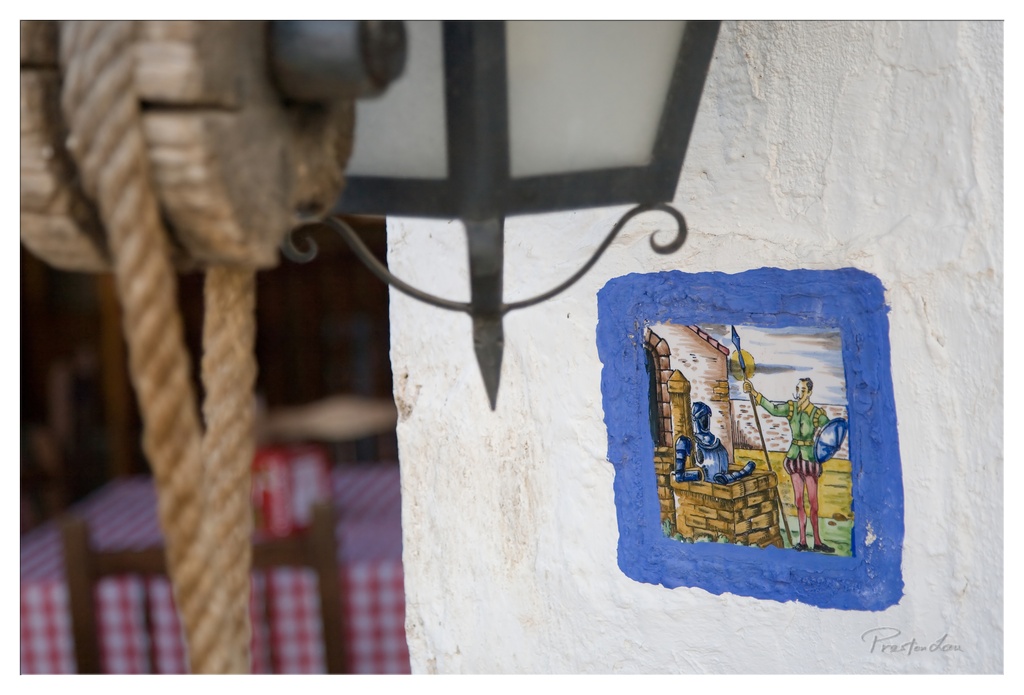

1. Overall Rating (0–10) — 7.0
This photograph captures a quiet, rustic charm through a layered interplay of textures and narrative elements. The painted tile, framed by a bold blue border, tells a story of medieval valor, while the rope and lantern in the foreground ground the scene in tactile realism. The image balances documentary detail with a touch of whimsy, though the shallow depth of field slightly obscures the context of the surrounding space.
2. Composition (0–10) — 7.5
The composition is deliberately layered, with the rope and lantern creating a natural frame that guides the eye toward the painted tile. The off-center placement of the tile adds visual interest, while the blurred background provides depth without distraction.
3. Lighting (0–10) — 6.5
Natural, diffused lighting softens the scene, enhancing the texture of the stucco wall and the painted tile. The lack of harsh shadows contributes to a calm, timeless mood, though the lighting is somewhat flat, limiting dynamic contrast.
4. Color & Tone (0–10) — 7.0
The warm earth tones of the rope and stucco contrast beautifully with the vibrant blue frame and the colorful figures in the tile. The red-and-white checkered tablecloth adds a subtle pop of pattern, reinforcing the rustic atmosphere.
5. Creativity (0–10) — 7.5
The image succeeds in blending storytelling and visual composition, using the painted tile as both a focal point and a narrative device. The juxtaposition of the historical scene with the contemporary setting suggests a rich cultural continuity, elevating the photograph beyond mere documentation.
6. Technical Quality (0–10) — 8.0
Sharp focus on the painted tile ensures clarity of detail, while the controlled depth of field effectively separates the foreground from the background. The image is well-exposed and free from technical flaws.
7. Emotional Impact (0–10) — 6.5
The photograph evokes a sense of nostalgia and quiet storytelling, inviting the viewer to imagine the history behind the tile and the place it represents. While emotionally resonant, the effect is subtle, relying on the viewer’s curiosity to fully engage.
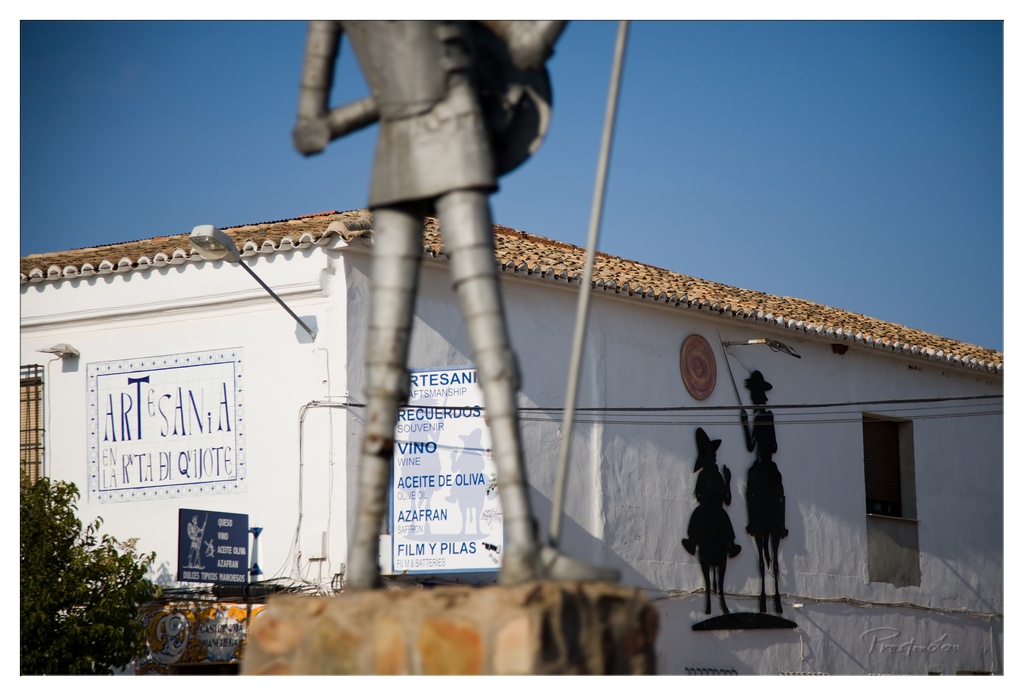

1. Overall Rating (0–10) — 6.0
This photograph captures the essence of a sun-drenched Spanish village, where tradition and commerce blend in a quiet, lived-in scene. The foreground statue introduces a sense of scale and cultural reference, while the signage and silhouettes on the white-washed wall offer narrative clues about local craft and cuisine. Though the image is visually engaging, the shallow depth of field and uneven framing slightly disrupt the harmony, leaving the composition feeling more like a candid moment than a composed statement.
2. Composition (0–10) — 5.5
The statue dominates the frame, creating a strong diagonal that draws the eye, but its partial obscuration and off-center placement disrupt visual balance. The wall signage and silhouettes provide layered context but compete for attention, leading to a cluttered midground.
3. Lighting (0–10) — 7.0
Bright, direct sunlight enhances the crispness of the white walls and casts sharp shadows, emphasizing texture and form. The clear blue sky provides a clean backdrop, though some areas of the building appear overexposed.
4. Color & Tone (0–10) — 6.5
The palette is dominated by the stark contrast between white walls and deep blue sky, punctuated by the dark silhouettes and muted signage colors. While the tones are clear and consistent, the lack of vibrancy in the signage slightly dampens the overall visual energy.
5. Creativity (0–10) — 6.0
The use of the statue as a framing device adds a layer of narrative depth, and the combination of real and symbolic elements—like the silhouettes and product signage—suggests a story of local identity. However, the execution feels observational rather than conceptually driven.
6. Technical Quality (0–10) — 7.5
The image is sharp where focused, with clean detail on the building textures and signage. The focus on the statue creates an intentional depth effect, though the blur in the foreground may distract from the intended subject.
7. Emotional Impact (0–10) — 5.5
The photograph evokes a sense of place—quiet, sunlit, and steeped in tradition—but the distance created by the framing and composition keeps the viewer from fully connecting with the scene’s human warmth.
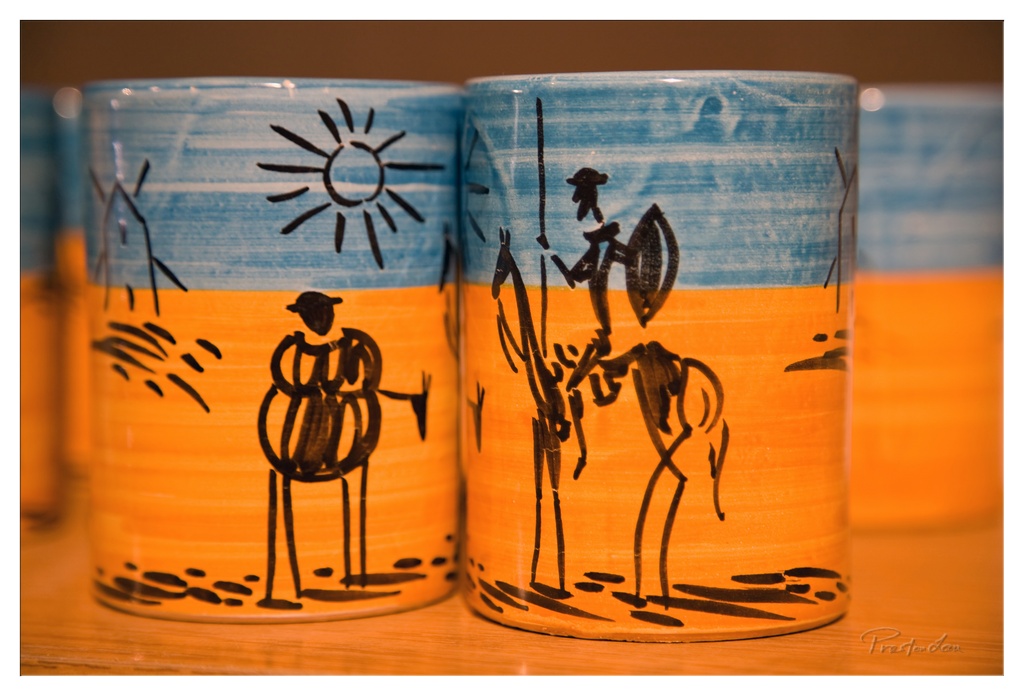

1. Overall Rating (0–10) — 7.5
This photograph captures a charming, handcrafted aesthetic, where ceramic mugs become canvases for a whimsical, folk-art narrative. The bold, stylized figures and vibrant orange-and-blue palette evoke a sense of rustic storytelling, while the shallow depth of field draws focus to the central mugs, enhancing their character. Though the image is visually engaging, the slightly cluttered background and soft focus on the periphery prevent it from achieving a more polished, gallery-ready feel.
2. Composition (0–10) — 7.0
The central mugs are well-framed, with a balanced arrangement that guides the eye across the hand-painted scenes. The use of shallow depth of field effectively isolates the subjects, though the overlapping mugs on the left and right edges create a slight sense of visual crowding.
3. Lighting (0–10) — 6.5
Warm, diffused lighting enhances the earthy tones of the mugs and creates a cozy, inviting atmosphere. However, the light lacks directional definition, resulting in soft shadows and a slightly flat appearance in the background.
4. Color & Tone (0–10) — 8.0
The bold contrast between the warm orange base and the cool blue sky creates a striking visual harmony. The black silhouettes pop against the bright background, giving the image a playful, graphic quality that reinforces its folk-art inspiration.
5. Creativity (0–10) — 8.5
The artist’s choice to depict a pastoral scene—complete with sun, figures, and a horse—on everyday mugs is both imaginative and culturally resonant. The storytelling element elevates the image beyond mere product photography into the realm of visual narrative.
6. Technical Quality (0–10) — 7.5
The focus is sharp on the central mugs, with clear detail in the painted lines. The background is softly blurred, a deliberate artistic choice, though the overall image shows slight softness in the edges of the mugs, likely due to lens quality or focus limitations.
7. Emotional Impact (0–10) — 7.0
The image evokes a sense of warmth, nostalgia, and artisanal pride. The simplicity of the figures and the handcrafted nature of the mugs invite a quiet appreciation for tradition and human touch, making it emotionally relatable and gently uplifting.
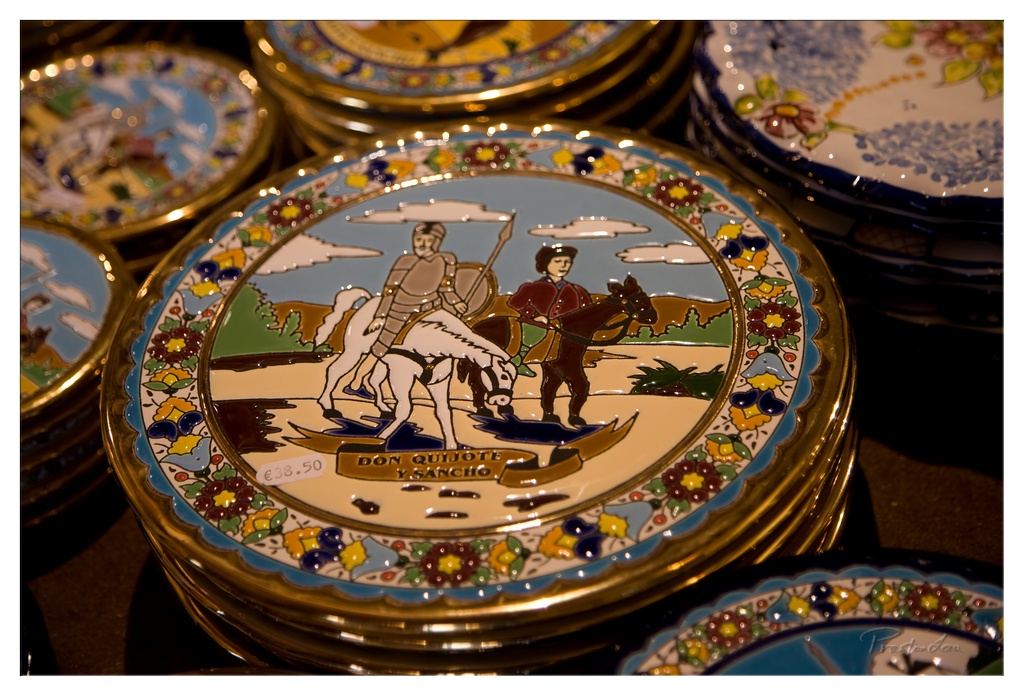

1. Overall Rating (0–10) — 7.5
This photograph captures the rich tradition and craftsmanship of hand-painted ceramic plates, with the central Don Quixote and Sancho Panza motif serving as a vivid cultural anchor. The warm, golden lighting enhances the ornate details and gives the scene a tactile, almost reverent quality. While the composition leans slightly toward clutter, the narrative depth and visual texture make the image compelling, balancing documentary clarity with artistic flair.
2. Composition (0–10) — 6.5
The central plate is well-framed, drawing the eye to the Don Quixote scene, but the surrounding stacked plates create visual noise, slightly overwhelming the focal point. A tighter crop would improve balance and focus.
3. Lighting (0–10) — 8.0
Warm, directional lighting highlights the glossy surface and intricate details of the ceramics, creating a rich, inviting glow that enhances the textures and colors. The shadows add depth and a sense of intimacy.
4. Color & Tone (0–10) — 8.5
The palette is vibrant and harmonious, with rich blues, golds, and earthy tones that evoke a sense of tradition and craftsmanship. The contrast between the bright central scene and the darker background enhances visual interest.
5. Creativity (0–10) — 7.5
The image successfully blends cultural storytelling with aesthetic appeal, using a familiar literary theme to add narrative depth. The choice to focus on a single plate within a larger collection creates a compelling juxtaposition between art and commerce.
6. Technical Quality (0–10) — 8.0
Sharp focus on the central plate, with a shallow depth of field that blurs the background effectively. The image is clear, well-exposed, and shows strong attention to detail.
7. Emotional Impact (0–10) — 7.0
The photograph evokes a sense of nostalgia and appreciation for artisanal heritage, inviting the viewer to reflect on the enduring legacy of Don Quixote in everyday culture. The warmth of the scene fosters a quiet emotional connection.
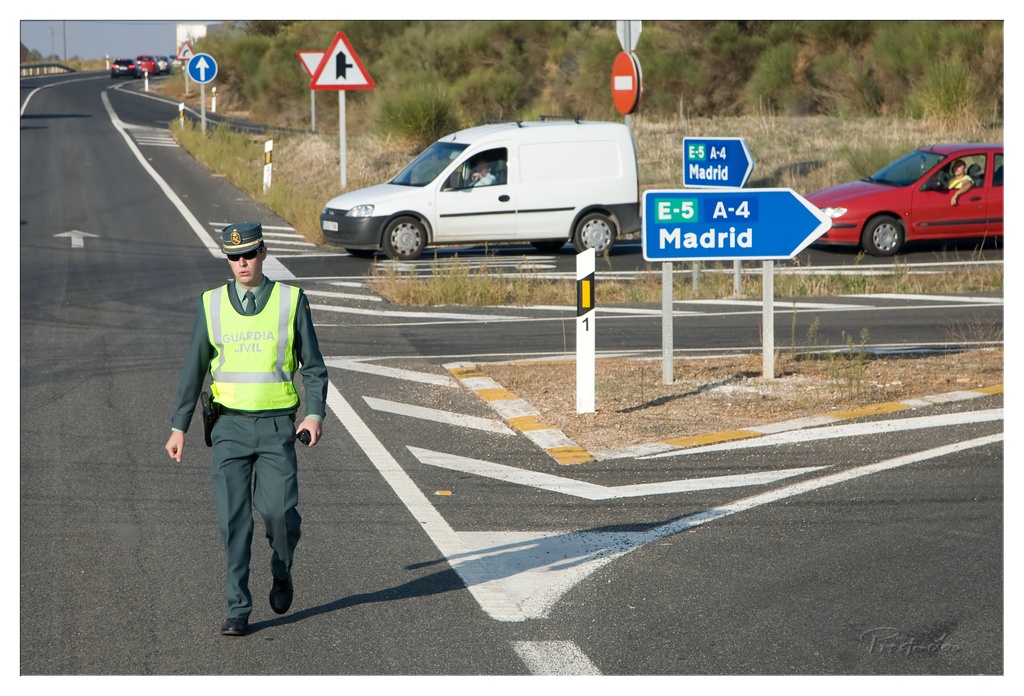

1. Overall Rating (0–10) — 7.0
This photograph captures a moment of quiet authority on a sunlit Spanish highway, where the presence of a Civil Guard officer lends a sense of order to the everyday flow of traffic. The crisp lines of the road markings and the clear signage anchor the scene in a specific, recognizable place—Madrid-bound, yet suspended in a liminal space between motion and stillness. While the image succeeds in documenting a slice of life with clarity and precision, its emotional resonance is slightly muted by the lack of dramatic tension or deeper narrative layering.
2. Composition (0–10) — 7.0
The officer is placed off-center, creating a dynamic diagonal line that leads the eye across the frame, while the converging road lines and directional signs add depth and structure. The inclusion of vehicles and signage grounds the scene in reality, though the composition feels slightly cluttered due to the number of roadside elements.
3. Lighting (0–10) — 8.0
Strong, direct sunlight casts sharp shadows and enhances the texture of the pavement, creating a sense of time and place. The bright, clear light emphasizes the crispness of the uniforms and road markings, contributing to the image’s documentary feel.
4. Color & Tone (0–10) — 7.0
The dominant blues of the road signs and the officer’s reflective vest create a cool, authoritative palette, contrasted by the warm red of the passing car and the earthy tones of the roadside. The colors are vivid but not overly saturated, maintaining a naturalistic tone.
5. Creativity (0–10) — 6.0
The image is observational and documentary in nature, capturing a moment with straightforward clarity. While the subject and setting are familiar, the composition and timing create a sense of narrative, though it remains grounded in realism rather than abstraction or conceptual depth.
6. Technical Quality (0–10) — 8.0
The image is sharp and well-focused, with clean details in both the foreground and background. The exposure is balanced, and the depth of field is appropriate, keeping the officer and the immediate surroundings clear while allowing context to remain visible.
7. Emotional Impact (0–10) — 6.5
The image evokes a sense of calm vigilance and routine, capturing the quiet dignity of duty. While it doesn’t provoke strong emotional reactions, it resonates with viewers familiar with Spanish roads and the role of the Guardia Civil, offering a moment of quiet connection to place and identity.
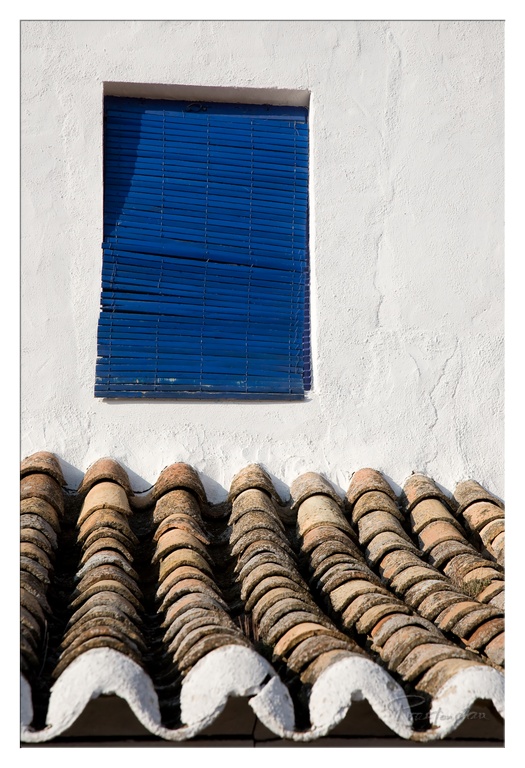

1. Overall Rating (0–10) — 7.5
This photograph captures a quiet Mediterranean stillness, where the contrast between the vibrant blue shutter and the sun-washed white wall creates an immediate visual harmony. The textured roof tiles add a tactile dimension, grounding the image in tradition and place. While the composition is strong and the color palette evocative, the simplicity of the scene borders on minimalism, slightly limiting its narrative depth.
2. Composition (0–10) — 8.0
The frame is tightly composed, with the window centered above the row of curved tiles, creating a balanced, almost architectural symmetry. The strong horizontal lines of the roof and the vertical alignment of the shutter guide the eye naturally, enhancing the image’s structural clarity.
3. Lighting (0–10) — 8.5
Bright, direct sunlight enhances the crispness of the white wall and casts subtle shadows between the tiles, adding depth. The light accentuates the texture of the stucco and the weathered terracotta, while the blue shutter remains vivid without being oversaturated.
4. Color & Tone (0–10) — 8.0
The bold blue of the shutter creates a powerful contrast against the neutral white and warm earth tones of the tiles, producing a visually striking palette. The tonal range is well-balanced, with the dark shadows in the tile crevices adding richness without overpowering the image.
5. Creativity (0–10) — 7.5
The image leverages a classic Mediterranean motif with strong visual appeal, but its strength lies more in formal composition than in original storytelling. The simplicity of the subject allows for quiet contemplation, yet it doesn’t push beyond the expected.
6. Technical Quality (0–10) — 9.0
The image is sharp and well-focused, with fine detail visible in both the wall texture and the tile edges. The exposure is precise, capturing the nuances of light and shadow without loss of detail in highlights or shadows.
7. Emotional Impact (0–10) — 7.0
The photograph evokes a sense of calm and timelessness, reminiscent of sun-drenched villages in southern Europe. Its emotional resonance is subtle, inviting quiet reflection rather than an immediate emotional response.
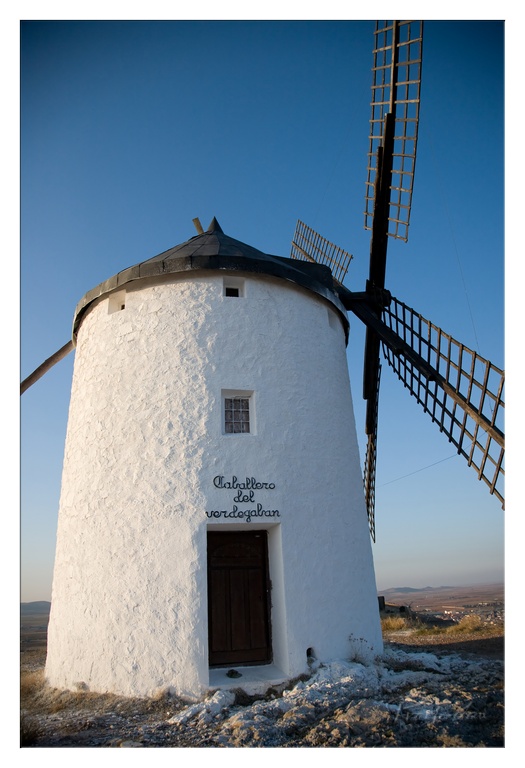

1. Overall Rating (0–10) — 7.5
This photograph captures the timeless elegance of a traditional Spanish windmill, standing solitary against a vast, cloudless sky. The low-angle perspective emphasizes its height and structural grace, while the crisp textures of the whitewashed walls and the dark wooden blades create a striking contrast. Though the image is visually strong, it occasionally feels more like a travel snapshot than a deeply layered narrative, lacking a subtle emotional resonance that would elevate it beyond mere documentation.
2. Composition (0–10) — 8.0
The windmill is centered with a slight offset to the left, allowing the blades to extend dynamically into the frame and create a sense of movement. The expansive sky dominates the upper half, reinforcing the monumentality of the structure, while the distant horizon adds depth and context.
3. Lighting (0–10) — 8.5
The golden hour light bathes the windmill in warm, directional illumination, enhancing the texture of the stucco and casting long, soft shadows. The contrast between the sunlit face and the shaded side adds dimension and drama.
4. Color & Tone (0–10) — 8.0
The palette is simple yet powerful—vibrant cobalt blue against pure white, with earthy browns and muted grays grounding the scene. The tonal range is well-balanced, with rich highlights and deep shadows contributing to a cinematic quality.
5. Creativity (0–10) — 7.5
The image draws on a well-known cultural symbol with a fresh, grounded approach. The choice to highlight the windmill’s inscription and its isolated setting adds narrative depth, suggesting a connection to place and heritage.
6. Technical Quality (0–10) — 9.0
The photograph is sharp and detailed, with excellent focus on the windmill’s surface and clear definition in the background. The exposure is well-managed, preserving detail in both highlights and shadows.
7. Emotional Impact (0–10) — 7.0
There is a quiet dignity in the image—the stillness of the windmill, the vastness of the landscape, and the sense of history all combine to evoke a contemplative mood. While it doesn’t stir strong emotion, it invites reflection on time, tradition, and solitude.
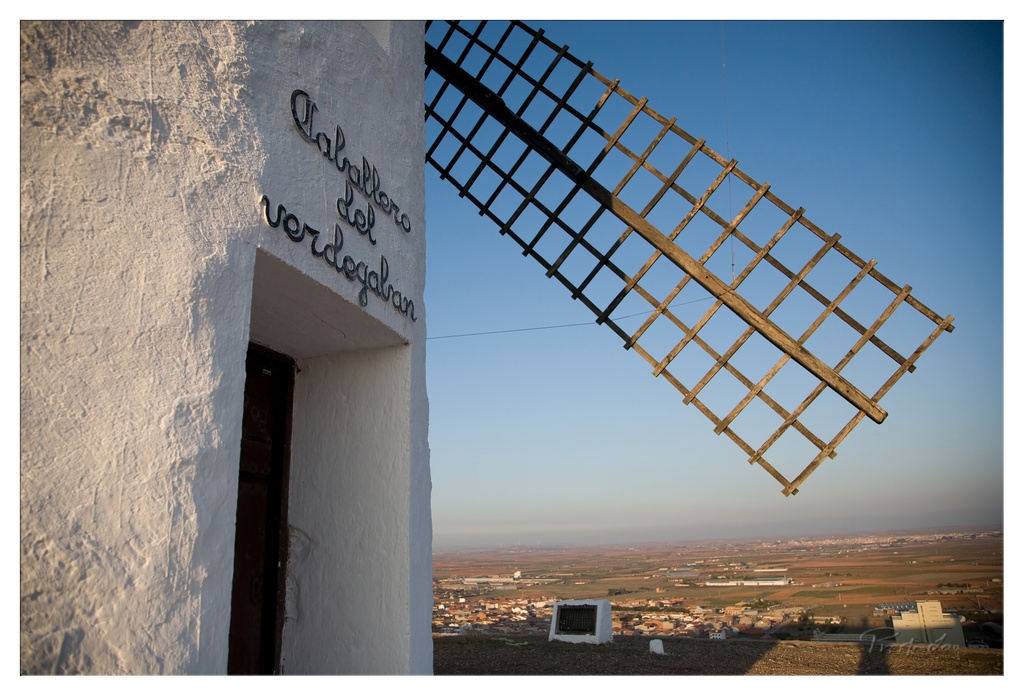

1. Overall Rating (0–10) — 7.5
This photograph captures the timeless elegance of a traditional Spanish windmill, blending cultural heritage with a sweeping landscape. The interplay of light and shadow on the white stucco wall enhances the texture and age of the structure, while the diagonal sweep of the wooden blades adds dynamic energy. Though the composition is strong, the expansive view slightly dilutes the focus, leaving the viewer with a sense of scale rather than intimacy.
2. Composition (0–10) — 7.0
The strong diagonal of the windmill’s blades contrasts effectively with the vertical line of the building, creating visual tension and guiding the eye across the frame. The inclusion of the distant town grounds the image, but the wide horizon slightly weakens the focus on the primary subject.
3. Lighting (0–10) — 8.0
The soft, golden light of late afternoon casts long shadows and highlights the texture of the wall, enhancing the image’s warmth and depth. The clear sky and directional sunlight create a balanced exposure that accentuates the structure’s form without overexposing the background.
4. Color & Tone (0–10) — 7.5
The warm tones of the sunlit wall contrast beautifully with the cool blue of the sky, creating a harmonious and natural palette. The earthy hues of the landscape below complement the scene, though the overall color range remains restrained, lending a subdued and contemplative mood.
5. Creativity (0–10) — 7.0
The photograph successfully blends documentary realism with artistic composition, capturing a moment that feels both personal and universal. The choice to frame the windmill in this way—partially obscured, with a sweeping view—suggests a narrative of memory and place, though it could be more visually striking with bolder tonal contrasts.
6. Technical Quality (0–10) — 8.5
The image is sharp and well-focused, with excellent clarity in the textures of the stucco and wooden lattice. The exposure is clean, and the depth of field is appropriately managed, keeping both the foreground and distant landscape in view without loss of detail.
7. Emotional Impact (0–10) — 7.5
There is a quiet nostalgia in the image, evoked by the weathered windmill and the vast, open landscape. The sense of stillness and solitude resonates deeply, inviting reflection on tradition, time, and the relationship between people and the land.
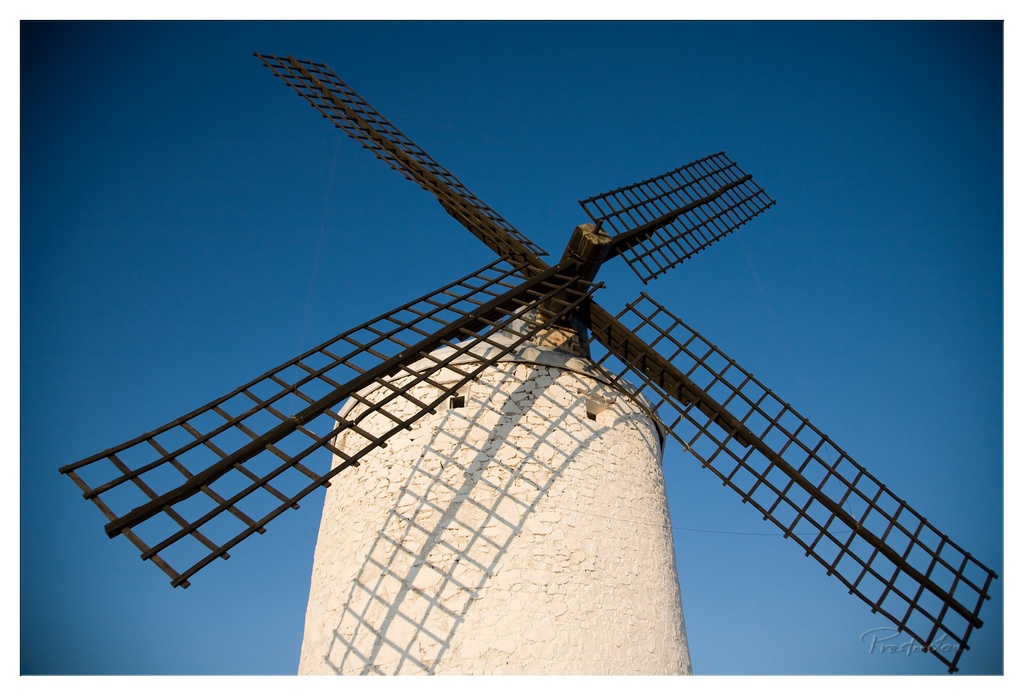

1. Overall Rating (0–10) — 8.0
This photograph captures the timeless elegance of a traditional windmill against a vast, deep blue sky, evoking a sense of quiet grandeur and historical resonance. The low-angle perspective emphasizes the structure’s verticality and the bold geometric rhythm of its lattice blades, while the crisp contrast between the white tower and the rich blue background lends a painterly quality. The image succeeds in merging architectural detail with atmospheric simplicity, though a subtle vignette effect slightly softens the natural vibrancy of the scene.
2. Composition (0–10) — 8.5
The low-angle shot creates a powerful sense of scale, with the windmill’s blades radiating outward and framing the top of the tower. The diagonal lines of the sails lead the eye dynamically across the frame, while the central placement of the structure provides a strong focal point, balanced by the expansive negative space of the sky.
3. Lighting (0–10) — 8.0
The warm, directional sunlight highlights the textured surface of the white tower and casts sharp, defined shadows from the blades, adding depth and dimension. The contrast between the illuminated areas and the shaded sections enhances the three-dimensional form, while the clear sky suggests a crisp, sunny day.
4. Color & Tone (0–10) — 8.5
The rich, saturated blue of the sky creates a striking complementary contrast with the off-white of the windmill, producing a visually harmonious and balanced palette. The tones are clean and well-graded, with a subtle warmth on the tower enhancing its organic texture.
5. Creativity (0–10) — 8.0
The choice of a low-angle perspective and the emphasis on geometric patterns transform a familiar subject into a visually compelling composition. The interplay of light, shadow, and form gives the image a contemplative, almost sculptural quality, elevating it beyond simple documentation.
6. Technical Quality (0–10) — 9.0
The image is sharp and well-focused, with excellent clarity in both the windmill’s textured surface and the fine details of the blade lattice. The exposure is well-balanced, and the vignette is applied subtly to draw attention to the center without compromising natural tonal transitions.
7. Emotional Impact (0–10) — 7.5
The photograph evokes a sense of nostalgia and awe, capturing the quiet dignity of a historic structure standing against the sky. It invites reflection on time, tradition, and the beauty of simple, enduring forms, though its emotional resonance is more contemplative than deeply moving.
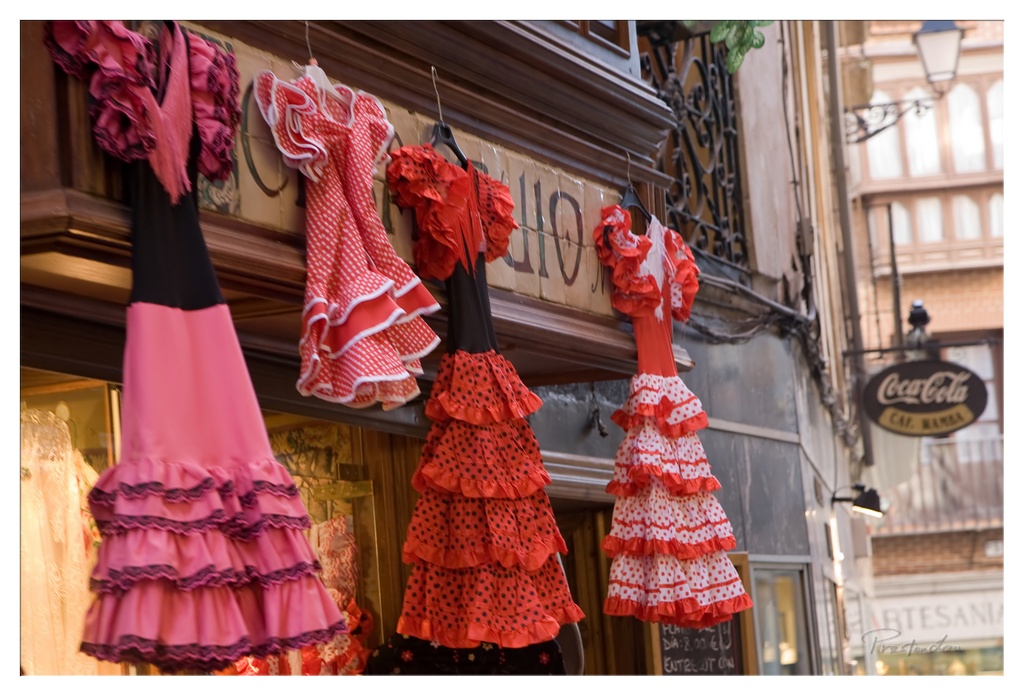

1. Overall Rating (0–10) — 7.0
This photograph captures the vibrant spirit of a traditional Spanish dress shop, where flamenco dresses hang like colorful banners against a weathered urban backdrop. The rich textures and layered ruffles create a dynamic visual rhythm, while the soft focus and warm lighting lend a nostalgic, almost cinematic quality. The scene feels authentic and alive, though the cluttered background slightly distracts from the elegance of the garments.
2. Composition (0–10) — 6.5
The dresses are arranged diagonally, creating a strong visual flow from left to right. However, the inclusion of the Coca-Cola sign and surrounding architecture introduces visual noise, pulling focus from the main subject.
3. Lighting (0–10) — 7.0
Natural, diffused daylight highlights the folds and colors of the dresses, while the soft shadows add depth. The warm tone enhances the cultural warmth of the scene, though the highlights on the right edge appear slightly overexposed.
4. Color & Tone (0–10) — 8.0
The bold reds, pinks, and whites of the flamenco dresses pop against the muted earth tones of the building. The color palette is rich and harmonious, evoking the passion and tradition associated with Spanish culture.
5. Creativity (0–10) — 7.0
The juxtaposition of traditional attire against a modern urban setting offers a compelling narrative. The use of selective focus emphasizes the dresses as cultural symbols, blending documentary realism with artistic intent.
6. Technical Quality (0–10) — 7.5
Sharp focus on the foreground dresses contrasts with a softly blurred background, creating effective depth of field. The image is clean and well-exposed, with minimal noise despite the low-light conditions.
7. Emotional Impact (0–10) — 7.5
The image evokes a sense of cultural pride and timeless artistry, inviting the viewer to imagine the music, dance, and stories behind the dresses. There’s a quiet warmth that connects the viewer to a moment suspended in time.
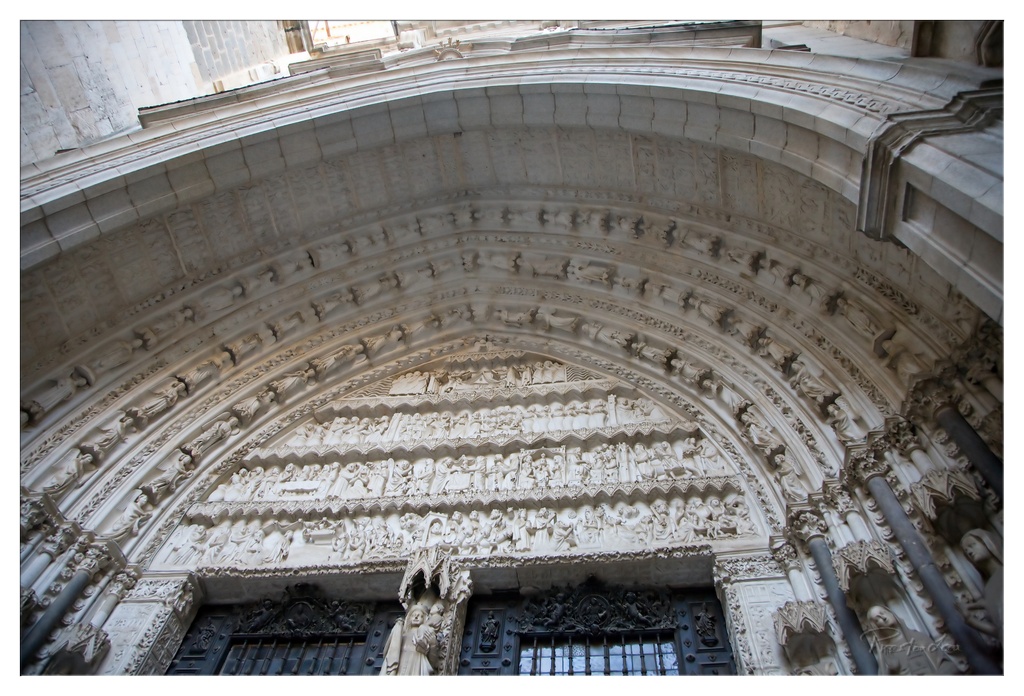

1. Overall Rating (0–10) — 7.5
This photograph captures the grandeur and intricate artistry of a Gothic cathedral portal, where centuries of craftsmanship converge in stone. The low-angle perspective emphasizes the monumentality of the architecture, while the dense carvings tell stories of faith and history. Though the image is rich in detail, the slightly muted lighting and overexposed highlights in the upper arch slightly diminish the dramatic impact, leaving room for greater tonal depth.
2. Composition (0–10) — 8.0
The low-angle, centered framing draws the eye upward along the arch, emphasizing the verticality and symmetry of the structure. The placement of the dark doorway at the base grounds the image, creating a strong visual anchor, though the inclusion of the upper-left corner feels slightly unbalanced.
3. Lighting (0–10) — 6.5
Natural light illuminates the facade from above, casting subtle shadows that highlight the depth of the carvings. However, the upper arch is slightly overexposed, washing out fine details, while the lower portion remains underlit, creating uneven contrast.
4. Color & Tone (0–10) — 7.0
The monochromatic palette of pale stone and dark iron creates a timeless, somber mood. The tonal range is well-defined, though the lack of warm or cool color cast lends a neutral, almost clinical quality to the image.
5. Creativity (0–10) — 7.5
The choice to frame the portal from below adds a sense of reverence and awe, transforming a structural detail into a narrative of human devotion. The focus on architectural storytelling elevates the image beyond mere documentation.
6. Technical Quality (0–10) — 8.0
The image is sharp and detailed, especially in the mid-ground carvings. The focus is precise across the central arch, though minor softness appears in the extreme foreground and background edges.
7. Emotional Impact (0–10) — 7.0
The photograph evokes a sense of quiet reverence and historical continuity, inviting contemplation of the artisans and worshippers who passed through this doorway. The emotional resonance lies in the weight of time and craftsmanship, though the flat lighting tempers the full emotional weight.
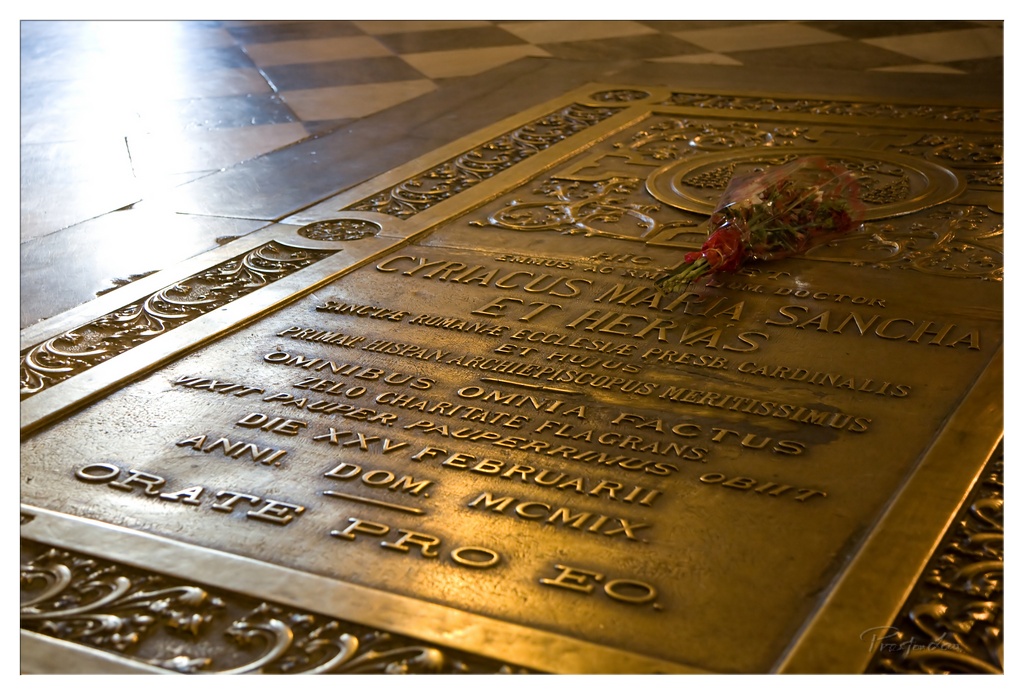

1. Overall Rating (0–10) — 7.5
This photograph captures a solemn and reverent moment at a memorial plaque, where history and devotion converge in quiet dignity. The warm, golden light enhances the texture of the brass and the delicate bouquet, evoking a sense of enduring respect. While the image is rich in detail and emotional weight, the composition’s slight imbalance and overexposed corner detract from its overall harmony.
2. Composition (0–10) — 6.5
The diagonal angle of the plaque creates a dynamic entry into the frame, but the bright reflection in the upper left disrupts visual flow. The placement of the bouquet slightly off-center adds a naturalistic touch, though the composition could benefit from tighter framing to emphasize the inscription.
3. Lighting (0–10) — 8.0
Soft, directional light enhances the three-dimensional quality of the embossed text and ornamentation, creating a warm, almost sacred glow. The contrast between the illuminated plaque and the darker surroundings draws the eye naturally to the focal point.
4. Color & Tone (0–10) — 7.5
The rich golden tones of the brass dominate the palette, complemented by the deep reds and greens of the flowers. The monochromatic warmth supports the solemn mood, though the overexposed highlight slightly disrupts tonal balance.
5. Creativity (0–10) — 7.0
The choice to include the bouquet introduces a human element, transforming a static monument into a living tribute. The low-angle perspective lends intimacy, inviting the viewer to reflect on the significance of the memorial.
6. Technical Quality (0–10) — 8.0
Sharp focus on the inscription ensures legibility, and the depth of field effectively isolates the plaque from the background. The image is well-executed in terms of clarity and detail.
7. Emotional Impact (0–10) — 8.0
The combination of the inscription, the delicate flowers, and the warm lighting evokes a powerful sense of remembrance and reverence. It resonates with quiet dignity, drawing the viewer into a moment of contemplation.
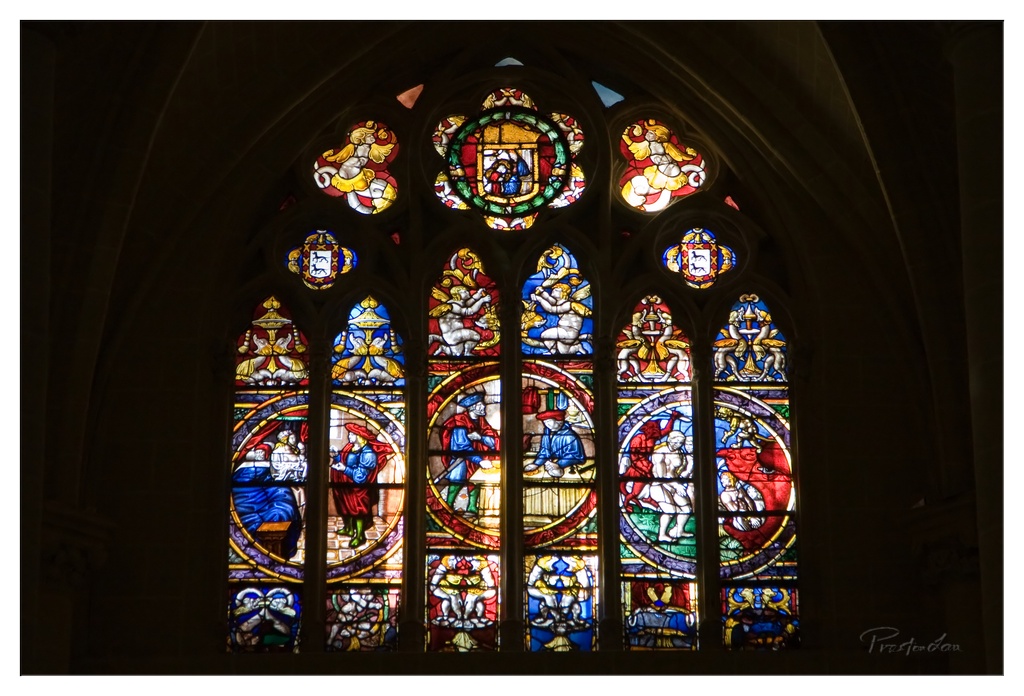

1. Overall Rating (0–10) — 8.0
This photograph captures the transcendent beauty of a stained glass window, where light and color converge to evoke a sense of reverence and timelessness. The interplay of radiant hues against the shadowed stone arch creates a striking contrast, drawing the viewer into a contemplative space. While the image is rich in visual and spiritual resonance, the slightly uneven exposure in the upper corners tempers its overall polish.
2. Composition (0–10) — 8.5
The central placement of the stained glass window within the arched frame creates a strong focal point, emphasizing symmetry and verticality. The surrounding darkness enhances the window’s presence, while the arch’s curve guides the eye naturally toward the intricate details. The composition feels balanced and intentional, allowing the viewer to absorb the narrative and artistry of the glass.
3. Lighting (0–10) — 8.0
Natural light filters through the stained glass, casting colorful, dynamic patterns that animate the scene. The contrast between the illuminated glass and the deep shadows of the cathedral interior enhances depth and drama. While some areas of the window are overexposed, the overall effect is luminous and atmospheric, capturing the sacred glow of light filtering through art.
4. Color & Tone (0–10) — 9.0
The palette is vibrant and rich, with deep blues, reds, and golds that pulse with life. The interplay of light and color creates a luminous quality, evoking the spiritual essence of the space. The tonal range is well-managed, with the darker surroundings allowing the hues of the glass to stand out dramatically.
5. Creativity (0–10) — 8.0
The photograph transcends mere documentation by emphasizing the emotional and symbolic power of the stained glass. The choice to frame the window within the architectural context adds layers of meaning, suggesting a dialogue between art, faith, and space. The image feels both reverent and artistically intentional.
6. Technical Quality (0–10) — 7.5
The image is sharp and detailed, capturing the fine lines and textures of the glasswork. However, slight overexposure in the upper sections and a minor loss of detail in the darkest areas suggest a challenge in balancing exposure across the dynamic range. The focus is consistent, and the clarity is strong throughout.
7. Emotional Impact (0–10) — 9.0
The photograph evokes a profound sense of awe and serenity, inviting the viewer to pause and reflect. The interplay of light, color, and shadow creates a meditative atmosphere, resonating with themes of faith, history, and beauty. It succeeds in capturing not just a scene, but a moment of spiritual contemplation.
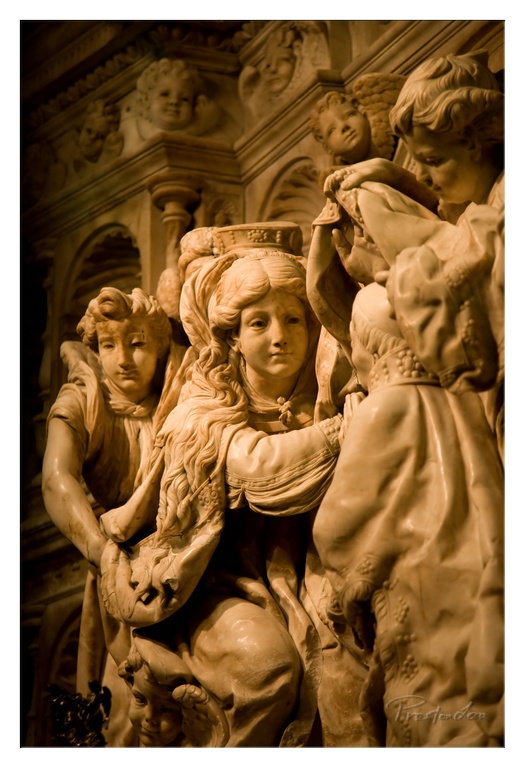

1. Overall Rating (0–10) — 8.0
This photograph captures the solemn grace of a Baroque marble sculpture, where intricate detail and emotional depth converge under a warm, hushed glow. The interplay of light and shadow accentuates the fluid drapery and expressive faces, evoking a sense of reverence and narrative weight. While the tight framing slightly restricts context, the image succeeds in conveying the sculpture’s artistry and spiritual intensity with quiet elegance.
2. Composition (0–10) — 7.5
The central figure is well-placed, drawing the eye through the dynamic arrangement of surrounding figures. The diagonal flow of the composition adds movement, though the tight crop leaves some sculptural elements partially obscured.
3. Lighting (0–10) — 8.5
The directional, warm lighting creates dramatic chiaroscuro, enhancing the three-dimensionality of the marble and casting deep shadows that emphasize texture and form. The lighting feels intentional and evocative, enhancing the devotional mood.
4. Color & Tone (0–10) — 8.0
The sepia-toned warmth unifies the composition and reinforces the historical and sacred atmosphere. The monochromatic palette, while limiting color variety, adds a timeless quality and enhances tonal contrast.
5. Creativity (0–10) — 8.0
The photographer transforms a static sculpture into a narrative moment through careful lighting and framing. The choice to emphasize mood over documentation shows strong artistic intent and a clear vision.
6. Technical Quality (0–10) — 8.5
The image is sharp and detailed, with excellent focus on the central subject and smooth tonal transitions. The lighting control and exposure are precise, preserving fine textures in the marble.
7. Emotional Impact (0–10) — 8.5
The image evokes a profound sense of contemplation and solemn beauty, inviting the viewer to reflect on the story and emotion embedded in the sculpture. The combination of light, composition, and subject matter creates a deeply moving and immersive experience.
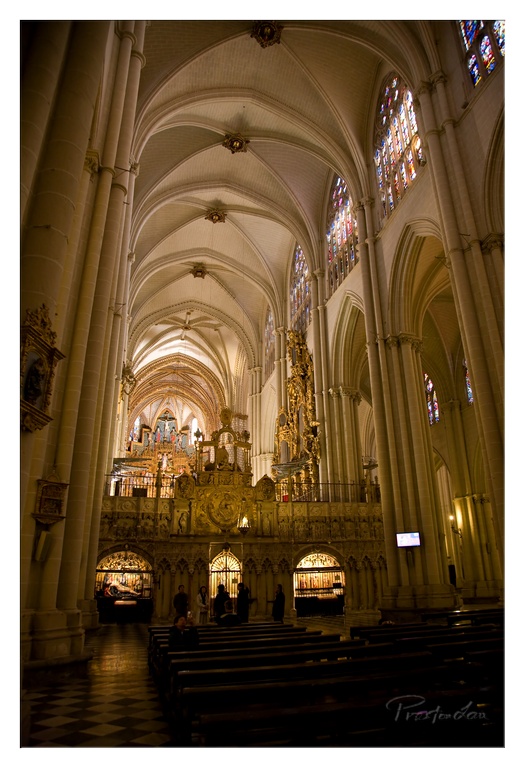

1. Overall Rating (0–10) — 8.0
This photograph captures the awe-inspiring grandeur of a Gothic cathedral interior, where soaring arches and intricate stonework evoke centuries of devotion. The warm, golden light filtering through the stained glass enhances the sacred atmosphere, while the presence of visitors grounds the scene in human scale and time. While the composition leans slightly toward conventional symmetry, it effectively conveys the cathedral’s architectural majesty and spiritual depth.
2. Composition (0–10) — 7.5
The symmetrical framing emphasizes the cathedral’s verticality and leading lines, drawing the eye toward the ornate altar. A slight imbalance in the lower-left foreground introduces subtle visual distraction, but the overall structure remains strong and cohesive.
3. Lighting (0–10) — 8.5
The interplay of natural light from the stained glass and ambient interior illumination creates a rich, layered glow. Warm tones highlight the texture of the stone and gold accents, while deep shadows add drama and depth.
4. Color & Tone (0–10) — 8.0
The palette blends warm golds, soft whites, and the vibrant hues of the stained glass, creating a harmonious and reverent atmosphere. The contrast between light and shadow enhances the tonal richness without overpowering the scene.
5. Creativity (0–10) — 7.0
While the subject is inherently dramatic, the photograph remains grounded in realism, with a focus on capturing the space as it exists. The inclusion of visitors adds a narrative layer, but the approach is more documentary than interpretive.
6. Technical Quality (0–10) — 8.5
The image is sharp and well-exposed, with excellent detail in both the illuminated areas and the darker recesses. The focus is consistent throughout, and the depth of field effectively renders the space with clarity.
7. Emotional Impact (0–10) — 8.5
The photograph evokes a profound sense of reverence and timelessness, inviting the viewer to feel the quiet contemplation and historical weight of the cathedral. The combination of light, scale, and human presence creates a deeply resonant and meditative experience.
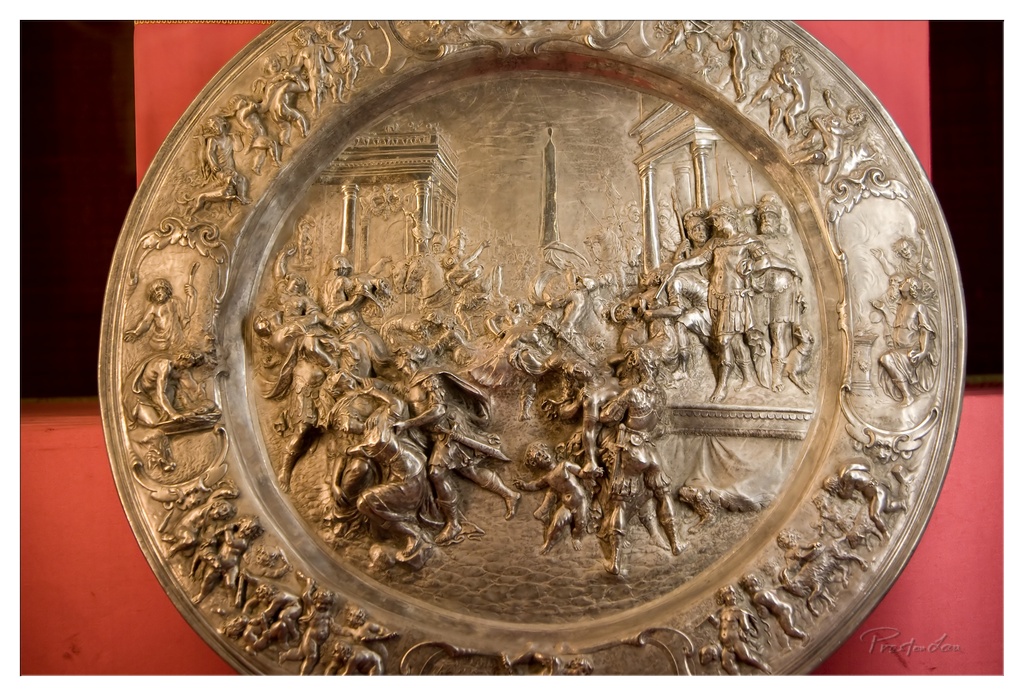

1. Overall Rating (0–10) — 8.0
This photograph captures the intricate grandeur of a silver relief plate with remarkable clarity, allowing the viewer to appreciate both the craftsmanship and narrative depth of the scene. The contrast between the metallic sheen and the deep red backdrop enhances the sculpture’s three-dimensional quality, giving it a sense of regal presence. While the composition is strong, the image’s emotional resonance is slightly restrained by the lack of dynamic lighting, which keeps the focus more on documentation than evocation.
2. Composition (0–10) — 8.0
The circular frame of the plate is centered effectively, drawing the eye to the central narrative scene. The surrounding decorative elements create a harmonious border, and the red background provides a rich, unobtrusive contrast that enhances the plate’s prominence without overwhelming it.
3. Lighting (0–10) — 7.5
The lighting is directional and soft, highlighting the relief’s texture and depth without creating harsh shadows. The gentle play of light across the metallic surface emphasizes the sculptural quality, though a slightly warmer tone could have added more warmth and drama to the scene.
4. Color & Tone (0–10) — 8.0
The rich, warm red of the background provides a bold contrast to the cool, silvery tones of the plate, creating a visually striking palette. The tonal range is well-balanced, with subtle gradations in the metal’s surface adding depth and complexity.
5. Creativity (0–10) — 7.5
The image successfully captures a historical object in a way that feels both reverent and artistically composed. The choice to frame the piece against a vibrant red backdrop adds a modern touch, elevating it beyond a simple archival photograph into a stylized portrayal.
6. Technical Quality (0–10) — 8.5
The image is sharp and detailed, with precise focus on the intricate carvings. The depth of field is well-controlled, ensuring that the central figures are clear while still allowing the surrounding details to remain visible.
7. Emotional Impact (0–10) — 7.0
The photograph conveys a sense of awe and reverence for the craftsmanship and historical significance of the piece. While the emotional pull is subtle, the viewer is invited to contemplate the story etched into the metal, evoking curiosity and admiration.
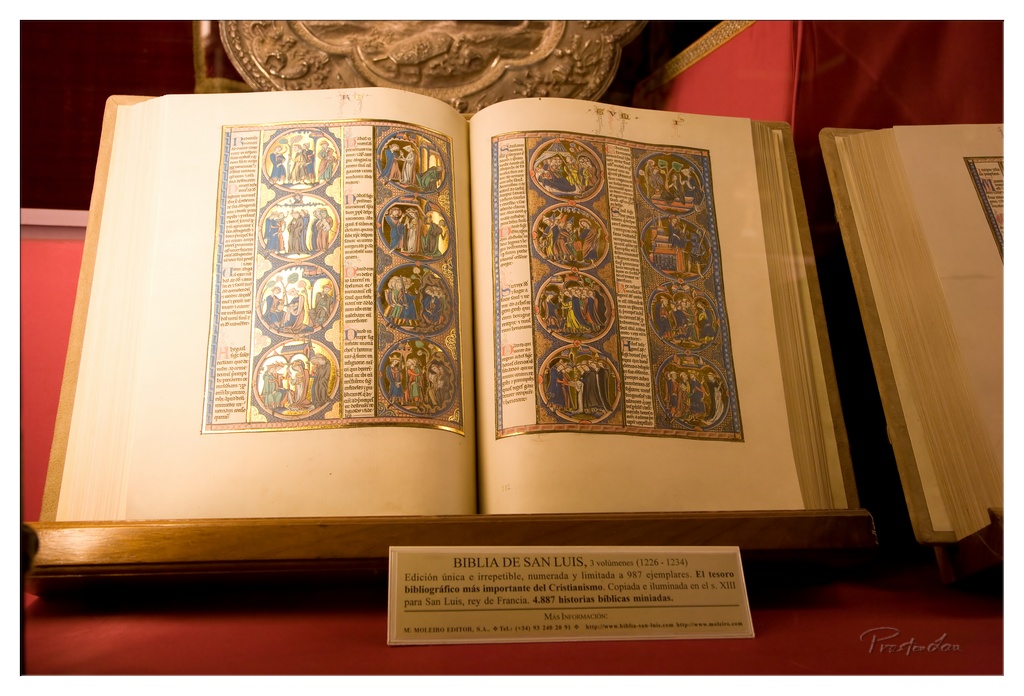

1. Overall Rating (0–10) — 7.5
This photograph captures the solemn grandeur of a medieval manuscript, its illuminated pages glowing under warm, focused light that accentuates the intricate details of the illustrations. The display setting enhances the book’s historical weight, inviting reverence for its craftsmanship. While the image effectively conveys the artifact’s richness, a more deliberate framing and depth of field could further elevate its visual storytelling.
2. Composition (0–10) — 7.0
The book is centered and framed to highlight both pages, with the plaque adding context below. The slight tilt and off-center placement of the second book on the right create a subtle asymmetry, but the overall balance is strong and draws the eye to the manuscript’s artistry.
3. Lighting (0–10) — 8.0
Warm, directional lighting enhances the golden hues of the illuminations and casts a soft glow on the aged parchment, creating depth and emphasizing texture. The shadows are controlled, preserving detail without overpowering the subject.
4. Color & Tone (0–10) — 7.5
The dominant warm palette—gold, ochre, and deep blue—complements the historical nature of the manuscript, while the red backdrop provides a rich contrast. The tones are harmonious and evoke a sense of antiquity and reverence.
5. Creativity (0–10) — 7.0
The image successfully blends documentation with aesthetic appeal, capturing both the artifact and its emotional resonance. The choice to include the plaque grounds the image in context, but the approach is more observational than interpretive.
6. Technical Quality (0–10) — 8.0
Sharp focus on the illuminated pages, clean detail, and well-managed exposure demonstrate strong technical control. The slight reflection on the glass case is minimal and does not detract significantly.
7. Emotional Impact (0–10) — 7.5
The image evokes awe and quiet contemplation, connecting the viewer to the historical and spiritual significance of the manuscript. The warmth of the light and the richness of the details foster a sense of intimacy with a treasured cultural artifact.
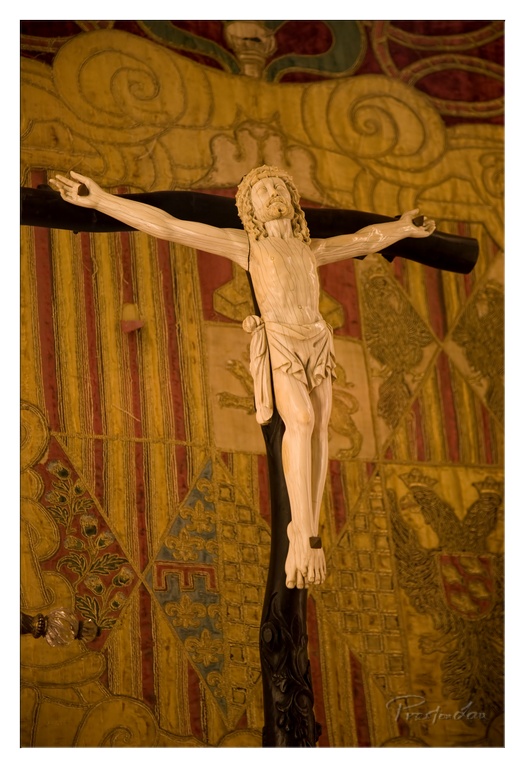

1. Overall Rating (0–10) — 7.5
This photograph captures a solemn and reverent portrayal of a crucifixion sculpture, with the figure of Christ rendered in fine detail against a richly patterned, tapestry-like backdrop. The warm, golden lighting enhances the sacred atmosphere, giving the image a painterly quality that evokes both devotion and historical depth. While the composition is strong and the subject compelling, the slightly cluttered background risks distracting from the central figure, slightly diminishing the image’s emotional clarity.
2. Composition (0–10) — 7.0
The crucifix is centered with strong vertical alignment, drawing the eye directly to the figure of Christ. However, the ornate background, while visually engaging, introduces competing patterns that slightly disrupt the focus. A more restrained background would better emphasize the subject’s spiritual gravity.
3. Lighting (0–10) — 8.0
The warm, directional lighting enhances the three-dimensionality of the sculpture, casting soft shadows that accentuate its contours. The golden glow contributes to a devotional mood, creating a sense of reverence and timelessness that complements the religious subject.
4. Color & Tone (0–10) — 7.5
The palette is dominated by warm golds, deep reds, and earthy tones, creating a harmonious and historically resonant atmosphere. The tonal contrast between the pale sculpture and the richly colored background adds visual depth, though the saturated hues verge on overwhelming at times.
5. Creativity (0–10) — 7.0
The image blends religious iconography with a painterly aesthetic, presenting the crucifix not merely as an artifact but as a focal point of spiritual narrative. The choice to frame the sculpture within a tapestry-like setting adds a layer of storytelling, suggesting cultural and historical context.
6. Technical Quality (0–10) — 8.0
The photograph is sharp and detailed, with precise focus on the crucifix. The lighting and exposure are well-controlled, preserving the texture of the sculpture and the intricate background patterns without overexposure or loss of detail.
7. Emotional Impact (0–10) — 8.0
The image conveys a deep sense of reverence and solemnity, evoking contemplation and spiritual reflection. The combination of the figure’s serene expression, the warm light, and the rich surroundings creates a powerful emotional resonance, inviting the viewer into a moment of quiet devotion.
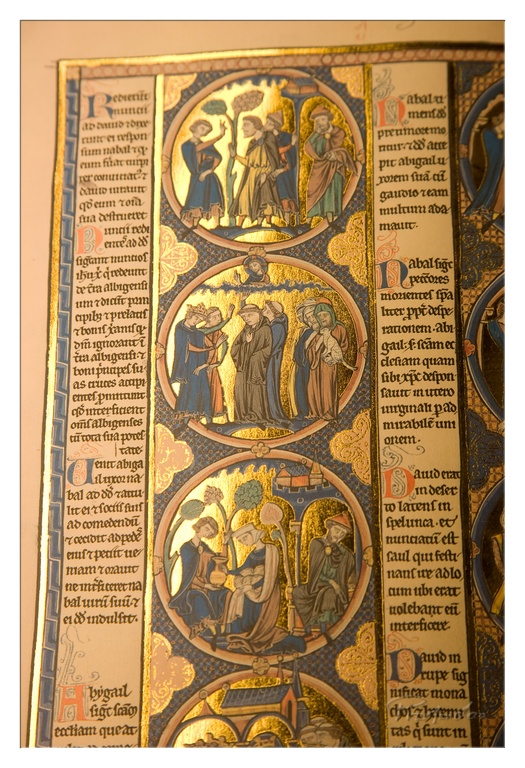

1. Overall Rating (0–10) — 8.0
This photograph captures the radiant splendor of a medieval illuminated manuscript, where gold leaf and vibrant pigments transform sacred text into a visual hymn. The rich interplay of color, intricate line work, and narrative depth convey a sense of timelessness and devotion. While the lighting enhances the luminosity of the gold, the image’s slightly darkened corners and uneven exposure prevent it from achieving a fully immersive presence.
2. Composition (0–10) — 7.5
The vertical framing emphasizes the manuscript’s structure, with the three circular illustrations arranged in a rhythmic, ascending sequence. The text columns on either side frame the central imagery, creating a balanced, almost architectural feel. However, the slight tilt and tight cropping reduce the sense of grandeur, suggesting a handheld capture rather than a staged presentation.
3. Lighting (0–10) — 7.0
Warm, directional light highlights the gilded surfaces, creating a soft glow that accentuates the manuscript’s luminous quality. The contrast between the bright gold and the deep blue background is striking, though some areas of the page fall into shadow, losing detail in the corners.
4. Color & Tone (0–10) — 8.5
The palette is rich and harmonious, with deep cobalt blue, luminous gold, and earthy reds and greens creating a vivid, regal atmosphere. The tonal contrast enhances the textural depth, while the golden highlights evoke a sense of divine radiance.
5. Creativity (0–10) — 8.0
The image successfully captures the artistic and spiritual essence of the manuscript, transforming a static object into a narrative moment. The choice to focus on the interplay of text and image emphasizes the manuscript’s dual role as both a religious artifact and a work of art.
6. Technical Quality (0–10) — 7.5
The image is sharp and detailed, allowing viewers to appreciate the fine line work and pigmentation. Focus is consistent across the central elements, though slight noise and uneven lighting in the periphery suggest limitations in the camera’s dynamic range.
7. Emotional Impact (0–10) — 8.0
The photograph evokes awe and reverence, inviting the viewer to contemplate the dedication and artistry of medieval scribes. The warmth of the light and the richness of the imagery create a contemplative mood, bridging centuries of craftsmanship and devotion.
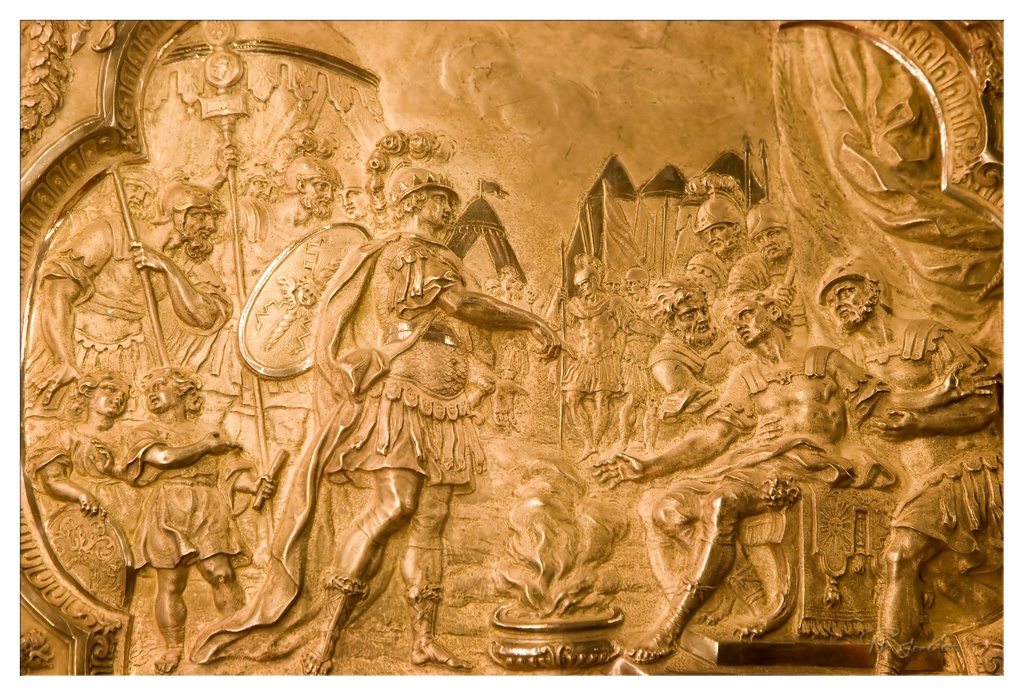

1. Overall Rating (0–10) — 8.0
This photograph captures the intricate grandeur of a gilded relief, where every sculpted detail pulses with historical weight and narrative intensity. The warm, golden tones and dramatic interplay of light and shadow lend the scene a regal, almost sacred quality, emphasizing the craftsmanship and emotional gravity of the moment depicted. While the image is rich in texture and mood, its slightly overwrought toning risks obscuring some of the finer details, holding it just short of transcendent clarity.
2. Composition (0–10) — 7.5
The central figure commands attention through dynamic movement and balanced placement, while surrounding elements guide the eye across the narrative arc. The curved frame enhances the sense of depth, though some areas feel crowded, slightly overwhelming the viewer’s focus.
3. Lighting (0–10) — 8.5
Directional lighting accentuates the relief’s three-dimensionality, carving out form and depth with dramatic contrast. The warm, golden illumination enhances the metal’s luster and reinforces the scene’s solemn, timeless atmosphere.
4. Color & Tone (0–10) — 8.0
A monochromatic golden palette unifies the image, creating a cohesive and luxurious visual language. The rich tonal range and subtle gradations in hue amplify the sense of antiquity and opulence.
5. Creativity (0–10) — 8.0
The image transforms a historical artifact into a compelling visual story, emphasizing both the narrative and the materiality of the sculpture. The choice to focus on the play of light and texture elevates the object beyond mere documentation.
6. Technical Quality (0–10) — 8.5
Sharp focus and fine detail render the sculptural textures with precision, while excellent control of exposure preserves both highlights and shadows without loss of information.
7. Emotional Impact (0–10) — 8.5
The image evokes awe and reverence, inviting contemplation of power, duty, and sacrifice. The dramatic lighting and rich tone draw the viewer into the moment, creating a powerful sense of connection to the past.
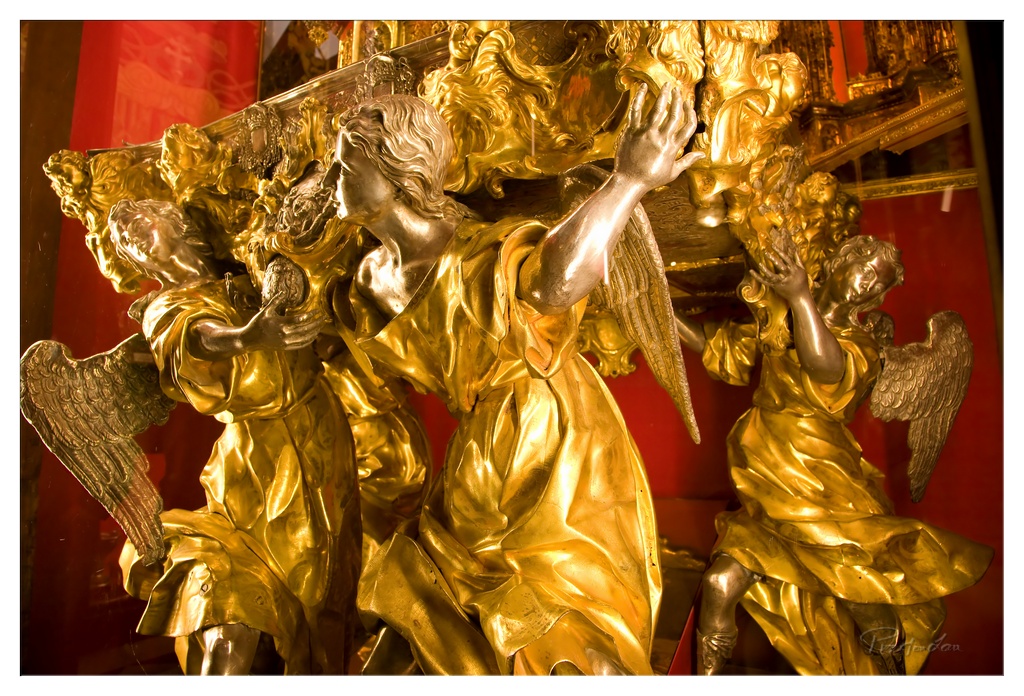

1. Overall Rating (0–10) — 8.0
This photograph captures the opulent grandeur of a gilded religious sculpture with striking reverence and dramatic intensity. The interplay of light and shadow across the sculpted angels amplifies their ethereal presence, while the rich red backdrop enhances the sense of sacred splendor. Though the image is visually powerful, its slightly overexposed highlights and cluttered background prevent it from achieving complete elegance.
2. Composition (0–10) — 7.5
The central figure dominates the frame, drawing the eye with dynamic movement, while the surrounding angels create a sense of depth and narrative. However, the tight framing and overlapping forms slightly disrupt visual clarity, and the edges of the frame feel crowded.
3. Lighting (0–10) — 9.0
The directional light accentuates the textures and contours of the golden figures, creating a dramatic chiaroscuro effect that enhances their three-dimensional form. The warm glow enhances the spiritual atmosphere, though a few areas are slightly blown out due to intense reflections.
4. Color & Tone (0–10) — 8.5
The dominant golds are rich and saturated, contrasting beautifully with the deep red background. The warm tonal palette evokes a sense of reverence and timelessness, with a subtle balance between luminosity and shadow.
5. Creativity (0–10) — 8.0
The photographer captures the sculpture not just as an object, but as a narrative moment—angels in motion, lifting a divine vessel. The choice of tight framing and dramatic lighting lends a theatrical quality that elevates the image beyond simple documentation.
6. Technical Quality (0–10) — 7.5
The focus is sharp on the central figures, with clear detail in the folds of the drapery and the delicate wings. The image is well-exposed overall, though some highlights on the gold surface lose detail due to glare.
7. Emotional Impact (0–10) — 8.5
The photograph evokes awe and reverence, capturing the spiritual intensity of the subject. The viewer is drawn into a moment of celestial drama, feeling both the beauty and the solemnity of the scene.
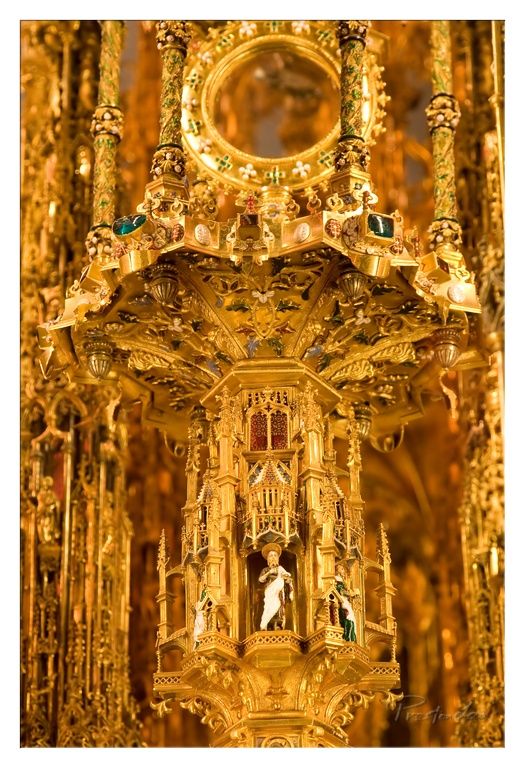

1. Overall Rating (0–10) — 8.5
This photograph captures the breathtaking opulence of a golden reliquary, where light and craftsmanship converge to evoke reverence and awe. The intricate details of the gilded structure, rich with religious iconography and ornate carvings, are rendered with a luminous warmth that highlights its sacred grandeur. While the dense composition and repetitive golden tones risk visual fatigue, the image succeeds in conveying the spiritual weight and artistic mastery of the object, inviting contemplation through its radiant presence.
2. Composition (0–10) — 7.5
The central placement of the reliquary anchors the image, but the surrounding repetition of golden elements creates a slightly crowded feel. A tighter crop could enhance focus and reduce visual clutter, allowing the viewer to better absorb the fine details.
3. Lighting (0–10) — 9.0
Warm, directional lighting enhances the three-dimensionality of the reliquary, casting soft shadows that emphasize its elaborate textures and depth. The golden glow feels intentional and sacred, amplifying the object’s spiritual resonance.
4. Color & Tone (0–10) — 8.5
The dominant golden palette is rich and harmonious, with subtle accents of green, red, and blue adding visual interest. The warm tone enhances the sense of reverence, while the contrast between light and shadow gives the image depth and richness.
5. Creativity (0–10) — 8.0
The photograph elevates a religious artifact into a work of art, emphasizing its beauty and craftsmanship. The choice to focus on the intricate details rather than the broader context demonstrates a strong artistic intent, transforming a sacred object into a visually compelling subject.
6. Technical Quality (0–10) — 9.0
The image is sharp and well-focused, capturing fine textures and engravings with clarity. The exposure is balanced, preserving detail in both highlights and shadows, and the color reproduction is accurate and vibrant.
7. Emotional Impact (0–10) — 9.0
The image evokes a profound sense of awe and reverence, drawing the viewer into a moment of quiet contemplation. The warmth and intricacy of the reliquary create a powerful emotional connection to faith, tradition, and human devotion.
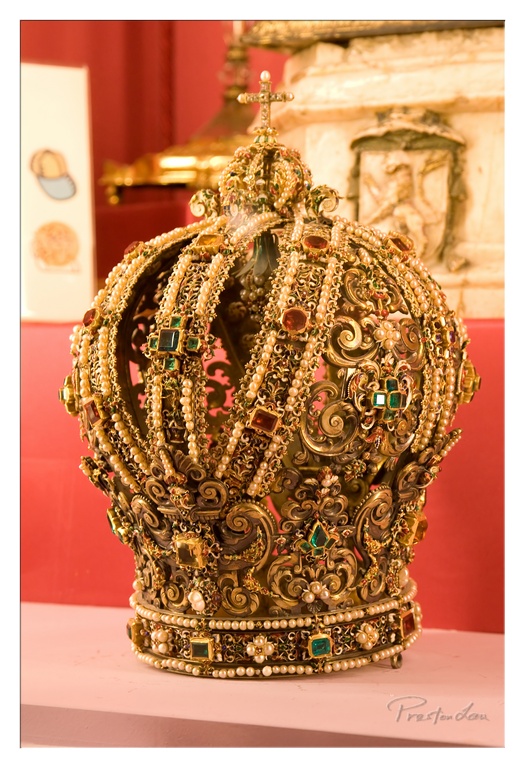

1. Overall Rating (0–10) — 8.0
This photograph captures the opulence and intricate craftsmanship of a regal crown, transforming a museum artifact into a visual monument of power and devotion. The warm lighting and rich textures enhance the crown’s golden complexity, while the blurred background isolates the subject with reverence. Though the composition leans slightly toward formal documentation, the image succeeds in conveying both the object’s grandeur and its spiritual weight.
2. Composition (0–10) — 7.5
The crown is centered with a slight tilt, creating a dynamic yet balanced frame. The shallow depth of field effectively isolates the subject, though the visible signage on the left slightly disrupts the visual harmony.
3. Lighting (0–10) — 8.5
Soft, directional light enhances the crown’s three-dimensional form, highlighting the textures of gold, pearls, and gemstones. The warm tone complements the golden hues and adds a sense of reverence and timelessness.
4. Color & Tone (0–10) — 8.0
The rich golds contrast beautifully with the deep red background, while the emerald and ruby accents pop with vividness. The tonal range is well-balanced, with subtle shadows adding depth without overwhelming the image.
5. Creativity (0–10) — 7.5
While the subject is inherently dramatic, the photographer elevates it through thoughtful lighting and framing. The image feels both reverent and artistically composed, avoiding mere documentation in favor of narrative suggestion.
6. Technical Quality (0–10) — 8.5
Sharp focus on the crown’s details, clean exposure, and minimal noise demonstrate strong technical control. The shallow depth of field is used effectively to draw attention to the craftsmanship.
7. Emotional Impact (0–10) — 8.0
The image evokes awe and solemnity, inviting contemplation of history, power, and faith. The viewer is drawn into a moment of quiet reverence, as if witnessing a sacred relic in a hushed gallery.
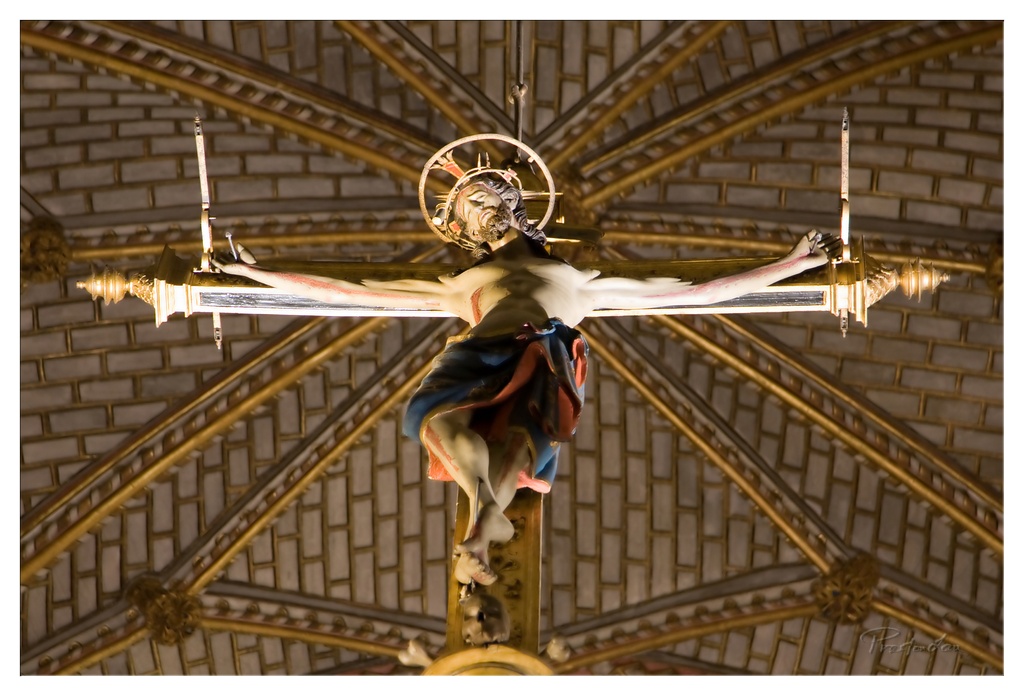

1. Overall Rating (0–10) — 8.0
This photograph captures a solemn and reverent moment within a sacred space, where the crucifixion sculpture commands the viewer’s attention with quiet dignity. The upward perspective and the interplay of light and shadow enhance the spiritual gravity of the scene, while the ornate vaulted ceiling adds architectural depth and context. The image succeeds in conveying both the emotional weight of the subject and the craftsmanship of the setting, though a slightly warmer tone might deepen its meditative atmosphere.
2. Composition (0–10) — 8.5
The low-angle framing centers the crucifix perfectly, creating a powerful vertical axis that draws the eye upward. The symmetrical arrangement of the vaulted ceiling enhances balance and reinforces the image’s solemnity, while the slight tilt adds subtle dynamism.
3. Lighting (0–10) — 7.5
The lighting is directional and dramatic, highlighting the figure of Christ and casting soft shadows that emphasize form and texture. The contrast between the illuminated cross and the darker ceiling enhances depth, though the highlights on the gold accents verge on slightly overexposed.
4. Color & Tone (0–10) — 7.0
The palette is restrained, dominated by earthy golds, deep reds, and muted blues, which evoke a sense of age and reverence. The overall tone is slightly cool, which tempers the warmth of the golden elements; a touch of color warmth could elevate the spiritual ambiance.
5. Creativity (0–10) — 8.0
The choice to photograph from below and center the crucifix within the architectural vaulting is both visually and symbolically compelling. It transforms a religious object into a focal point of transcendence, merging art, faith, and space in a unified narrative.
6. Technical Quality (0–10) — 8.0
The image is sharp and well-focused, with clear detail in the sculpture and the ceiling’s intricate patterns. The exposure is well-handled, though the highlights on the cross’s metalwork show minor loss of detail.
7. Emotional Impact (0–10) — 8.5
The photograph evokes a profound sense of reverence and contemplation, drawing the viewer into a moment of quiet reflection. The combination of subject, lighting, and composition creates a deeply moving and spiritually resonant experience.
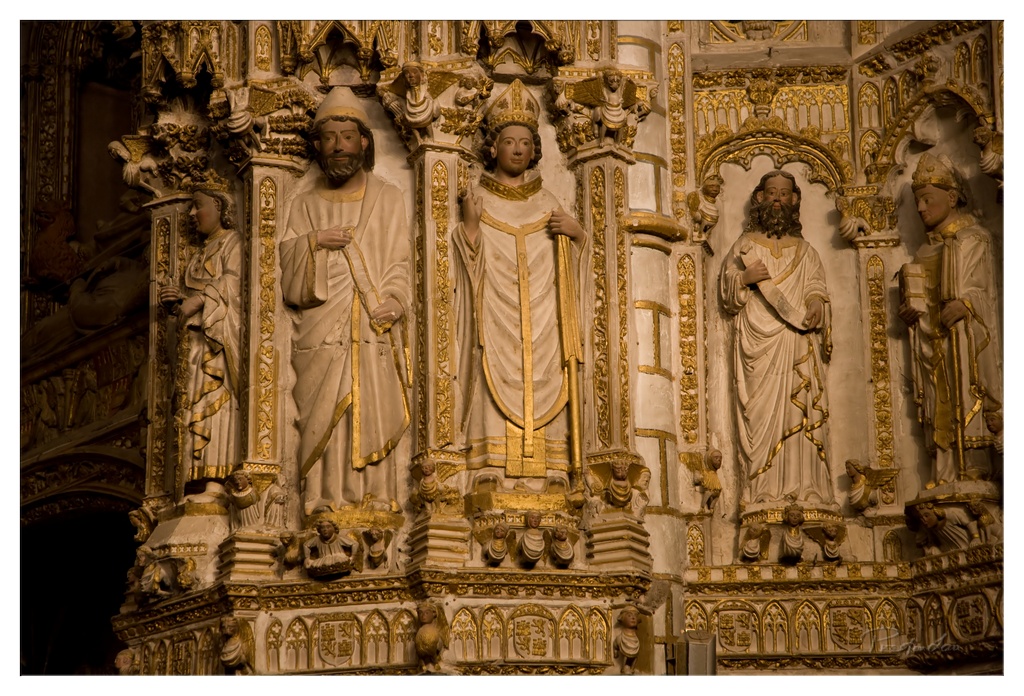

1. Overall Rating (0–10) — 8.0
This photograph captures the solemn grandeur of a baroque religious altarpiece, where intricate carvings and gilded details evoke centuries of devotion. The warm, directional lighting enhances the texture and depth of the sculpture, creating a reverent atmosphere that draws the eye across the central figures. While the composition is rich in detail, the slightly overexposed highlights on the gold trim risk diminishing the subtlety of the craftsmanship.
2. Composition (0–10) — 7.5
The central figures are well-balanced, with the dominant central saint anchoring the frame. The surrounding ornamental elements create a layered, hierarchical structure, though the tight crop slightly compresses the vertical scale of the piece.
3. Lighting (0–10) — 8.5
The warm, directional light from the left enhances the three-dimensionality of the carvings, casting deep shadows that accentuate texture and depth. The golden highlights are rendered with richness, though a more controlled exposure would preserve detail in the brightest areas.
4. Color & Tone (0–10) — 8.0
The palette is dominated by warm golds and off-whites, creating a cohesive, sacred atmosphere. The subtle tonal range and controlled contrast lend the image a painterly quality, with the gold leaf providing visual warmth and emphasis.
5. Creativity (0–10) — 7.5
The photographer captures the architectural and spiritual essence of the altarpiece with respect and intention. The focus on the interplay of light and ornamentation reveals a narrative of faith and craftsmanship, though the approach remains observational rather than interpretive.
6. Technical Quality (0–10) — 8.0
Sharp focus across the central figures reveals fine detail in the carving, and the depth of field is well-managed. The image is clean and well-exposed, with only minor overexposure in the brightest gold accents.
7. Emotional Impact (0–10) — 8.5
The image conveys a sense of awe and reverence, inviting the viewer to contemplate the devotion embedded in the craftsmanship. The interplay of light and shadow evokes a hushed, sacred stillness that resonates deeply.
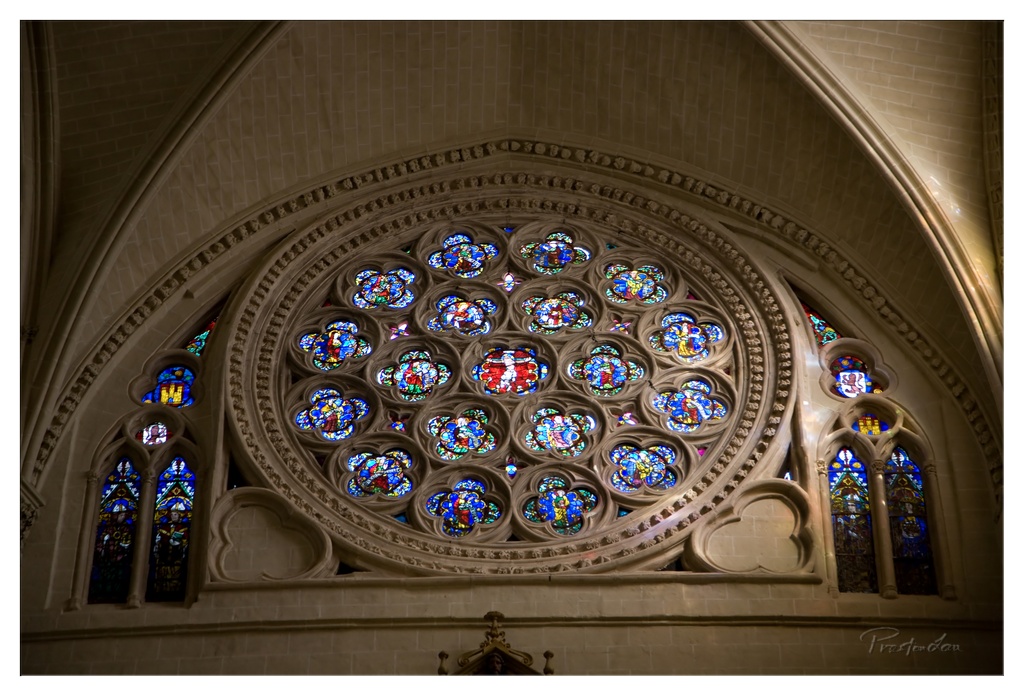

1. Overall Rating (0–10) — 8.0
This photograph captures the awe-inspiring grandeur of a Gothic cathedral interior, with the rose window as a radiant centerpiece. The interplay of light and color through the stained glass creates a sense of sacred stillness and architectural harmony. While the composition is rich in detail, the slightly heavy vignette and muted overall tone slightly dampen the visual vibrancy, preventing it from achieving full emotional resonance.
2. Composition (0–10) — 8.5
The central placement of the rose window creates a strong focal point, balanced by the symmetry of the flanking lancet windows and the arching stone framework. The framing effectively guides the eye upward, emphasizing the verticality and scale of the space, though a tighter crop could enhance intimacy.
3. Lighting (0–10) — 7.5
Natural light filters through the stained glass, casting soft, colored illumination that enhances the window’s intricate details. The ambient light within the cathedral is dim, creating a dramatic contrast that underscores the luminous quality of the glass. A touch more exposure in the shadows would reveal more of the stonework texture.
4. Color & Tone (0–10) — 8.0
The rich, jewel-toned hues of the stained glass—deep blues, reds, and golds—pop against the neutral stone, creating a visually striking palette. The warm, golden glow of the light enhances the sense of reverence, though the overall tone is slightly darkened by the vignette, muting some of the vibrancy.
5. Creativity (0–10) — 8.5
The photographer has captured not just a scene, but a moment of spiritual atmosphere. The choice to frame the rose window within the architectural embrace of the vaulted ceiling conveys both reverence and narrative depth. The image feels both documentary and poetic, elevating a familiar subject into something transcendent.
6. Technical Quality (0–10) — 8.0
The image is sharp and detailed, particularly in the glasswork and stonework, with minimal noise. The focus is precise, and the depth of field is well-managed, ensuring clarity throughout the frame. The slight softness in the darkest areas suggests a high-ISO capture, but does not detract significantly.
7. Emotional Impact (0–10) — 8.5
The photograph evokes a profound sense of wonder and tranquility, inviting the viewer into a quiet, sacred space. The interplay of light, color, and architecture stirs a deep emotional response, reminiscent of awe in the face of centuries-old craftsmanship and faith.
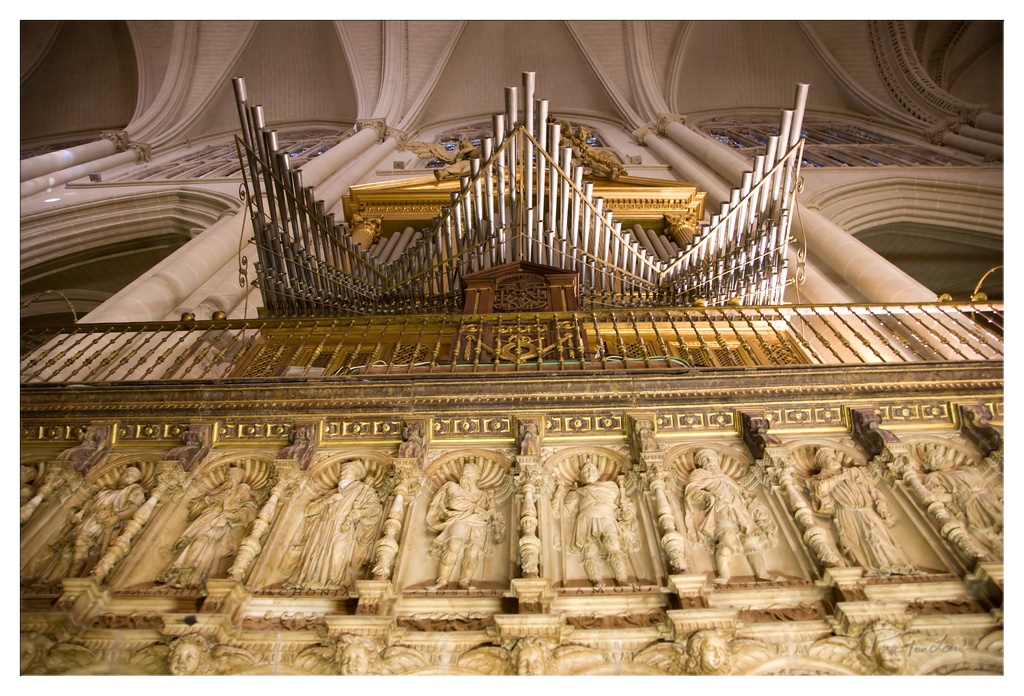

1. Overall Rating (0–10) — 8.0
This photograph captures the grandeur and intricate craftsmanship of a cathedral organ with reverence and clarity. The interplay between the soaring Gothic architecture and the ornate pipe organ creates a sense of spiritual elevation and historical depth. While the composition is rich in detail, the lighting's softness slightly dampens the visual drama, preventing the image from achieving full transcendence.
2. Composition (0–10) — 8.5
The symmetrical framing centers the organ, drawing the eye upward along its vertical lines toward the vaulted ceiling. The lower tier of sculpted figures provides a strong horizontal base, balancing the upward sweep of the pipes. A slight tilt in perspective adds dynamism without disrupting the overall harmony.
3. Lighting (0–10) — 7.5
The warm, ambient light enhances the golden tones of the organ case and highlights the texture of the stone carvings. The lighting is soft and diffused, minimizing harsh shadows and preserving detail across the frame. However, the lack of directional contrast slightly flattens the three-dimensionality of the space.
4. Color & Tone (0–10) — 8.0
The palette is composed of warm golds, creams, and soft whites, evoking a sense of reverence and timelessness. The tonal range is rich and balanced, with subtle shadows adding depth without overpowering the luminous highlights. The color harmony is exceptional, reinforcing the sacred atmosphere of the setting.
5. Creativity (0–10) — 8.0
The photographer has captured both the architectural majesty and the artistic detail with intention, framing the organ not just as a musical instrument but as a central icon of spiritual and artistic expression. The choice to include the full breadth of the carving and the soaring structure creates a layered narrative of faith and craftsmanship.
6. Technical Quality (0–10) — 8.5
Sharp focus throughout the image ensures that the fine details of the carvings and pipes are clearly rendered. The depth of field is well-managed, keeping both the foreground and background in view. The exposure is accurate, with no blown highlights or lost shadows, showcasing the image’s technical precision.
7. Emotional Impact (0–10) — 8.5
The image evokes awe and contemplation, inviting the viewer to imagine the sound of the organ resonating through the vast space. The combination of sacred architecture, intricate artistry, and warm light creates a deeply moving atmosphere, connecting the viewer to a sense of history, devotion, and beauty.
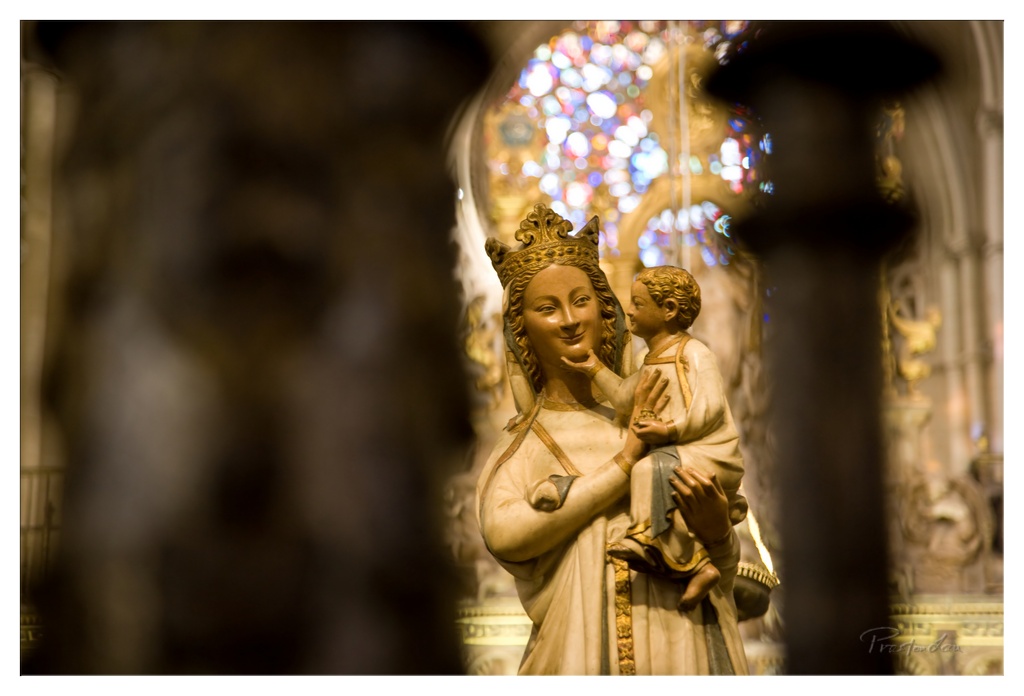

1. Overall Rating (0–10) — 7.8
This photograph captures a tender, sacred moment within a cathedral, where the statue of the Virgin Mary cradling the Christ Child is framed through architectural elements, creating a sense of reverence and intimacy. The soft glow of the stained glass behind the sculpture infuses the scene with spiritual warmth, while the blurred foreground adds depth and a sense of viewing from a distance. The image balances realism and artistry, though slight overexposure in the highlights slightly diminishes the subtlety of the lighting.
2. Composition (0–10) — 8.0
The statue is centered and framed by dark, out-of-focus architectural forms on either side, creating a natural vignette that draws the eye to the subject. The leading lines formed by the columns and archway enhance the sense of depth and guide the viewer toward the illuminated figure.
3. Lighting (0–10) — 8.5
The warm, diffused light from the stained glass behind the statue creates a halo effect, softly illuminating the figures and enhancing their serene expressions. The contrast between the bright background and the darker foreground adds drama and depth, with the light quality reinforcing the sacred mood.
4. Color & Tone (0–10) — 8.0
The warm golden tones of the statue harmonize beautifully with the soft, multicolored glow of the stained glass. The overall palette is rich yet subdued, with a gentle contrast between the warm highlights and the deep shadows, creating a contemplative and reverent atmosphere.
5. Creativity (0–10) — 8.5
The photographer’s choice to frame the image through architectural elements adds a layer of narrative and perspective, suggesting a viewer’s quiet observation of a sacred space. The use of depth of field and natural light enhances the spiritual mood, making the scene feel both intimate and timeless.
6. Technical Quality (0–10) — 8.0
The focus is sharp on the statue, with a smooth transition into the background bokeh. The image is well-exposed overall, though the highlights in the stained glass are slightly blown out, indicating a minor technical limitation in dynamic range.
7. Emotional Impact (0–10) — 9.0
The image evokes a deep sense of peace, devotion, and awe. The tender pose of Mary and the child, combined with the soft light and sacred setting, creates a powerful emotional resonance, inviting the viewer into a moment of quiet contemplation.
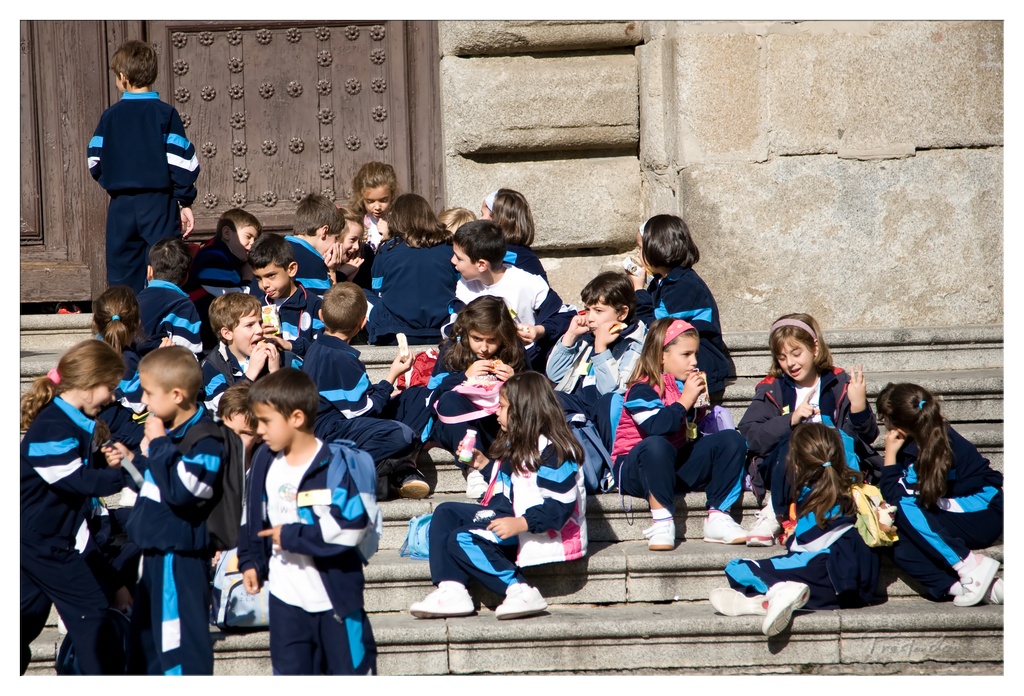

1. Overall Rating (0–10) — 7.0
This photograph captures a candid moment of schoolchildren in uniform, gathered on stone steps in what appears to be a historic European setting. The natural light and unposed interactions lend authenticity to the scene, creating a sense of everyday life imbued with quiet charm. While the composition is strong and the mood genuine, the image's emotional resonance is slightly restrained by a lack of visual cohesion and a somewhat cluttered arrangement.
2. Composition (0–10) — 6.5
The group is arranged across the steps, creating a diagonal flow that guides the eye through the frame. However, the central cluster of children feels slightly overcrowded, and the man in the doorway at the top left disrupts the visual balance. A tighter crop would enhance focus and reduce distractions.
3. Lighting (0–10) — 8.0
Bright, direct sunlight creates strong contrasts and sharp shadows, emphasizing texture in the stone and fabric. The high contrast adds energy to the scene and highlights the children’s expressions and movements, though some faces are slightly overexposed.
4. Color & Tone (0–10) — 7.5
The navy and light blue uniforms create a cohesive color scheme that stands out against the neutral stone background. The warm tones of the sunlight enhance the overall vibrancy, though the color saturation is slightly overdone, giving the image a slightly artificial edge.
5. Creativity (0–10) — 7.0
The image captures a moment of spontaneous childhood interaction with a documentary-like honesty. The juxtaposition of modern school uniforms against the aged architecture adds a subtle narrative layer, suggesting continuity between generations and places.
6. Technical Quality (0–10) — 8.0
The image is sharp and well-focused, with clear detail in both the foreground and background. The exposure is generally well-managed, though some highlights are blown out due to the strong sun.
7. Emotional Impact (0–10) — 7.5
The photograph evokes a sense of nostalgia and warmth, capturing the innocence and joy of children at play. The viewer is drawn into the scene through the genuine expressions and interactions, creating a fleeting but memorable connection to a shared human experience.
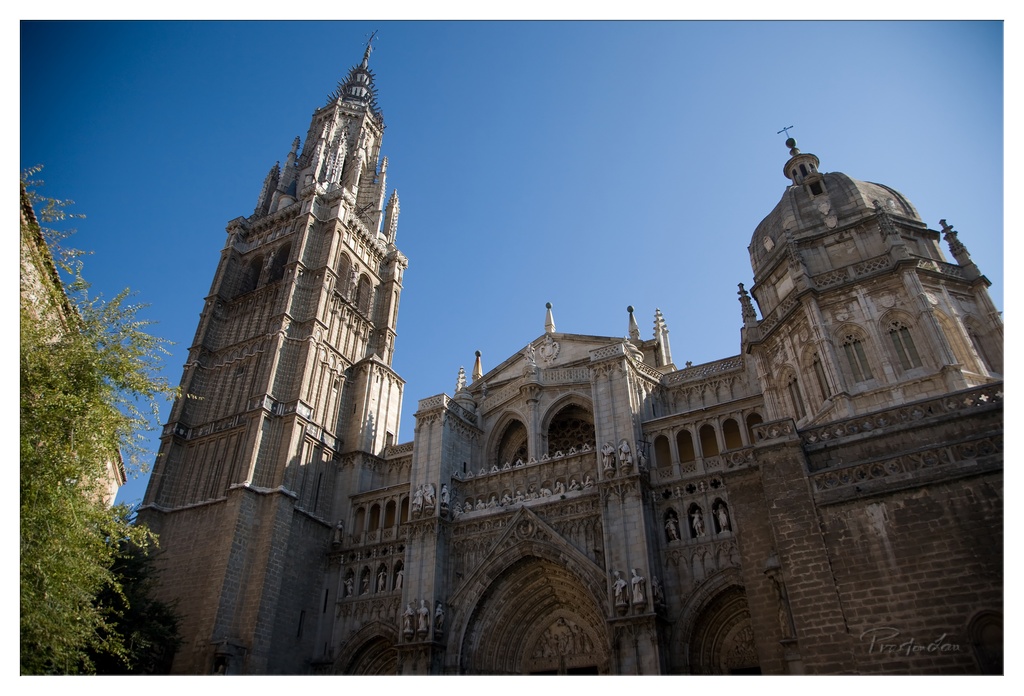

1. Overall Rating (0–10) — 8.0
This photograph captures the majestic grandeur of a Gothic cathedral with striking clarity and reverence, emphasizing its verticality and intricate stonework against a deep blue sky. The low-angle perspective enhances the structure’s imposing presence, while the crisp detail and natural light lend a sense of timelessness and awe. A subtle shadow cast across the facade adds depth without overpowering the composition, though a slightly warmer tone might have heightened the emotional resonance.
2. Composition (0–10) — 8.5
The low-angle shot effectively emphasizes the cathedral’s towering scale, with the spire and dome framing the scene diagonally to create dynamic balance. The inclusion of green foliage on the left adds a natural counterpoint to the stone architecture, guiding the eye into the frame without distracting from the central subject.
3. Lighting (0–10) — 8.0
Bright, direct sunlight enhances the texture and depth of the stonework, casting clean shadows that define the architectural details. The contrast between the sunlit façade and the darker recesses adds dimension, while the clear blue sky serves as a vivid, uncluttered backdrop.
4. Color & Tone (0–10) — 7.5
The palette is dominated by the warm beige of the stone and the rich cobalt of the sky, creating a harmonious and visually striking contrast. The tones are well-saturated but not oversaturated, preserving naturalism while enhancing the scene’s grandeur.
5. Creativity (0–10) — 8.0
The choice of angle and framing transforms a familiar architectural subject into a dramatic and almost reverential portrait. The interplay between the organic curve of the dome and the verticality of the tower introduces a subtle visual tension, demonstrating a thoughtful artistic approach.
6. Technical Quality (0–10) — 8.5
The image is sharp and well-focused, with excellent clarity in the fine details of the carvings and stonework. The exposure is balanced, and the dynamic range is handled effectively, preserving detail in both highlights and shadows.
7. Emotional Impact (0–10) — 8.5
The photograph evokes a profound sense of awe and reverence, capturing not just the physical structure but the spiritual weight of a centuries-old monument. The viewer is invited to feel the scale and history of the cathedral, creating a powerful emotional connection to time and faith.
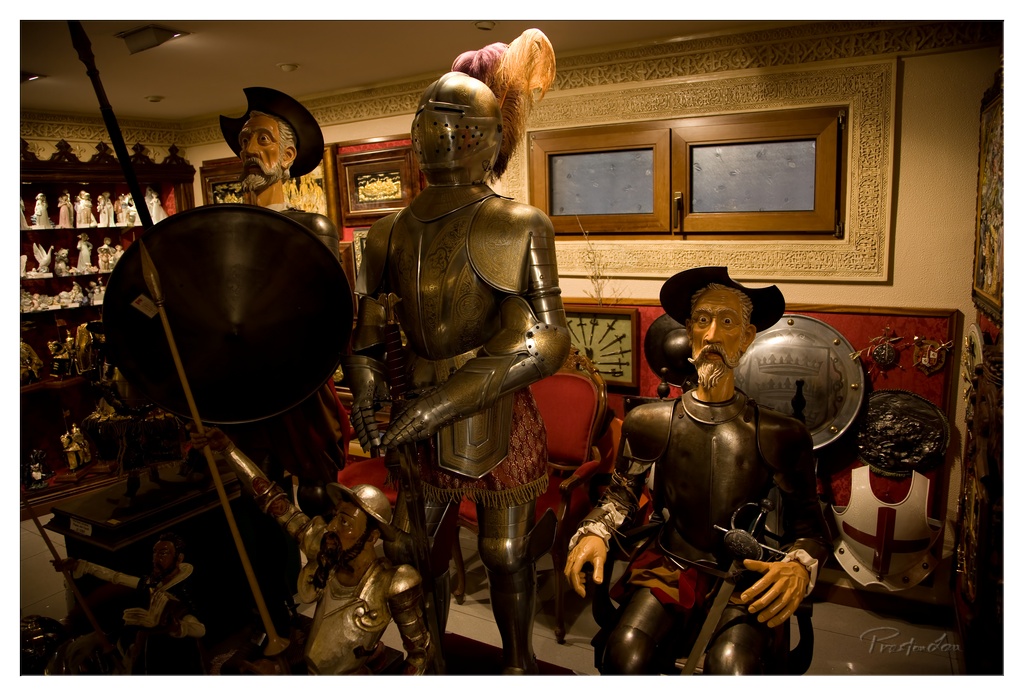

1. Overall Rating (0–10) — 7.0
This photograph captures the rich, layered atmosphere of a curio-filled shop brimming with historical artifacts, where the interplay of light and shadow breathes life into a collection of medieval figurines and armor. The warm, subdued lighting enhances the sense of age and craftsmanship, while the dense arrangement of objects invites the viewer into a world of storytelling. Though the scene is visually busy, the composition holds together through a cohesive palette and deliberate focus, giving the image a strong sense of place and history.
2. Composition (0–10) — 7.5
The central knight in armor anchors the frame, with surrounding figures creating a dynamic, layered arrangement. The use of depth and overlapping elements draws the eye through the scene, though the tight framing slightly overwhelms the viewer.
3. Lighting (0–10) — 8.0
Warm, directional lighting from above casts dramatic shadows, accentuating the textures of metal and fabric. The contrast between light and shadow adds depth and drama, enhancing the theatrical quality of the display.
4. Color & Tone (0–10) — 7.5
A warm, golden tone dominates, complemented by deep reds and metallic grays that evoke a sense of antiquity. The subtle color harmony supports the historical theme, though the overall warmth slightly mutes the vibrancy of individual objects.
5. Creativity (0–10) — 8.0
The image transcends mere documentation by transforming a shop display into a narrative tableau. The careful arrangement and lighting suggest a deliberate artistic intent, turning everyday objects into characters in a larger story.
6. Technical Quality (0–10) — 8.5
Sharp focus and clear detail highlight the textures of the armor and figurines. The exposure is well-balanced, with minimal noise and good control over highlights and shadows.
7. Emotional Impact (0–10) — 7.5
The photograph evokes a sense of nostalgia and wonder, inviting the viewer to imagine the stories behind each figure. The intimacy of the lighting and the richness of the details create a quiet reverence for history and craftsmanship.
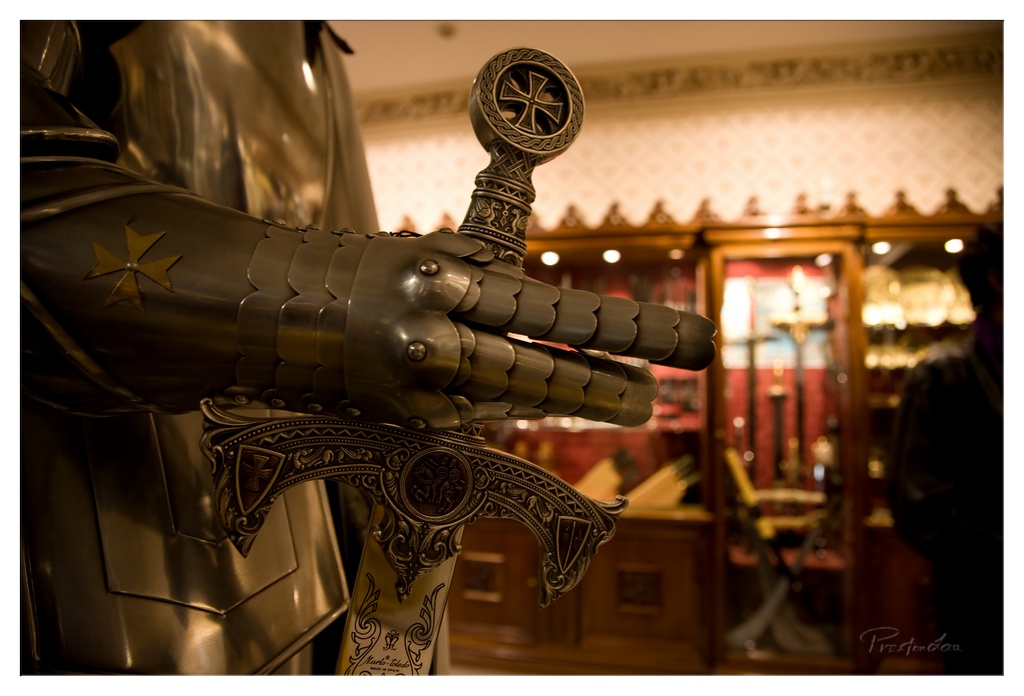

1. Overall Rating (0–10) — 7.5
This photograph captures the solemn grandeur of a knightly armor display, where intricate metalwork and symbolic motifs evoke a sense of historical reverence. The warm lighting and shallow depth of field lend a cinematic quality, drawing focus to the ornate sword and gauntlet. While the image successfully conveys the craftsmanship and narrative weight of the artifact, a slightly more deliberate composition could elevate its visual harmony.
2. Composition (0–10) — 7.0
The tight framing emphasizes the hand and sword, creating a strong focal point. However, the diagonal line of the arm and the slight asymmetry of the background elements introduce a subtle imbalance, slightly undermining the image’s formal presence.
3. Lighting (0–10) — 8.0
The warm, directional lighting enhances the metallic textures and casts soft shadows that accentuate the three-dimensional detail of the armor. The use of ambient light in the background adds depth without overpowering the subject.
4. Color & Tone (0–10) — 7.5
A rich, golden-brown tonal palette dominates, complementing the aged metal and evoking a sense of antiquity. The contrast between the cool metallic sheen and the warm background creates a visually cohesive and atmospheric mood.
5. Creativity (0–10) — 8.0
The photographer captures a moment that transcends mere documentation, transforming a museum exhibit into a narrative tableau. The focus on symbolic details—such as the Maltese cross and the ornate hilt—invites interpretation and suggests a deeper story.
6. Technical Quality (0–10) — 8.5
Sharp focus on the hand and sword, with a smooth bokeh in the background, demonstrates strong technical control. The exposure is well-managed, preserving detail in both highlights and shadows.
7. Emotional Impact (0–10) — 8.0
The image stirs a sense of awe and nostalgia, evoking the valor and mystique of chivalric tradition. The viewer is drawn into a quiet reverence for the craftsmanship and legacy embodied in the armor.
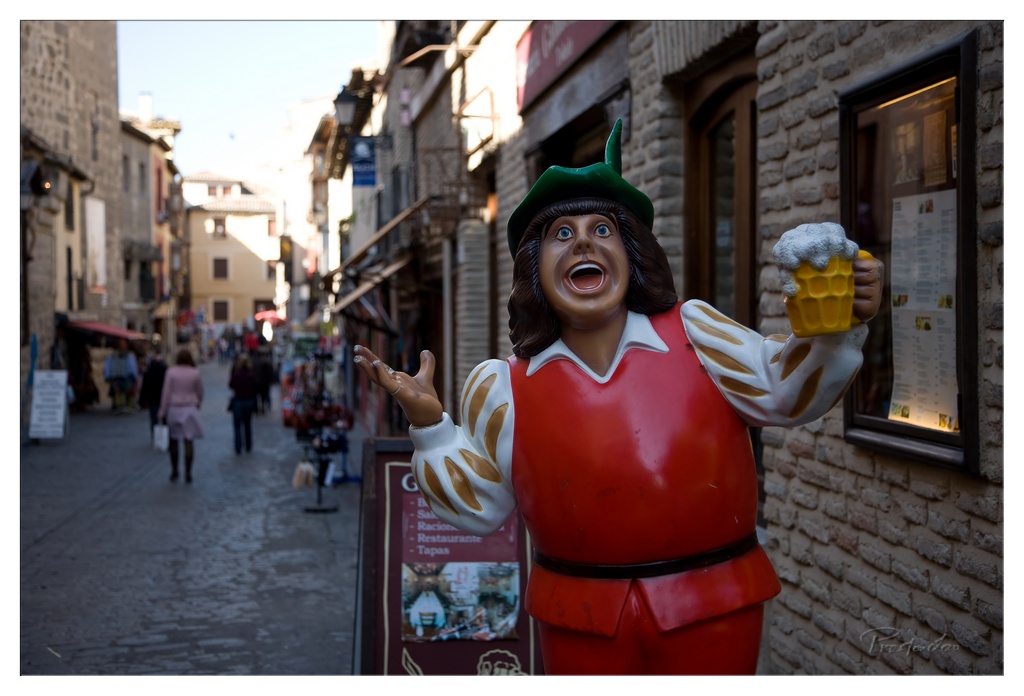

1. Overall Rating (0–10) — 7.0
This photograph captures the lively spirit of a European street scene, where a whimsical statue serves as a vibrant focal point against the backdrop of a historic, cobblestone alley. The statue’s exaggerated expression and bright costume inject humor and energy into the image, contrasting with the muted tones of the surrounding architecture. While the composition and lighting effectively highlight the subject, the background’s depth and activity could be better integrated to create a more cohesive narrative.
2. Composition (0–10) — 7.0
The statue is well-placed on the right, drawing the eye with its dynamic pose, while the receding alley creates a sense of depth. The diagonal lines of the street guide the viewer’s gaze into the scene, though the cluttered background slightly disrupts the visual flow.
3. Lighting (0–10) — 6.5
Natural daylight illuminates the scene, with soft shadows suggesting late afternoon. The light enhances the statue’s colors and textures, though the bright sky in the background slightly overexposes the upper portion of the image.
4. Color & Tone (0–10) — 7.0
The warm, earthy tones of the stone buildings contrast nicely with the bold red and green of the statue. The color palette feels authentic and balanced, with the yellow beer mug adding a pop of complementary color.
5. Creativity (0–10) — 7.5
The choice to focus on the humorous statue amidst a real-world setting creates a playful juxtaposition between artifice and daily life. The image tells a story of culture and tradition, inviting curiosity about the locale and its customs.
6. Technical Quality (0–10) — 7.5
Sharp focus on the statue ensures clarity and detail, while the shallow depth of field effectively blurs the background to emphasize the subject. The exposure is well-managed, with minimal noise or distortion.
7. Emotional Impact (0–10) — 7.0
The statue’s exaggerated expression evokes amusement and a sense of celebration, while the bustling street adds a touch of everyday realism. The image captures a fleeting moment of joy and cultural character, resonating with viewers on a personal level.
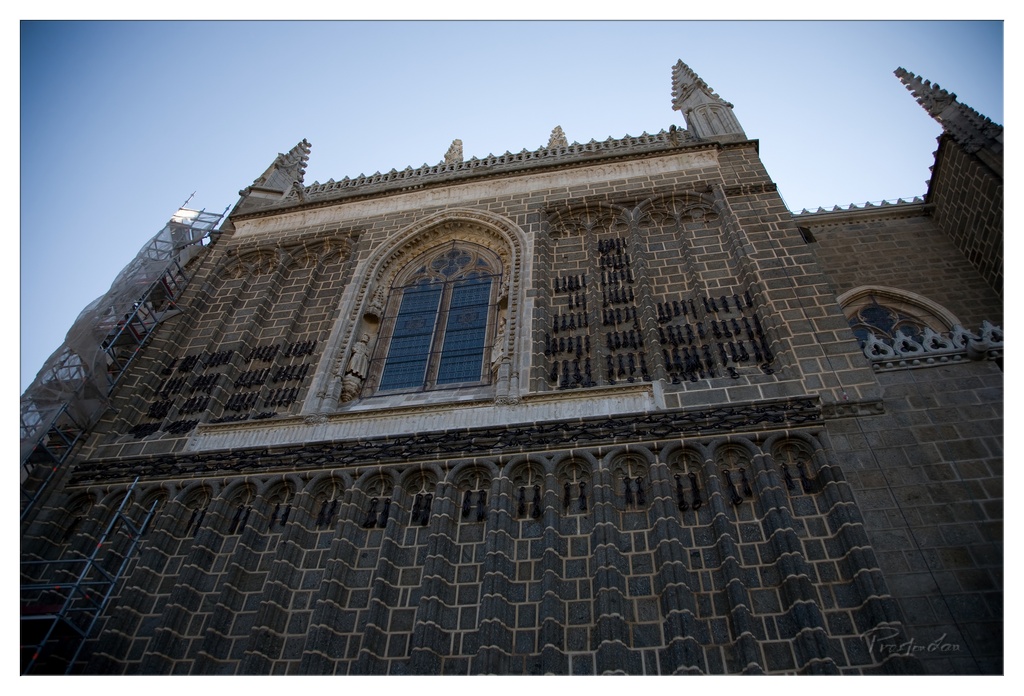

1. Overall Rating (0–10) — 7.0
This photograph captures the imposing grandeur of a Gothic cathedral, its intricate stonework and soaring verticality conveying a sense of historical reverence and architectural mastery. The low-angle perspective enhances the monumentality of the structure, while the soft, early morning light lends a contemplative mood. The presence of scaffolding introduces a subtle tension between preservation and decay, grounding the image in the present moment. While the composition is strong, the muted tones and lack of vibrant contrast slightly dampen its visual impact.
2. Composition (0–10) — 7.5
The low-angle shot emphasizes the cathedral’s verticality, with the stone facade and pointed arches drawing the eye upward. The scaffolding on the left creates a diagonal counterpoint, adding visual interest and grounding the image in reality. The framing is balanced, though the right side feels slightly less structured, creating a subtle asymmetry that works in favor of naturalism.
3. Lighting (0–10) — 7.0
Soft, directional light from the left highlights the texture of the stonework and casts gentle shadows that accentuate the architectural details. The sky is clear and evenly lit, suggesting early morning or late afternoon, which contributes to the image’s calm, reverent tone. The lighting is well-controlled, avoiding harsh contrasts and preserving depth in the darker areas.
4. Color & Tone (0–10) — 6.5
The palette is dominated by cool, desaturated grays and blues, which reinforce the solemn, timeless quality of the cathedral. While the color harmony is strong, the overall tone is somewhat flat, lacking the warmth or richness that could elevate the image’s emotional resonance. The stained glass window offers a small but effective burst of color.
5. Creativity (0–10) — 7.0
The choice of perspective and the inclusion of scaffolding lend the image a narrative dimension—suggesting both the endurance of history and the ongoing effort to preserve it. The photograph feels both documentary and poetic, blending architectural admiration with a subtle commentary on time and restoration.
6. Technical Quality (0–10) — 8.0
The image is sharp and well-focused, with fine detail visible in the stonework and decorative elements. The exposure is balanced, and the depth of field is sufficient to keep both the foreground and background elements clear. The watermark is subtle and does not detract from the composition.
7. Emotional Impact (0–10) — 7.0
The image evokes a sense of awe and quiet reflection, inviting the viewer to contemplate the scale and endurance of human achievement. The combination of architectural beauty and the visible signs of maintenance creates a poignant reminder of time’s passage, making the viewer feel both small and connected to a larger historical narrative.
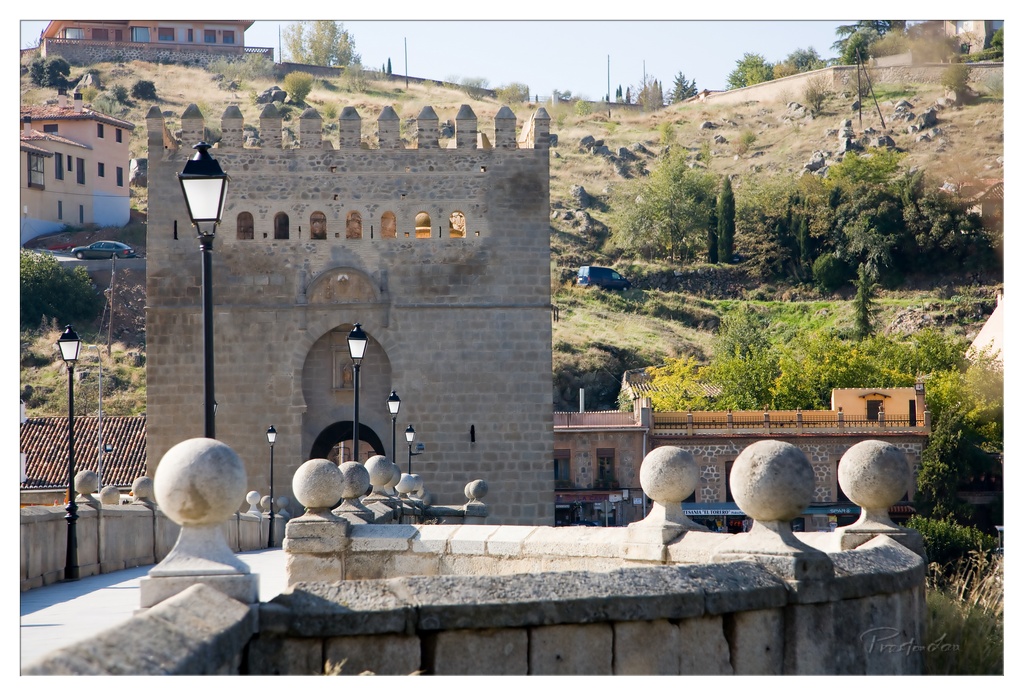

1. Overall Rating (0–10) — 7.5
This photograph captures the timeless grandeur of a historic stone gate set against a sun-drenched hillside, evoking a sense of enduring heritage and quiet dignity. The interplay of ancient architecture, modern street lamps, and the soft textures of the surrounding landscape creates a layered narrative of continuity and change. While the image is rich in detail and atmosphere, it feels slightly constrained by a lack of dramatic contrast, holding back its full emotional resonance.
2. Composition (0–10) — 7.0
The gate is centered and anchored by the stone balustrade in the foreground, creating a strong sense of depth and guiding the viewer’s eye toward the arch. The repetition of spherical finials adds rhythm, while the off-center placement of the lampposts introduces subtle asymmetry. A tighter crop might enhance focus, but the current framing effectively balances the architectural subject with its environment.
3. Lighting (0–10) — 7.5
The bright, even daylight enhances the texture of the stone and casts soft shadows that define the gate’s form. The light is warm and golden, suggesting late morning or early afternoon, which complements the earthy tones of the scene and adds a gentle, nostalgic mood.
4. Color & Tone (0–10) — 7.0
The palette is harmonious, dominated by warm beiges, tans, and muted greens, with the dark lampposts providing contrast. The tones are well-balanced and natural, though the slightly overexposed sky reduces atmospheric depth. A touch more saturation could bring out the vibrancy of the foliage and the stone’s character.
5. Creativity (0–10) — 7.0
The photograph blends historical architecture with modern elements in a thoughtfully composed frame, suggesting a narrative of time passing. The inclusion of the lampposts adds a contemporary touch that grounds the scene in the present, creating a subtle dialogue between past and present. While not radically original, the approach is deliberate and evocative.
6. Technical Quality (0–10) — 8.0
The image is sharp and clear, with excellent focus on the gate and foreground details. The depth of field is well-controlled, keeping both the balustrade and the gate in focus. The exposure is accurate, and the digital clarity is strong, with no visible noise or artifacts.
7. Emotional Impact (0–10) — 7.5
There is a quiet, contemplative quality to the image that invites reflection on history, place, and continuity. The stillness of the scene, combined with the warm light and aged textures, evokes a sense of peace and timelessness, allowing the viewer to feel a connection to the story the architecture holds.
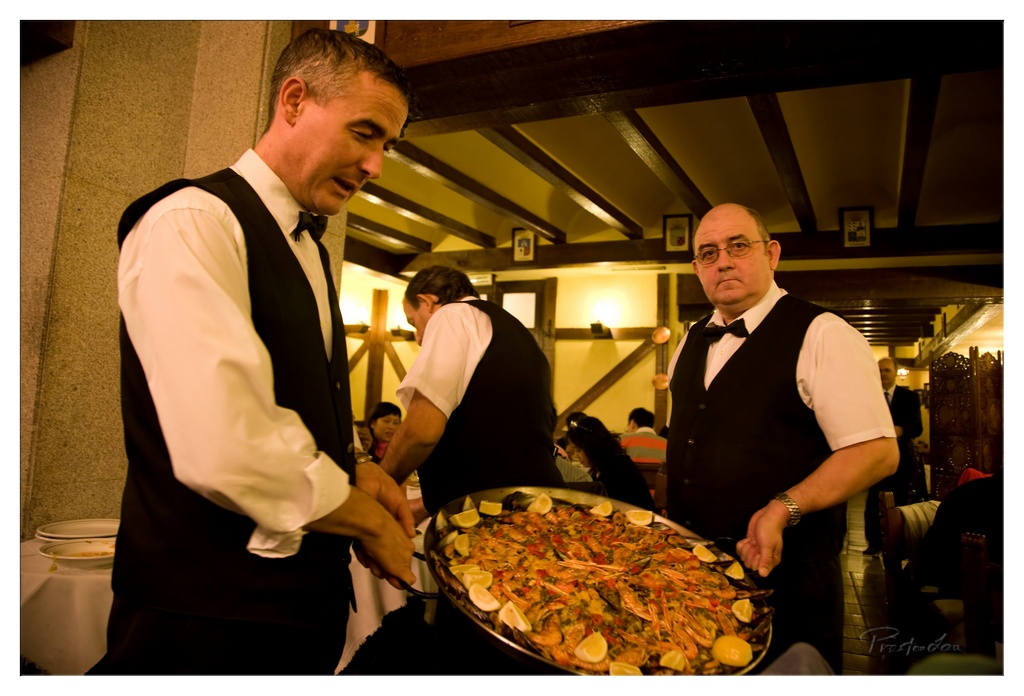

1. Overall Rating (0–10) — 7.5
This photograph captures a vibrant moment of culinary tradition, where the warmth of a Spanish restaurant comes alive through the presentation of a freshly prepared paella. The rich, golden tones and the focused expressions of the servers convey a sense of authenticity and pride in craftsmanship. While the scene is dynamic and full of character, the lighting and composition could be more refined to elevate the image beyond a mere snapshot into something more visually compelling.
2. Composition (0–10) — 7.0
The diagonal line of the paella pan draws the eye across the frame, while the two waiters create a balanced, human-centered arrangement. The background activity adds context without distracting, though the slight clutter on the left edge slightly weakens the visual flow.
3. Lighting (0–10) — 7.5
The warm, ambient lighting enhances the golden hues of the food and the wood-toned interior, creating a cozy, inviting atmosphere. The use of a flash on the main subject adds dimension, though it slightly flattens the background.
4. Color & Tone (0–10) — 8.0
The color palette is rich and cohesive, dominated by warm yellows, deep browns, and the bright contrast of the lemon wedges. The tone is consistent with a traditional, rustic dining experience, and the saturation enhances the visual appeal without appearing unnatural.
5. Creativity (0–10) — 7.5
The image successfully captures a moment of cultural storytelling—showcasing both the food and the people behind it. The candid nature of the scene adds authenticity, and the choice to frame the paella as the centerpiece makes it feel both celebratory and intimate.
6. Technical Quality (0–10) — 8.0
Sharp focus on the foreground subjects and the paella ensures clarity, while the depth of field effectively separates the main action from the background. The exposure is well-balanced, with no significant areas of over- or underexposure.
7. Emotional Impact (0–10) — 8.0
The image evokes a strong sense of warmth, hospitality, and cultural pride. The expressions of the servers—focused, proud, and engaged—invite the viewer into a shared experience, making the moment feel both personal and universal.
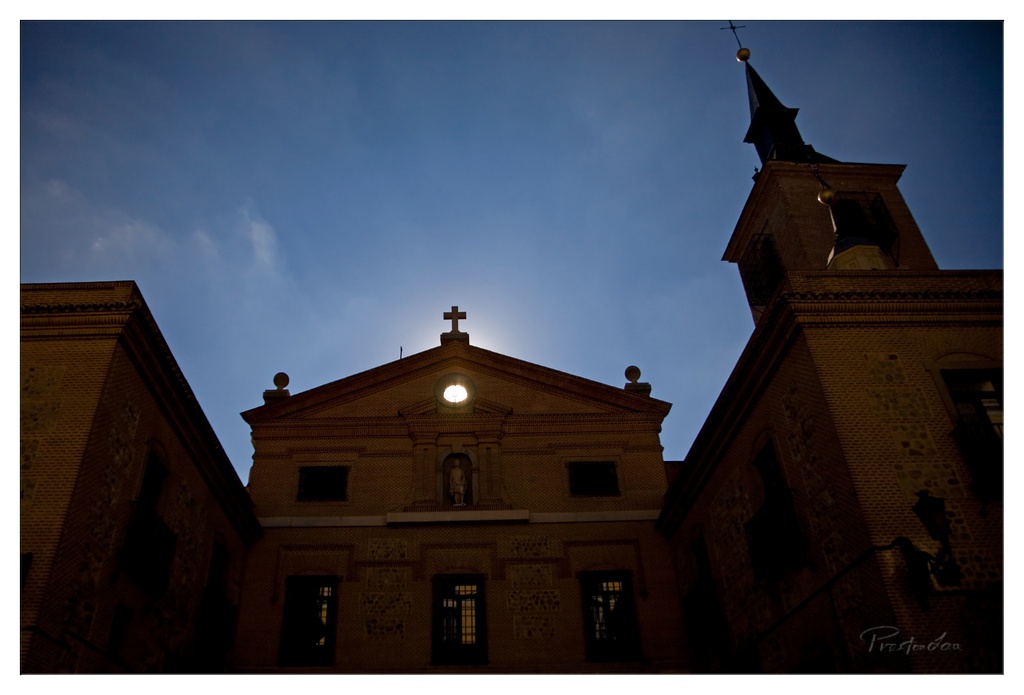

1. Overall Rating (0–10) — 7.5
This photograph captures a striking interplay between light and shadow, evoking a sense of reverence and timelessness in the quiet hour before dawn. The silhouette of the church against the deep blue sky creates a powerful, almost spiritual atmosphere, while the glowing light at the center of the façade draws the eye like a beacon. Though the scene is compelling, the heavy shadows limit detail in the architectural textures, slightly diminishing the image’s visual richness.
2. Composition (0–10) — 8.0
The low-angle perspective emphasizes the grandeur of the church, with the steeple and cross guiding the eye upward. The central placement of the illuminated window creates a natural focal point, balanced by the surrounding structure, though the left side feels slightly more dominant due to the building’s mass.
3. Lighting (0–10) — 9.0
The use of backlighting creates a dramatic silhouette, with the soft glow of the window and the subtle illumination of the sky adding depth and mood. The contrast between the dark architecture and the luminous sky enhances the sacred atmosphere, while the moon or artificial light behind the cross adds symbolic weight.
4. Color & Tone (0–10) — 8.0
The deep indigo of the twilight sky contrasts beautifully with the warm, golden light of the window, creating a harmonious and evocative palette. The tonal range is rich, with the cool shadows and warm highlights reinforcing the image’s contemplative mood.
5. Creativity (0–10) — 8.5
The photographer captures a moment of quiet beauty with strong visual storytelling. The choice of timing and angle transforms a simple architectural scene into a meditative, almost sacred image, suggesting a deeper narrative beyond the physical structure.
6. Technical Quality (0–10) — 8.0
The image is sharp and well-exposed, with clear detail in the sky and a balanced exposure on the illuminated elements. The dark areas retain texture without becoming pure black, indicating careful control of the camera settings.
7. Emotional Impact (0–10) — 8.5
The image conveys a profound sense of peace and reverence, inviting the viewer to pause and reflect. The combination of light, shadow, and sacred architecture evokes a quiet awe, making it emotionally resonant and memorable.
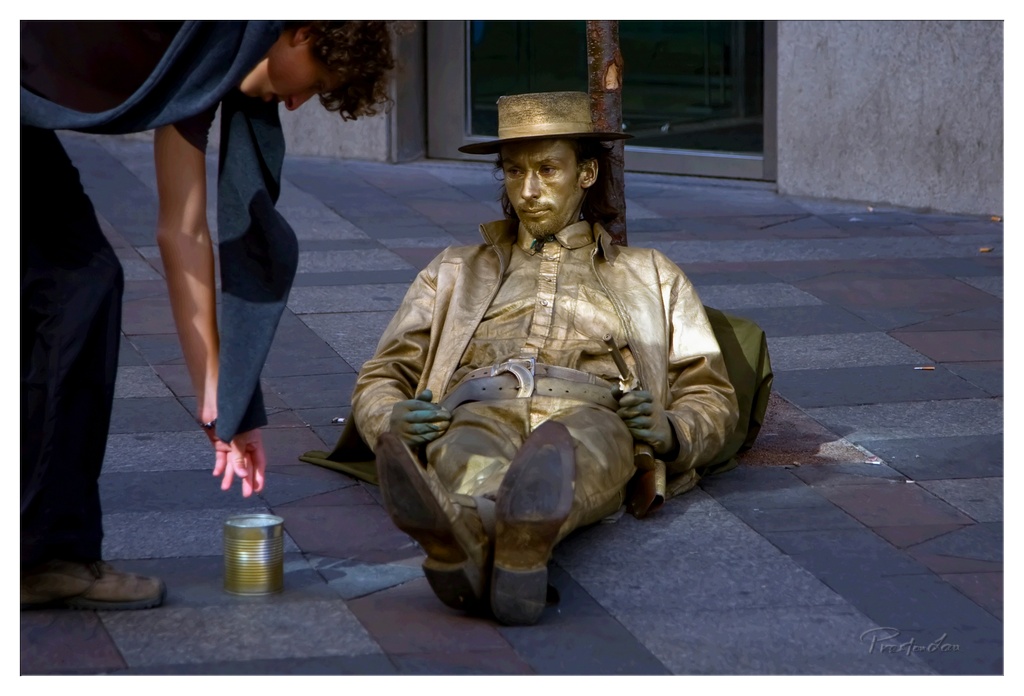

1. Overall Rating (0–10) — 7.0
This photograph captures a striking moment of urban performance art, where a street performer painted gold sits motionless like a living statue, creating a powerful contrast with the fleeting interaction of a passerby. The image balances stillness and motion, inviting reflection on the relationship between art, labor, and public engagement. While the composition and lighting are compelling, the slightly awkward framing and overexposed highlights slightly diminish its overall impact.
2. Composition (0–10) — 6.5
The subject is well-centered, drawing attention to the golden figure, while the leaning passerby creates a dynamic diagonal that guides the eye. However, the tight crop and uneven placement of the can slightly disrupt the visual harmony.
3. Lighting (0–10) — 7.0
Natural daylight enhances the metallic sheen of the gold paint, creating rich reflections and depth. The shadows are well-defined, adding dimension, though some areas of the figure are overexposed, washing out detail.
4. Color & Tone (0–10) — 7.5
The dominant golden tones create a striking visual contrast against the muted urban background, evoking a sense of surrealism. The color palette is cohesive, with the warm golds complementing the cool grays of the pavement.
5. Creativity (0–10) — 8.0
The concept of a human statue is inherently creative, and the artist’s use of gold paint transforms the ordinary into the extraordinary. The interaction with the donor adds a layer of narrative and social commentary, elevating the image beyond mere documentation.
6. Technical Quality (0–10) — 7.0
The image is sharp and detailed, particularly in the textures of the gold paint and clothing. However, slight overexposure in the highlights and minor noise in the shadows reduce technical perfection.
7. Emotional Impact (0–10) — 7.0
The image evokes curiosity and subtle empathy, capturing a quiet, fleeting human connection in a public space. The stillness of the performer contrasts with the motion of the donor, creating a poignant moment that lingers in the viewer’s mind.
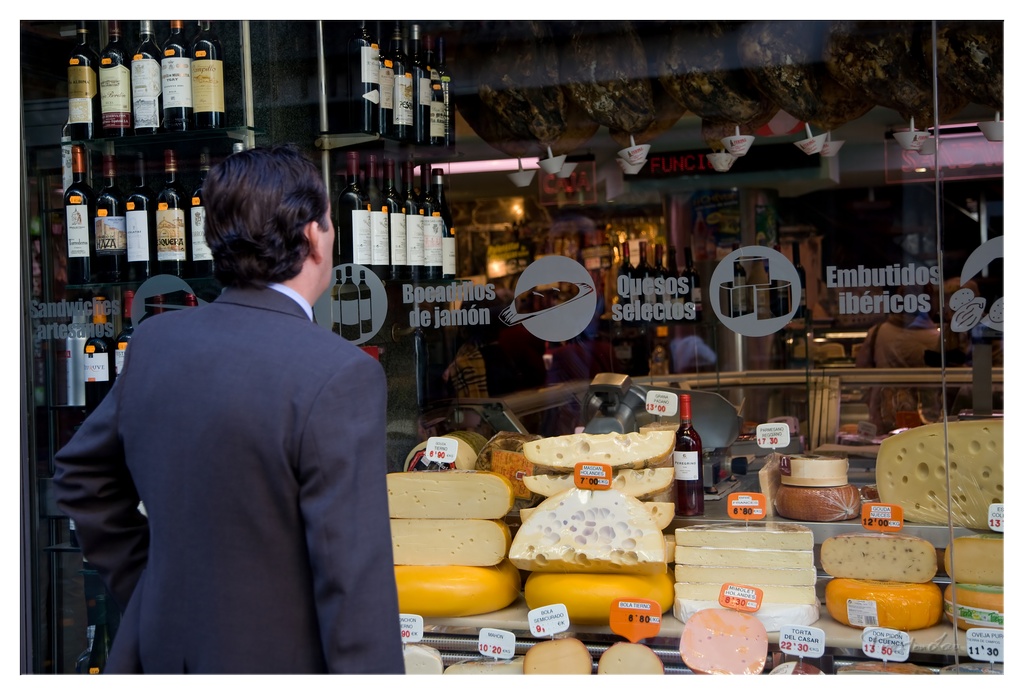

1. Overall Rating (0–10) — 7.0
This photograph captures a quiet, contemplative moment in a bustling European city, where a man in a suit pauses before a traditional deli window brimming with cheese and wine. The image succeeds in blending urban life with artisanal culture, creating a narrative of everyday elegance. While the composition is strong and the subject matter rich, the reflection in the glass slightly disrupts the clarity, keeping the image from achieving full visual harmony.
2. Composition (0–10) — 7.5
The man’s back is positioned to the left, creating a natural leading line toward the vibrant display of cheeses and wines, guiding the viewer’s eye through the frame. The use of the window as a reflective surface adds depth, though the reflections do compete slightly with the main subject.
3. Lighting (0–10) — 6.5
Natural daylight illuminates the scene from the front, casting soft shadows and highlighting the textures of the cheese and wine bottles. The interior lighting provides warmth, but the reflection of overhead lights in the glass introduces minor glare, reducing overall clarity.
4. Color & Tone (0–10) — 7.0
The warm, earthy tones of the cheese and wood shelves contrast beautifully with the cool blue-gray of the man’s suit, creating a balanced and inviting palette. The orange price tags add a pop of color that draws attention to specific products, enhancing visual interest.
5. Creativity (0–10) — 7.0
The photograph captures a moment of quiet observation, transforming an ordinary street scene into a story of cultural appreciation. The interplay between the man’s formal attire and the rustic shop window suggests a narrative of tradition meeting modernity.
6. Technical Quality (0–10) — 7.5
The image is sharp and well-focused, particularly on the cheese and wine display, with clear detail in the labels and textures. The exposure is well-managed, and the depth of field effectively separates the subject from the background.
7. Emotional Impact (0–10) — 6.5
The image evokes a sense of curiosity and nostalgia, inviting the viewer to imagine the flavors and stories behind the products. While the emotional resonance is subtle, it is grounded in the authenticity of the moment.
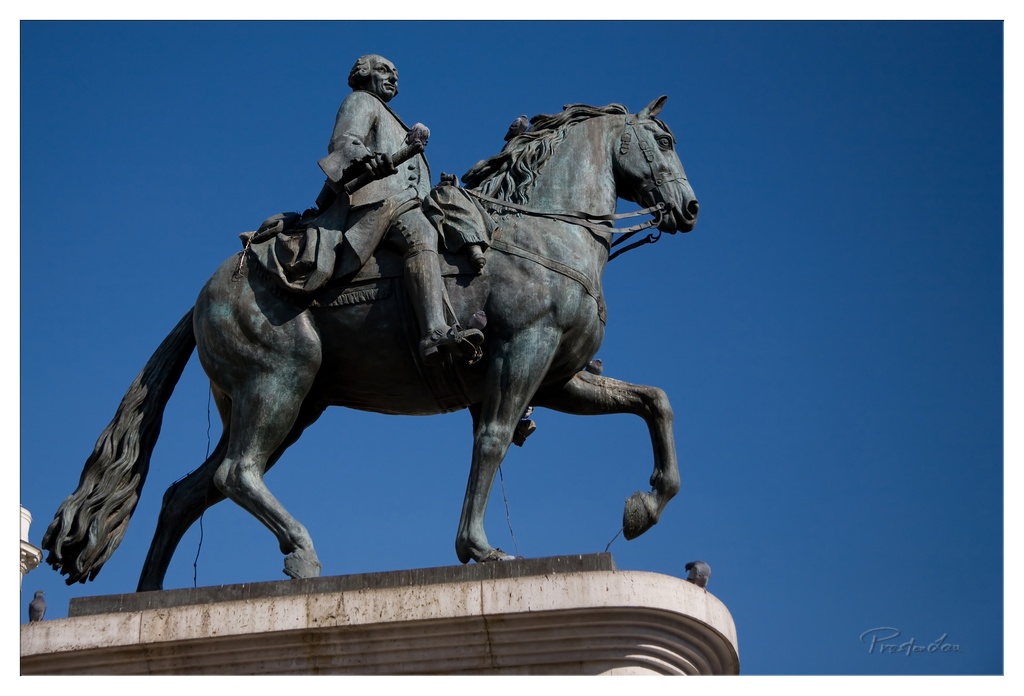

1. Overall Rating (0–10) — 7.8
This photograph captures the commanding presence of a bronze equestrian statue against a vast, cloudless blue sky, evoking a sense of historical grandeur and timelessness. The bold contrast between the dark, weathered patina of the sculpture and the deep azure background creates a powerful visual statement, while the low-angle perspective enhances the monument’s stature. A slight underexposure in the statue’s shadowed areas reduces detail, and the presence of pigeons on the base introduces a subtle modern intrusion, tempering the idealized historical mood.
2. Composition (0–10) — 8.0
The low-angle shot emphasizes the monument’s dominance, with the statue positioned slightly off-center to create dynamic tension. The clean negative space of the sky balances the visual weight of the sculpture, while the curved edge of the pedestal grounds the image, guiding the eye upward toward the rider.
3. Lighting (0–10) — 8.5
Bright, direct sunlight highlights the texture and form of the bronze, casting defined shadows that accentuate the horse’s musculature and the rider’s posture. The clear, unobstructed sky provides a uniform backdrop, enhancing the sculpture’s silhouette and creating a dramatic, sunlit contrast.
4. Color & Tone (0–10) — 8.0
The rich, saturated blue of the sky creates a striking contrast with the verdigris and dark tones of the bronze, resulting in a bold, harmonious palette. The tonal range is well-balanced, with the deep shadows adding depth while preserving detail in the highlights.
5. Creativity (0–10) — 7.5
The image leverages classic monument photography techniques with a modern, slightly cinematic edge. The low angle and bold color contrast elevate a familiar subject into a more monumental and evocative portrayal, suggesting a narrative of legacy and power.
6. Technical Quality (0–10) — 8.5
Sharp focus and precise exposure capture the fine textures of the bronze and the clarity of the sky. The composition is well-executed, and the image remains free of noise or artifacts, demonstrating strong technical control.
7. Emotional Impact (0–10) — 7.0
The photograph inspires awe and reverence, evoking the weight of history and the enduring power of public memory. While the emotional resonance is strong, the slight intrusion of the pigeons and the starkness of the lighting keep the viewer from fully immersing in the monument’s narrative.
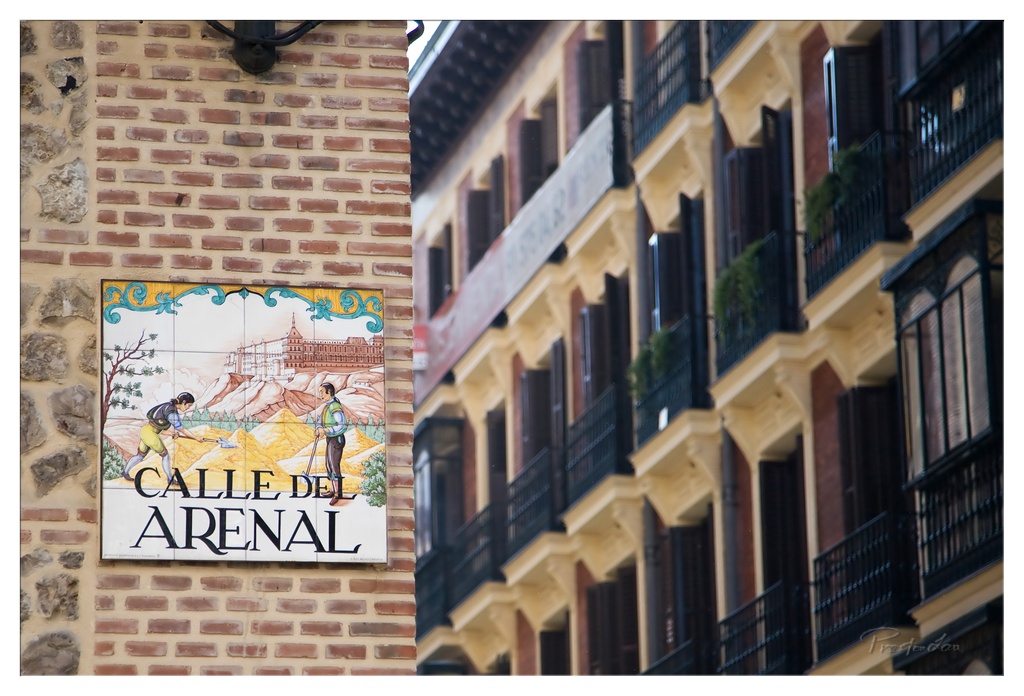

1. Overall Rating (0–10) — 7.5
This photograph captures the soul of a historic European street with a delicate balance of texture, color, and narrative. The ceramic tile sign, rich in detail and tradition, draws the eye as a focal point against the weathered brick and stone, while the softly blurred architecture in the background adds depth and context. The image succeeds in evoking a sense of place—timeless and lived-in—though the shallow depth of field slightly limits the full environmental story.
2. Composition (0–10) — 7.0
The tile sign is well-placed off-center, creating visual interest and guiding the viewer’s gaze toward the softly blurred buildings. The diagonal lines of the balconies enhance the sense of depth, though the left edge feels slightly crowded by the stone wall.
3. Lighting (0–10) — 7.5
Natural daylight provides even, soft illumination, enhancing the warmth of the brick and the vibrancy of the tile’s colors. The gentle shadows add dimension without overpowering the scene.
4. Color & Tone (0–10) — 8.0
The palette is rich and harmonious, with warm terracotta tones complemented by the soft yellows and greens of the tile. The contrast between the vivid sign and the muted background creates a pleasing visual hierarchy.
5. Creativity (0–10) — 8.0
The use of selective focus to isolate the street sign while blurring the background is a strong artistic choice, emphasizing the cultural and historical significance of the location. The storytelling through the tile’s imagery—depicting figures and a distant fortress—adds a layer of narrative depth.
6. Technical Quality (0–10) — 8.5
Sharp focus on the tile sign ensures clarity and detail, while the smooth bokeh in the background demonstrates excellent control of aperture and focus. The image is clean, well-exposed, and free of distracting artifacts.
7. Emotional Impact (0–10) — 7.0
The photograph evokes a quiet sense of nostalgia and appreciation for cultural heritage. The viewer is invited to imagine the stories behind the sign and the lives lived in the surrounding buildings, creating a subtle but meaningful emotional resonance.
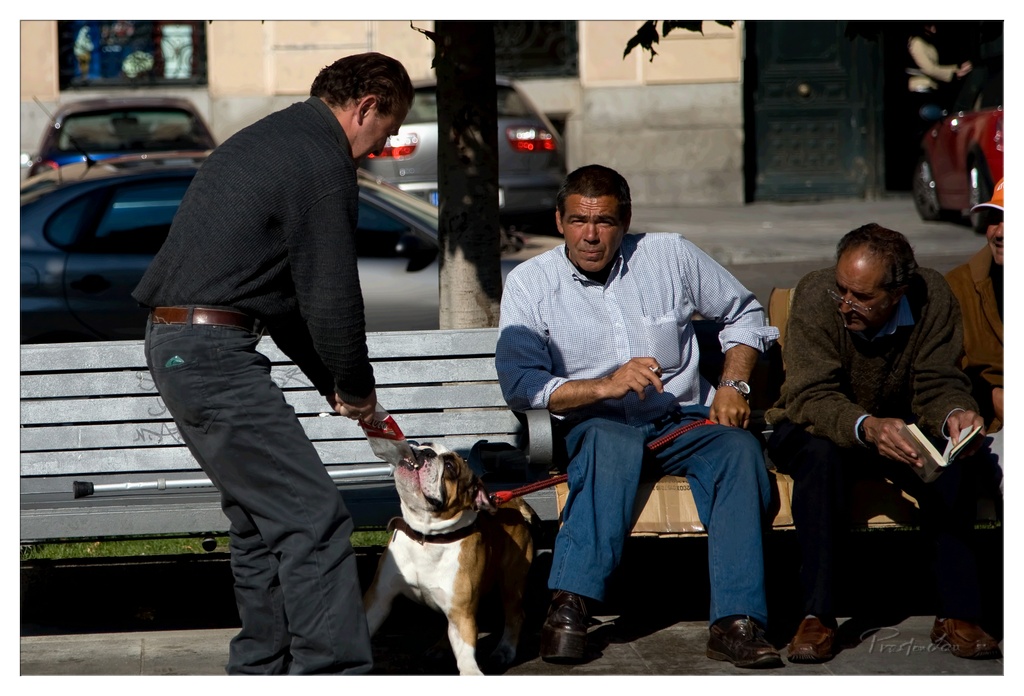

1. Overall Rating (0–10) — 7.0
This photograph captures a candid moment of urban life, where the quiet interaction between a man and his dog contrasts with the passive observation of bystanders. The interplay of light and shadow adds depth, while the composition subtly frames a narrative of connection and detachment. Though the scene feels authentic and grounded, a more dynamic angle or tighter framing could elevate its visual impact.
2. Composition (0–10) — 6.5
The diagonal line of the standing man and dog creates visual movement, drawing the eye through the frame. However, the bench’s horizontal lines compete with the central action, and the background clutter slightly distracts from the main subject.
3. Lighting (0–10) — 7.5
Strong directional sunlight creates crisp highlights and deep shadows, enhancing texture and form. The contrast between the illuminated dog and the shaded figures adds dramatic tension, grounding the image in a specific time of day.
4. Color & Tone (0–10) — 6.5
The palette is natural and subdued, with muted blues, grays, and earth tones that reflect the urban environment. While the colors are consistent, they lack vibrancy, giving the image a slightly flat, documentary feel.
5. Creativity (0–10) — 7.0
The image succeeds in capturing a fleeting, unposed moment with a strong narrative quality. The juxtaposition of active and passive figures suggests a story beyond the frame, making it more than a simple street snapshot.
6. Technical Quality (0–10) — 8.0
Sharp focus on the dog and the man’s hand, with good detail in the textures of clothing and wood, indicates strong technical execution. The exposure is well-balanced, preserving detail in both highlights and shadows.
7. Emotional Impact (0–10) — 6.5
The scene evokes a sense of quiet observation and urban solitude. While the emotional resonance is present, the viewer remains somewhat detached, as the subjects appear absorbed in their own worlds rather than engaging with the camera.
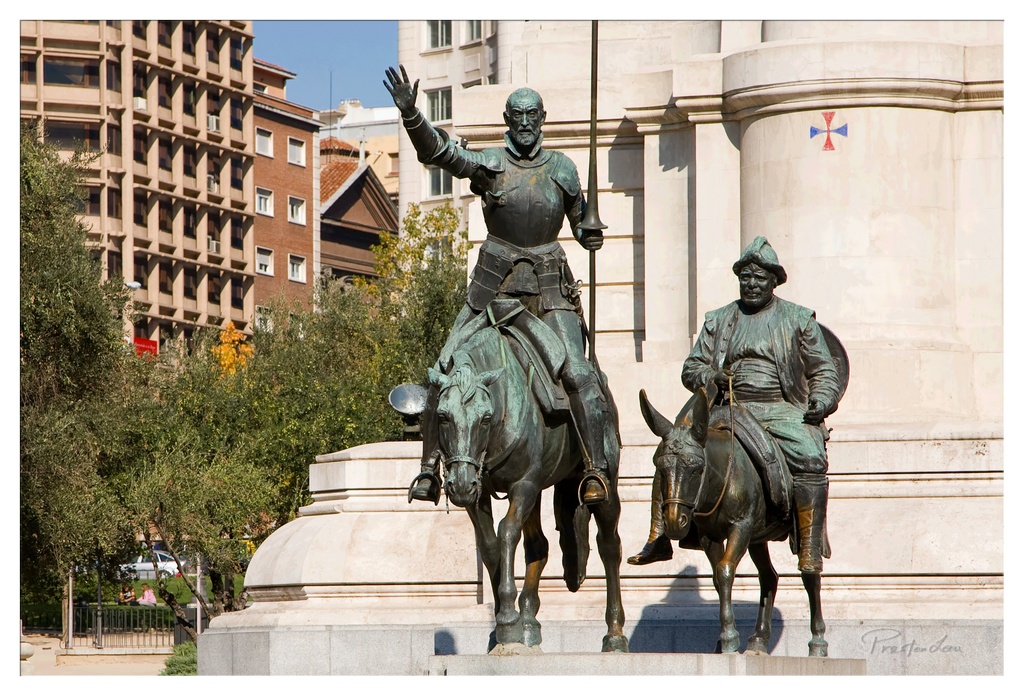

1. Overall Rating (0–10) — 7.0
This photograph captures a striking juxtaposition between historical monument and urban life, where the imposing bronze statues stand as silent witnesses to the city’s evolution. The contrast between the weathered patina of the figures and the modern buildings in the background creates a compelling narrative of time and memory. While the composition is strong, the slightly cluttered foreground and uneven lighting temper its overall impact, leaving the viewer with a sense of potential unfulfilled.
2. Composition (0–10) — 6.5
The statues are well-framed, with the larger equestrian figure drawing immediate attention, while the smaller figure on the donkey adds narrative depth. However, the intrusion of the tree and fence on the left edge disrupts the visual flow, and the background architecture feels slightly overbearing, pulling focus from the central subjects.
3. Lighting (0–10) — 7.0
The bright daylight enhances the texture of the bronze, highlighting the verdigris and the sculptural details. The shadows cast by the figures are crisp and directional, adding dimension, though the harshness of the sun slightly flattens the tones in the background.
4. Color & Tone (0–10) — 6.5
The dominant palette of green patina, beige stone, and muted urban tones creates a cohesive, earthy mood. The blue sky offers a subtle contrast, but the overall tonal range lacks vibrancy, resulting in a slightly subdued atmosphere.
5. Creativity (0–10) — 7.0
The choice to photograph this historical monument within a contemporary urban context demonstrates thoughtful storytelling. The inclusion of the modern building and the red cross emblem on the column adds layers of meaning, suggesting a dialogue between past and present.
6. Technical Quality (0–10) — 7.5
The image is sharp and well-focused, with clear detail in the statues and background. The exposure is balanced, capturing both highlights and shadows effectively, though the slight overexposure in the sky slightly diminishes the overall technical finesse.
7. Emotional Impact (0–10) — 6.5
The photograph evokes a contemplative mood, inviting reflection on legacy and change. While the emotional resonance is present, it remains somewhat restrained by the lack of dynamic lighting and a more immersive composition.
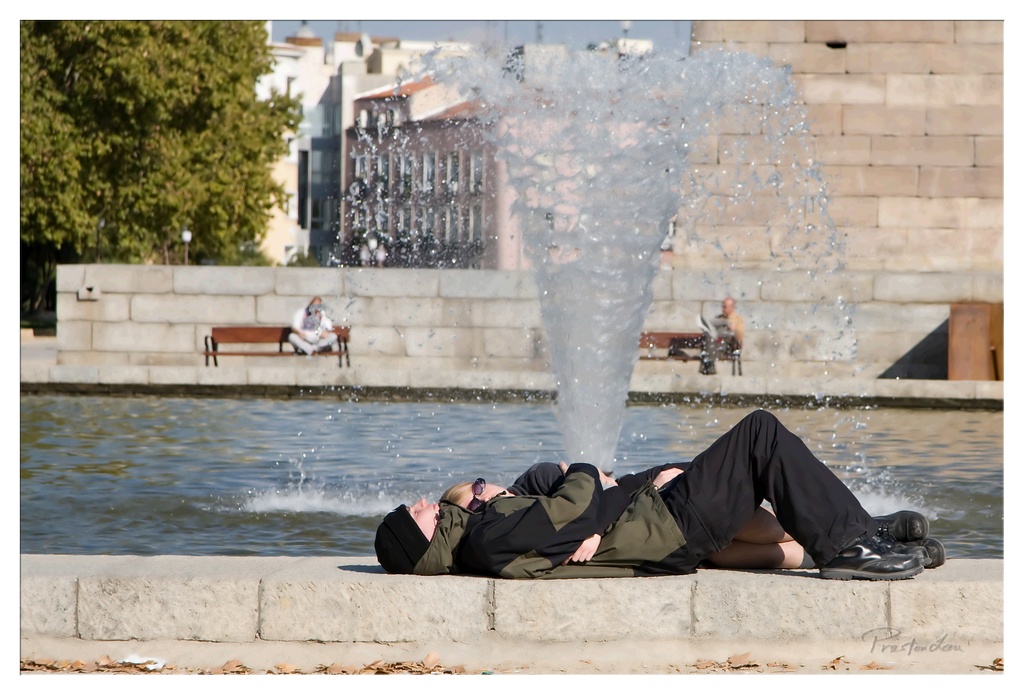

1. Overall Rating (0–10) — 7.0
This photograph captures a serene yet dynamic moment of two people resting by a fountain, where motion and stillness coexist in harmony. The cascading water creates a natural focal point, while the relaxed posture of the subjects conveys intimacy and tranquility. Though the background details add context, the image's emotional warmth is slightly tempered by a lack of visual cohesion between the foreground and midground.
2. Composition (0–10) — 7.0
The subjects are placed off-center, creating a balanced asymmetry that draws the eye across the frame. The fountain's arc acts as a natural leading line, guiding the viewer toward the couple while framing the background activity.
3. Lighting (0–10) — 7.5
Natural daylight illuminates the scene with soft, even light, enhancing the clarity of the water spray and the texture of the stone. The sun's angle casts gentle shadows, adding depth without overwhelming contrast.
4. Color & Tone (0–10) — 6.5
The palette is dominated by muted earth tones—olive, gray, and brown—giving the image a grounded, autumnal feel. While the colors are harmonious, they lack vibrancy, which slightly diminishes the visual impact of the water's sparkle.
5. Creativity (0–10) — 7.0
The juxtaposition of movement and stillness, along with the candid intimacy of the couple, lends the image a narrative quality. The photographer captures a fleeting, personal moment within a public space, offering a quiet commentary on urban life.
6. Technical Quality (0–10) — 8.0
The image is sharp and well-focused, particularly on the couple and the water spray. The depth of field effectively isolates the subjects while keeping the background context visible.
7. Emotional Impact (0–10) — 7.5
There is a palpable sense of peace and connection between the two individuals, enhanced by the gentle motion of the fountain. The viewer is invited to pause and reflect on quiet moments of companionship amidst the rhythm of city life.
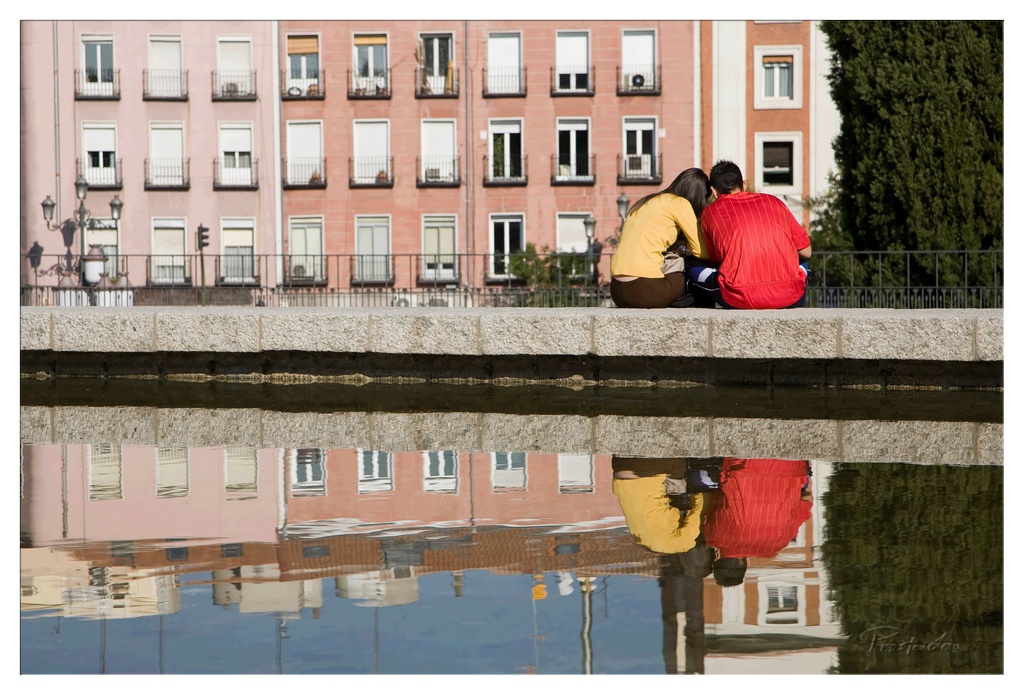

1. Overall Rating (0–10) — 7.5
This photograph captures a tender, intimate moment between two people seated by a calm waterway, mirrored in the still surface below. The symmetry of the reflection doubles the emotional weight of the scene, while the warm, sunlit tones of the surrounding architecture lend a quiet, contemplative mood. The composition is strong, but the slight distraction of the watermark and the overly busy background detract from the image’s overall elegance.
2. Composition (0–10) — 8.0
The image is anchored by a powerful horizontal symmetry, with the couple and their reflection creating a balanced, harmonious structure. The placement of the subjects slightly off-center adds visual interest, while the surrounding architecture frames the scene without overwhelming it.
3. Lighting (0–10) — 7.5
Natural daylight bathes the scene in a warm, golden glow, enhancing the textures of the stone and the softness of the reflection. The light is evenly distributed, allowing for rich detail in both the subjects and the background, with just enough contrast to define form.
4. Color & Tone (0–10) — 7.0
The warm terracotta tones of the building contrast beautifully with the cool blues and greens of the water and foliage. The color palette is harmonious and evocative, though the vibrancy of the red and yellow clothing slightly dominates the scene, pulling focus from the more subtle mood.
5. Creativity (0–10) — 8.0
The use of reflection as a compositional and emotional device is both clever and effective. The image transcends a simple snapshot by transforming a quiet moment into a layered visual narrative, where reality and its mirrored echo coexist.
6. Technical Quality (0–10) — 8.0
The image is sharp and well-focused, with fine detail visible in both the foreground and background. The exposure is balanced, and the water’s stillness allows for a clear, almost perfect reflection—demonstrating technical control and patience.
7. Emotional Impact (0–10) — 8.0
The intimacy of the moment—two people leaning together, heads close—resonates deeply, amplified by the symmetry of the reflection. The scene feels private, timeless, and quietly joyful, inviting the viewer to pause and reflect on connection and stillness.
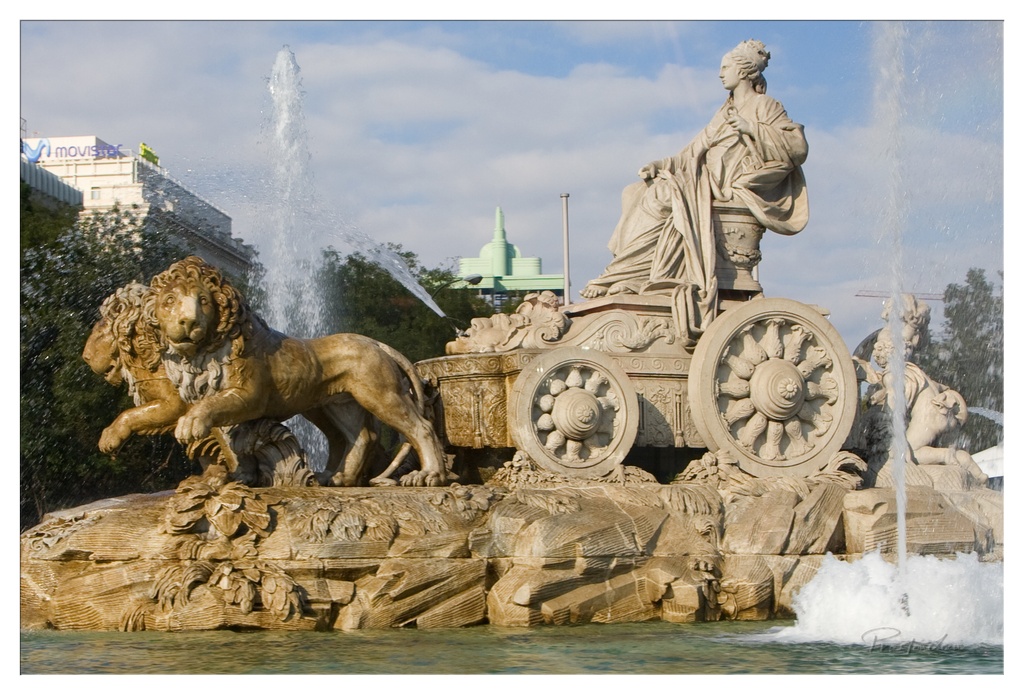

1. Overall Rating (0–10) — 7.5
This photograph captures the grandeur of a classical fountain with a striking juxtaposition of historical artistry and modern urban life. The interplay of motion—water spraying from multiple jets—and the stillness of the sculptural figures creates a dynamic yet harmonious scene. While the presence of the "Movistar" sign intrudes slightly, the image successfully balances the monument’s timeless elegance with the vitality of its city setting, offering a compelling narrative of continuity and contrast.
2. Composition (0–10) — 7.0
The central placement of the statue and the diagonal flow of the water jets guide the eye across the frame, creating a sense of movement. The lion sculpture on the left provides a strong visual anchor, while the background buildings add depth, though the inclusion of the modern signage slightly disrupts the historical tone.
3. Lighting (0–10) — 7.5
Natural daylight illuminates the scene evenly, enhancing the texture and detail of the stone sculptures. The soft shadows and bright highlights on the water add dimension, while the overcast sky prevents harsh contrasts, contributing to a balanced and atmospheric quality.
4. Color & Tone (0–10) — 6.5
The palette is dominated by warm earth tones in the stone, complemented by the cool blue of the sky and the white spray of water. While the colors are natural and cohesive, the overall tone leans slightly muted, which slightly dampens the vibrancy of the scene.
5. Creativity (0–10) — 7.0
The image demonstrates thoughtful composition by framing the fountain in a way that highlights both its sculptural beauty and its urban context. The inclusion of modern elements within a classical setting adds a layer of narrative depth, suggesting a dialogue between past and present.
6. Technical Quality (0–10) — 8.0
The photograph is sharp and well-focused, particularly on the central statue and the lion. The exposure is well-managed, capturing detail in both the bright water spray and the shaded areas of the sculpture. The resolution and clarity are strong, with minimal noise.
7. Emotional Impact (0–10) — 7.0
The image evokes a sense of awe and reverence for the craftsmanship of the fountain, while the modern cityscape in the background grounds it in reality. It invites contemplation on the persistence of art in everyday life, creating a quiet emotional resonance between history and the present.
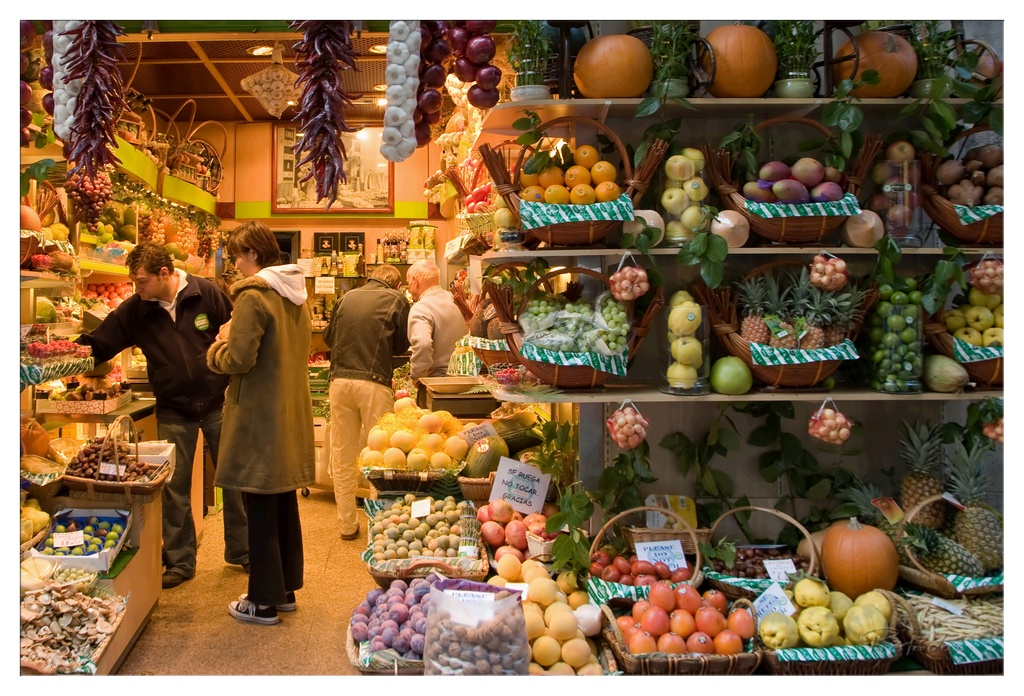

1. Overall Rating (0–10) — 7.5
This photograph bursts with the vibrant energy of a bustling market, where color, texture, and life converge in a richly layered scene. The abundance of produce and the presence of shoppers lend authenticity and warmth, capturing the essence of daily commerce with a painterly sensibility. While the visual density borders on chaotic, the image succeeds in conveying a sense of abundance and human connection, though a more deliberate focal point might enhance its narrative clarity.
2. Composition (0–10) — 7.0
The framing captures a wide view of the market stall, with a diagonal flow from the lower right to the upper left guiding the eye through the layers of fruit and people. The central figures are well-placed, but the sheer volume of elements creates a slightly cluttered feel, reducing visual hierarchy.
3. Lighting (0–10) — 6.5
Warm, ambient lighting enhances the richness of the produce and creates a welcoming, intimate atmosphere. However, some areas, particularly in the background, appear slightly overexposed, diminishing detail in the upper shelves.
4. Color & Tone (0–10) — 8.0
A vivid and harmonious palette of oranges, greens, purples, and yellows creates a visually stimulating experience. The natural tones of the fruit are rendered with richness and depth, and the warm color cast adds a sense of life and vitality.
5. Creativity (0–10) — 7.5
The image feels both documentary and artistic, blending realism with a keen eye for composition and color. The inclusion of hanging peppers and grapes adds a decorative, almost ceremonial touch, elevating the scene beyond a simple snapshot.
6. Technical Quality (0–10) — 7.5
Sharp focus across the frame ensures clarity in both the foreground produce and the background details. The exposure is generally well-managed, though slight overexposure in highlights suggests room for refinement in dynamic range.
7. Emotional Impact (0–10) — 7.0
The photograph evokes a sense of warmth, abundance, and community, inviting the viewer into a moment of shared experience. While the emotional resonance is strong, the visual busyness tempers the intimacy, keeping the viewer as an observer rather than a participant.
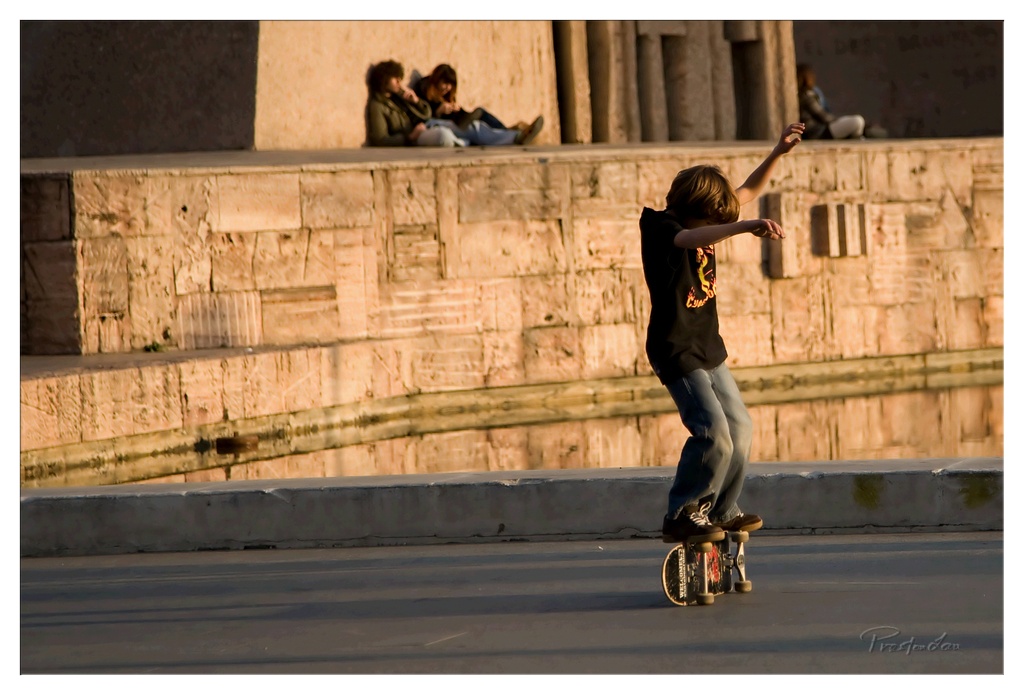

1. Overall Rating (0–10) — 7.0
This photograph captures a candid moment of youthful energy and urban freedom, with a skateboarder mid-motion against the warm glow of late afternoon light. The golden hue infuses the scene with a sense of nostalgia and movement, while the blurred figures in the background add depth and context without distracting from the main subject. While the image is visually engaging and emotionally resonant, the composition and lighting, though effective, remain grounded in realism rather than pushing into the realm of poetic or dramatic expression.
2. Composition (0–10) — 6.5
The skateboarder is placed slightly off-center, creating dynamic tension and emphasizing motion. The low angle and leading lines of the wall guide the eye toward the subject, though the background elements are slightly cluttered, risking distraction.
3. Lighting (0–10) — 8.0
The warm, directional sunlight creates long shadows and highlights the subject’s silhouette, adding depth and a cinematic quality. The golden hour lighting enhances the mood and draws attention to the movement and energy of the scene.
4. Color & Tone (0–10) — 7.5
The warm, earthy tones of the stone wall and pavement harmonize with the golden light, creating a cohesive and inviting palette. The contrast between the sunlit foreground and the cooler shadows adds visual interest and supports the narrative of motion and time.
5. Creativity (0–10) — 7.0
The image successfully captures a fleeting, authentic moment of urban life, blending action and atmosphere with a sense of narrative. While not highly experimental, it demonstrates a strong understanding of timing and mood, resulting in a compelling, story-driven photograph.
6. Technical Quality (0–10) — 7.5
The focus is sharp on the skateboarder, with a well-managed depth of field that blurs the background slightly. The exposure is balanced, preserving detail in both highlights and shadows, and the image is free of significant noise or distortion.
7. Emotional Impact (0–10) — 7.0
The photograph evokes a sense of freedom, youth, and spontaneity, drawing the viewer into a fleeting moment of joy and motion. The warmth of the light and the subject’s posture combine to create a nostalgic, almost cinematic feeling that resonates on a personal level.
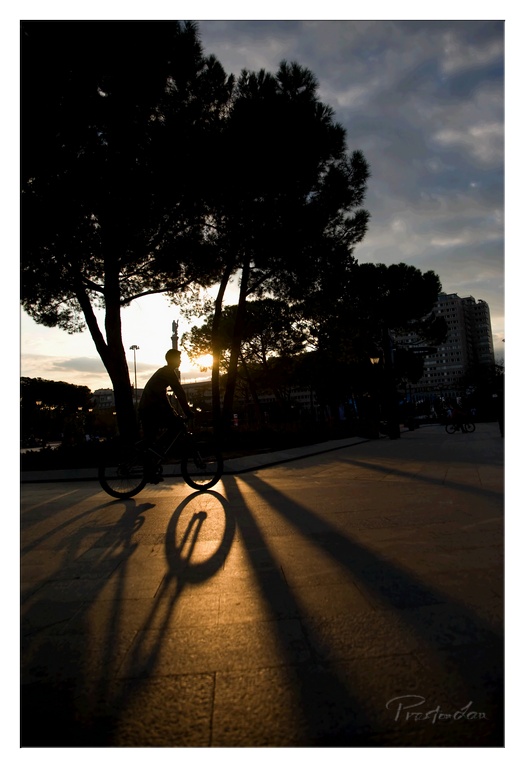

1. Overall Rating (0–10) — 8.0
This photograph captures a moment of quiet motion at dusk, where the interplay of light and shadow transforms an ordinary scene into something poetic. The silhouette of the cyclist, framed against the golden glow of the setting sun, evokes a sense of journey and transience. While the composition is strong and the mood is deeply atmospheric, the slight overexposure in the sky and the heavy black of the silhouette slightly reduce the image’s subtlety and tonal range.
2. Composition (0–10) — 8.5
The low-angle perspective draws the viewer into the scene, with the long shadows creating strong leading lines that guide the eye toward the cyclist. The silhouetted trees on the left balance the composition, while the diagonal of the shadows adds dynamism. The cyclist is placed off-center, creating a natural and engaging focal point.
3. Lighting (0–10) — 9.0
The use of backlighting from the setting sun creates a dramatic silhouette and casts elongated, textured shadows across the pavement. The warm golden hour light enhances the mood, while the contrast between light and dark adds depth and visual interest. The exposure is well-handled, emphasizing the glow of the sun without completely losing detail in the sky.
4. Color & Tone (0–10) — 7.5
The warm, golden tones of the sunset contrast beautifully with the deep black of the silhouettes, creating a rich, cinematic palette. While the color temperature is appropriate for the time of day, the overall tone is slightly cool, giving the image a muted, almost monochromatic feel that limits the vibrancy of the colors.
5. Creativity (0–10) — 8.0
The photographer captures a universal moment—someone riding a bike at sunset—but transforms it into a contemplative, almost cinematic image through thoughtful composition and lighting. The elongated shadows and silhouettes add a layer of storytelling, suggesting movement, time, and the quiet rhythm of urban life.
6. Technical Quality (0–10) — 8.0
The image is sharp and well-focused, with clear definition in the shadows and a clean, noise-free capture. The low ISO and appropriate shutter speed contribute to the clarity, though the high contrast suggests some detail may be lost in the deep shadows.
7. Emotional Impact (0–10) — 8.5
The image evokes a sense of calm, nostalgia, and quiet contemplation. The solitary figure, the soft light, and the elongated shadows create a mood that feels both intimate and expansive, resonating with the viewer on a personal level and inviting reflection on fleeting moments in time.
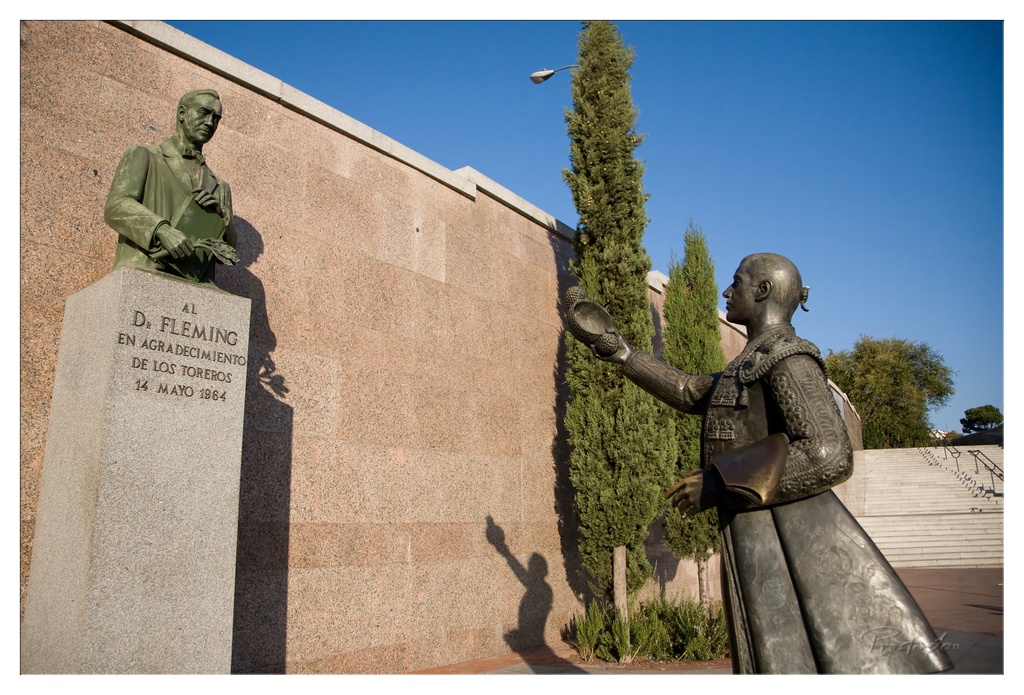

1. Overall Rating (0–10) — 7.0
This photograph captures a striking juxtaposition between two bronze statues—one of a scholar and one of a bullfighter—set against a sunlit stone wall under a clear blue sky. The composition creates a subtle narrative tension between intellect and tradition, enhanced by the strong shadows and vivid contrast. While the image is visually compelling and rich in cultural symbolism, the slightly cluttered background and uneven lighting detract from its overall harmony.
2. Composition (0–10) — 7.5
The statues are framed with strong diagonal lines created by the wall and the angle of the shot, guiding the eye from the seated figure to the standing one. The placement of the bullfighter statue in the foreground adds depth, though the inclusion of the staircase and lamppost on the right introduces a slight visual distraction.
3. Lighting (0–10) — 8.0
The bright, direct sunlight enhances the metallic textures of the statues and casts long, defined shadows, creating a sense of time and place. The contrast between light and shadow adds drama and dimension, especially on the textured stone wall.
4. Color & Tone (0–10) — 7.0
The warm tones of the granite wall complement the green patina of the statues, while the deep blue sky provides a strong, vivid backdrop. The overall palette is harmonious, though the high saturation slightly emphasizes the contrast between the man-made structures and the natural elements.
5. Creativity (0–10) — 7.5
The photographer captures a compelling cultural dialogue between two figures of Spanish heritage—Dr. Fleming, a physician, and the bullfighter—suggesting a deeper theme of respect and legacy. The angle and framing elevate the scene beyond mere documentation, inviting interpretation.
6. Technical Quality (0–10) — 8.0
Sharp focus and excellent clarity across the frame highlight the fine details of the statues and the grain of the stone. The exposure is well-balanced, with no significant over- or underexposed areas.
7. Emotional Impact (0–10) — 7.0
The image evokes a sense of reverence and historical continuity, with the statues standing as silent witnesses to the past. The quiet dignity of the scene resonates with a contemplative mood, inviting the viewer to reflect on cultural identity and remembrance.
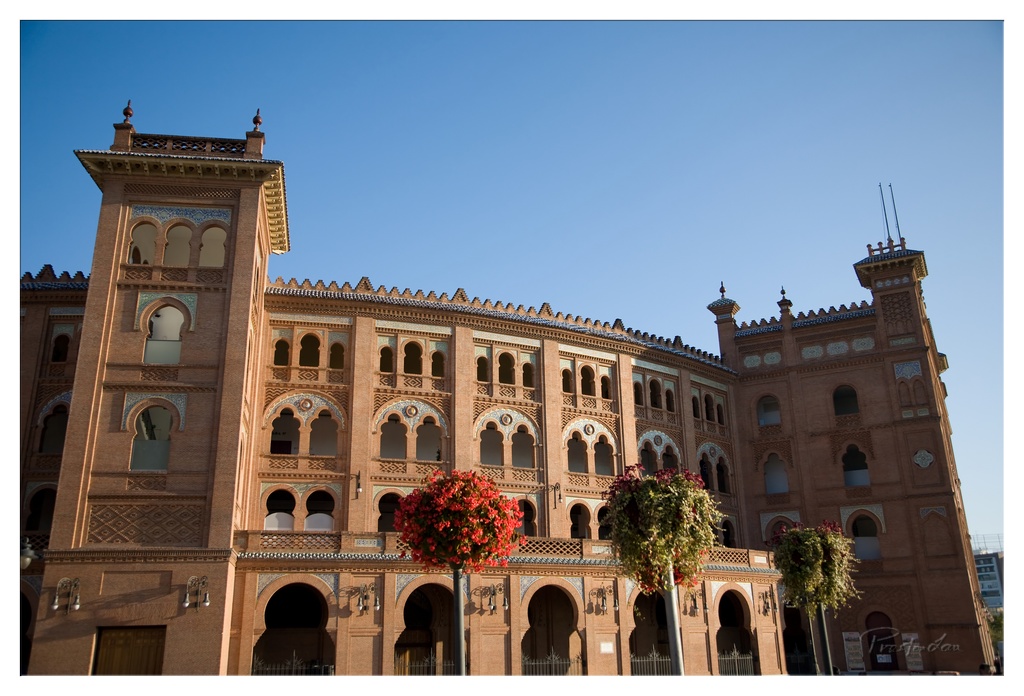

1. Overall Rating (0–10) — 8.0
This photograph captures the grandeur of the Plaza de Toros de Las Ventas with striking clarity and architectural detail, evoking a sense of timelessness and cultural depth. The warm golden light enhances the building’s terracotta tones, while the vibrant floral arrangements in the foreground add a touch of life and color. The image is strong in composition and mood, though the slight overexposure in the sky and a minor distraction in the lower right could be refined for greater visual harmony.
2. Composition (0–10) — 8.5
The low-angle perspective emphasizes the monumentality of the bullring, with its symmetrical façade and repeating arches creating a powerful sense of rhythm. The placement of the flower baskets grounds the image and provides a natural leading line toward the structure, while the expansive sky offers visual breathing room and balance.
3. Lighting (0–10) — 8.0
The warm, directional sunlight from the side highlights the texture and depth of the brickwork and ornamentation, casting soft shadows that enhance the building’s three-dimensional form. The clear blue sky provides a clean backdrop, though the upper portion is slightly overexposed, losing some detail in the brightest areas.
4. Color & Tone (0–10) — 8.5
The warm, earthy tones of the brick contrast beautifully with the vibrant red and green of the flowering baskets, creating a rich and inviting palette. The cool blue of the sky provides a pleasing complementary contrast, while the overall tonal range is balanced and visually engaging.
5. Creativity (0–10) — 7.5
The image successfully captures the cultural and architectural significance of the bullring, with a strong sense of place. The use of color and perspective adds visual interest, though the approach is more traditional than experimental—focusing on clarity and documentation rather than abstract or conceptual interpretation.
6. Technical Quality (0–10) — 8.0
The image is sharp and well-focused, with excellent detail in the building’s intricate stonework and decorative elements. The exposure is generally well-handled, though the overexposed sky and slight flare near the top right indicate minor technical imperfections.
7. Emotional Impact (0–10) — 8.0
The photograph conveys a sense of pride and reverence for a historic landmark, evoking nostalgia and admiration. The combination of architectural beauty and natural elements creates a warm, inviting atmosphere that resonates with both locals and visitors, making it emotionally compelling and culturally rich.
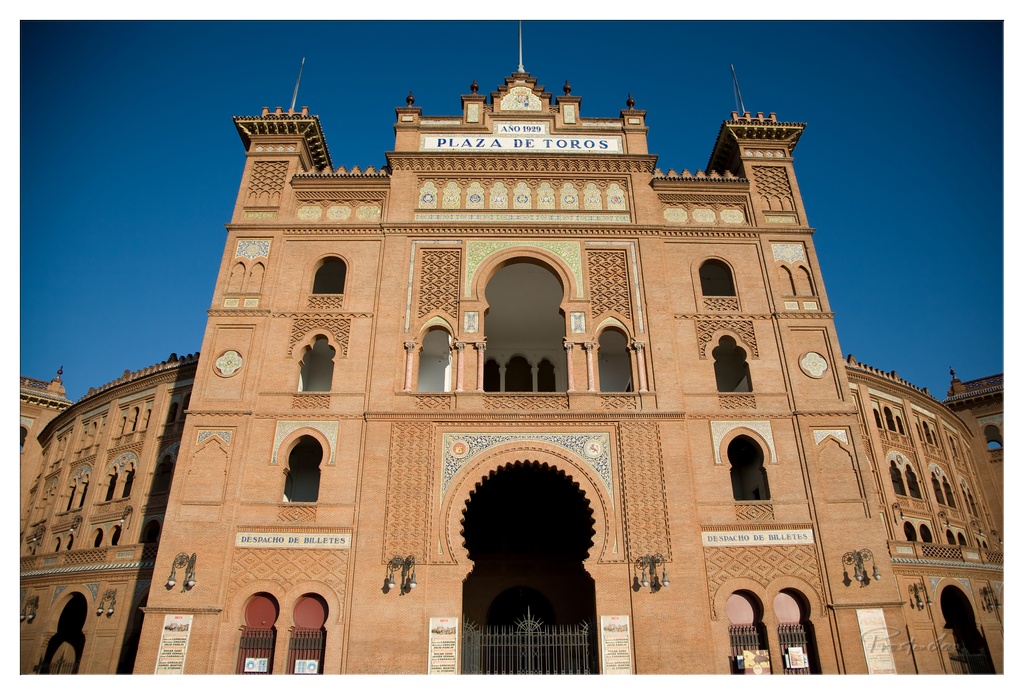

1. Overall Rating (0–10) — 8.0
This photograph captures the grandeur of the Plaza de Toros with striking architectural clarity, where the warm terracotta tones of the bullring contrast beautifully against the deep blue sky. The low-angle perspective emphasizes the building’s imposing presence, evoking a sense of tradition and spectacle. While the image is technically strong and rich in detail, the slightly over-saturated colors and high contrast slightly diminish the natural subtlety of the scene.
2. Composition (0–10) — 8.5
The symmetrical framing centers the main arch and the "Plaza de Toros" sign, creating a balanced and authoritative composition. The low angle enhances the monumentality of the structure, while the surrounding curves of the arena frame the central facade, guiding the eye naturally toward the focal point.
3. Lighting (0–10) — 9.0
Strong, direct sunlight from above casts defined shadows that accentuate the intricate brickwork and ornamental details. The bright illumination highlights the textures of the façade while the deep blue sky provides a clean, high-contrast backdrop that enhances the building’s silhouette.
4. Color & Tone (0–10) — 7.5
The warm terracotta tones of the brick are rich and inviting, complemented by the deep, saturated blue of the sky. However, the vibrancy of the colors is slightly pushed, giving the image a slightly artificial edge. The contrast between the warm tones and cool sky creates a dynamic visual tension.
5. Creativity (0–10) — 7.0
The image is a strong architectural portrait that celebrates cultural heritage, with a clear intent to convey the monumentality of the bullring. While not radically inventive, the choice of angle and timing elevates the subject from mere documentation to a stylized homage.
6. Technical Quality (0–10) — 8.5
The photograph is sharp and detailed, with excellent focus on the façade. The exposure is well-managed, capturing both the bright highlights and the darker recesses of the arches without losing detail. The image is clean and free from visible noise.
7. Emotional Impact (0–10) — 8.0
The image evokes a sense of awe and reverence for a landmark steeped in tradition. The combination of scale, symmetry, and dramatic lighting creates a powerful emotional resonance, suggesting both the drama and dignity of the bullfighting culture it represents.
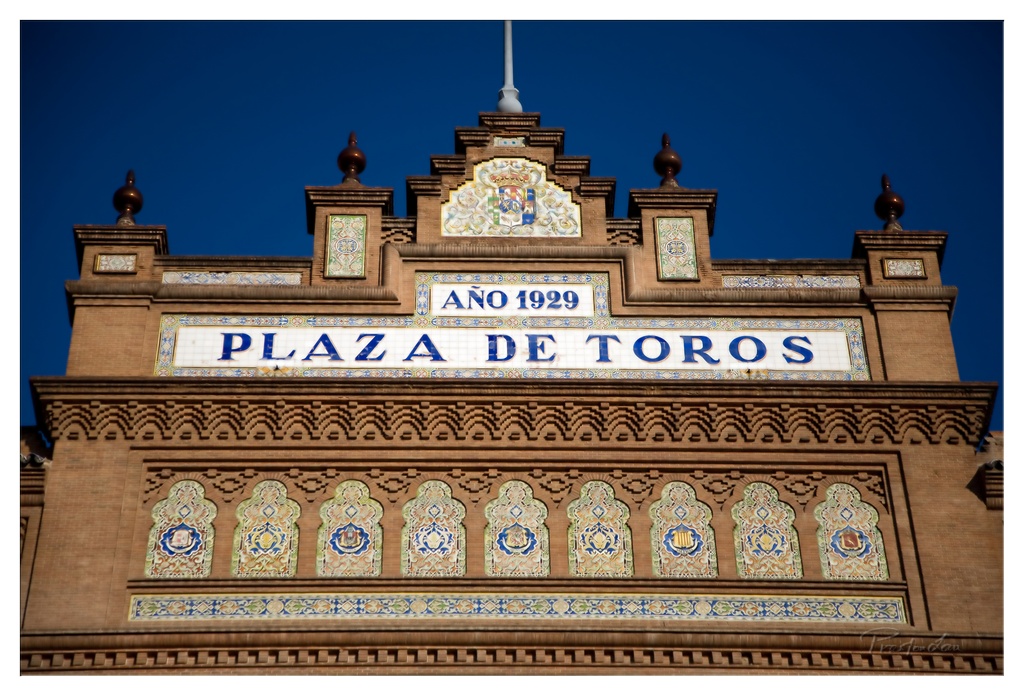

1. Overall Rating (0–10) — 8.0
This photograph captures the ornate grandeur of the Plaza de Toros with striking clarity and reverence for its architectural heritage. The deep blue sky creates a dramatic contrast that elevates the rich textures and intricate tilework of the façade. While the composition is strong and the details are vivid, the image leans slightly toward documentary precision, sacrificing a hint of atmospheric mystery that could deepen its emotional resonance.
2. Composition (0–10) — 8.5
The central framing emphasizes the symmetry and hierarchy of the building’s design, drawing the eye directly to the “PLAZA DE TOROS” sign. The inclusion of the tiled arches and crest above enhances visual balance, while the upward angle reinforces the structure’s monumentality.
3. Lighting (0–10) — 9.0
Strong, direct sunlight highlights the texture and color of the tiles, creating sharp contrast and depth. The clear, cloudless sky provides a clean backdrop that allows the architectural details to stand out with minimal distraction.
4. Color & Tone (0–10) — 8.5
The warm terracotta tones of the brickwork contrast beautifully with the cool blue of the sky and the vibrant blues and greens of the ceramic tiles. The color palette is rich yet harmonious, evoking a sense of tradition and place.
5. Creativity (0–10) — 7.5
While the image is technically masterful, its creativity lies in its faithful representation of a cultural landmark rather than in bold artistic reinterpretation. The focus on historical detail and symmetry reflects a strong narrative intent, but the approach is conventional.
6. Technical Quality (0–10) — 9.0
The image is sharp, well-exposed, and free of noise or distortion. The clarity of the tilework and lettering demonstrates high resolution and precise focus, making the photograph both visually compelling and technically sound.
7. Emotional Impact (0–10) — 7.0
The photograph evokes a sense of pride and historical continuity, particularly for those familiar with Spanish bullfighting culture. While it conveys the grandeur of the space, the lack of human presence or movement tempers its emotional immediacy, keeping it more observational than intimate.
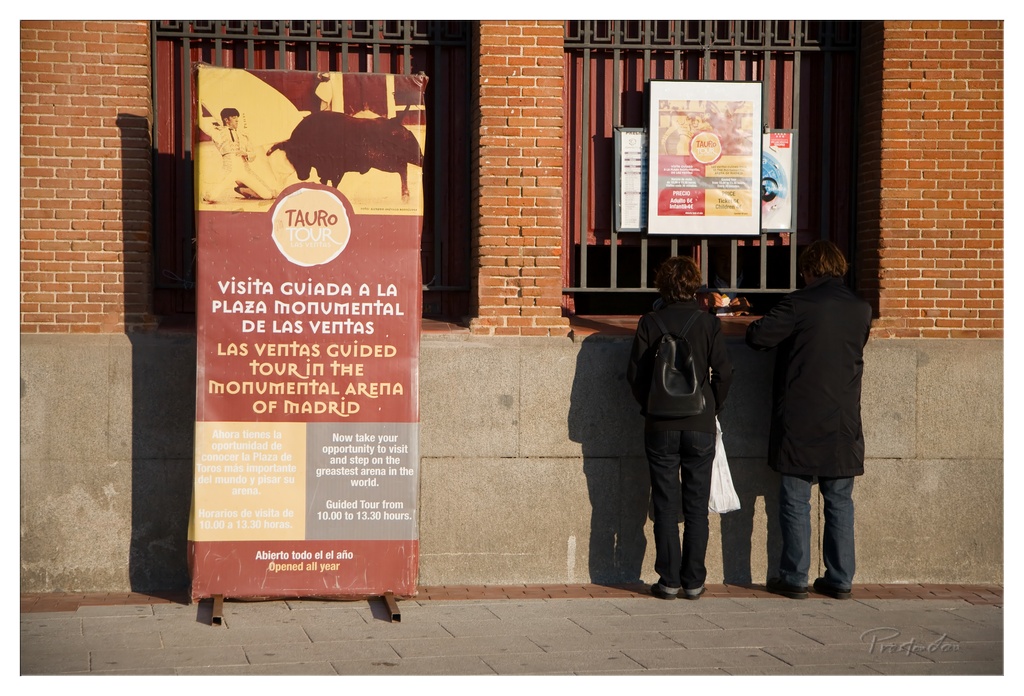

1. Overall Rating (0–10) — 7.0
This photograph captures a quiet moment of cultural engagement outside Madrid’s iconic Las Ventas bullring, where two visitors stand before a ticket window under the warm glow of late afternoon sun. The interplay of light and shadow enhances the scene’s authenticity, while the prominent "Tauro Tour" banner adds narrative depth, inviting viewers into a world of tradition and spectacle. While the composition is grounded and evocative, the image's strength lies in its ability to blend documentary realism with subtle artistic framing—though it could benefit from a more dynamic perspective.
2. Composition (0–10) — 6.5
The subjects are positioned slightly off-center, creating a natural visual flow toward the ticket window, but the left-heavy dominance of the banner disrupts balance. The vertical banner and horizontal lines of the wall and pavement form a structured grid, but the scene lacks a strong focal point beyond the informational text.
3. Lighting (0–10) — 8.0
The golden-hour light casts long, defined shadows and enriches the warm tones of the brick wall, enhancing depth and mood. The directional sunlight highlights textures and creates a sense of time, adding emotional weight to the otherwise mundane act of purchasing tickets.
4. Color & Tone (0–10) — 7.0
The palette is dominated by warm reds and oranges from the brick and banner, complemented by the cool grays of the concrete and the dark clothing of the figures. The contrast between warm and cool tones adds visual interest, though the color saturation is moderate, lending a naturalistic feel.
5. Creativity (0–10) — 6.5
The image captures a slice of cultural life with authenticity, but its approach is observational rather than interpretive. The juxtaposition of tradition (the bullfighting tour) and modern tourism is compelling, yet the narrative remains surface-level, relying more on context than visual metaphor.
6. Technical Quality (0–10) — 8.0
The image is sharp and well-focused, with clear detail in both the signage and the textures of the brick and pavement. The exposure is well-managed, preserving highlights and shadows without significant loss of detail.
7. Emotional Impact (0–10) — 6.5
The photograph evokes a sense of anticipation and quiet curiosity, inviting viewers to wonder about the stories behind the two figures and the ritual they are about to experience. While not emotionally overwhelming, it captures a moment of human connection with place and tradition, leaving room for reflection.
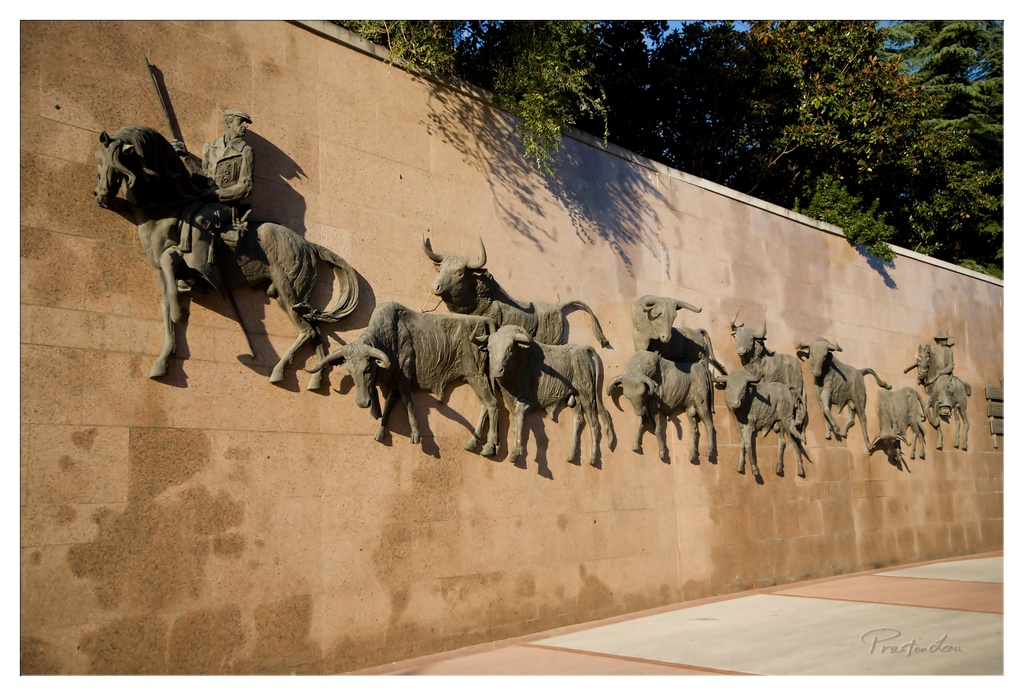

1. Overall Rating (0–10) — 7.5
This photograph captures a dynamic and historically evocative bas-relief sculpture, where the interplay of light and shadow brings the scene to life with a sense of motion and narrative. The warm, golden sunlight enhances the texture of the stone and the metallic sheen of the figures, creating a compelling contrast between the static monument and the implied energy of the movement. While the composition is strong, the right side of the frame feels slightly underdeveloped, and the inclusion of the photographer’s watermark subtly detracts from the immersive quality of the image.
2. Composition (0–10) — 7.0
The diagonal flow of the sculpture from left to right guides the eye naturally across the frame, creating a sense of progression. The low angle emphasizes the scale and depth of the relief, though the inclusion of the pavement and distant trees on the right edge introduces a slight imbalance, pulling focus away from the central narrative.
3. Lighting (0–10) — 8.5
Strong directional sunlight from the upper left casts dramatic shadows that accentuate the three-dimensionality of the figures, enhancing their form and texture. The warm quality of the light imparts a golden, almost cinematic tone, amplifying the monument's historical gravity.
4. Color & Tone (0–10) — 7.5
The earthy tones of the stone wall harmonize with the muted metallic gray of the sculpture, creating a cohesive and grounded palette. The contrast between the warm wall and the cool shadows adds depth, while the green foliage in the background provides a subtle but effective natural counterpoint.
5. Creativity (0–10) — 8.0
The photographer captures a moment of quiet grandeur, transforming a public monument into a contemplative visual story. The choice to frame the sculpture at a low angle and in strong light reveals an artistic sensitivity to both form and narrative, elevating the image beyond mere documentation.
6. Technical Quality (0–10) — 8.0
The image is sharp and detailed, with excellent clarity in the textures of the stone and metal. Focus is consistent across the relief, and exposure is well-managed, preserving detail in both highlights and shadows.
7. Emotional Impact (0–10) — 8.0
The photograph conveys a sense of reverence and timelessness, evoking the enduring nature of cultural memory. The viewer is drawn into the story of the herders and their cattle, feeling the weight of tradition and movement across time and space.
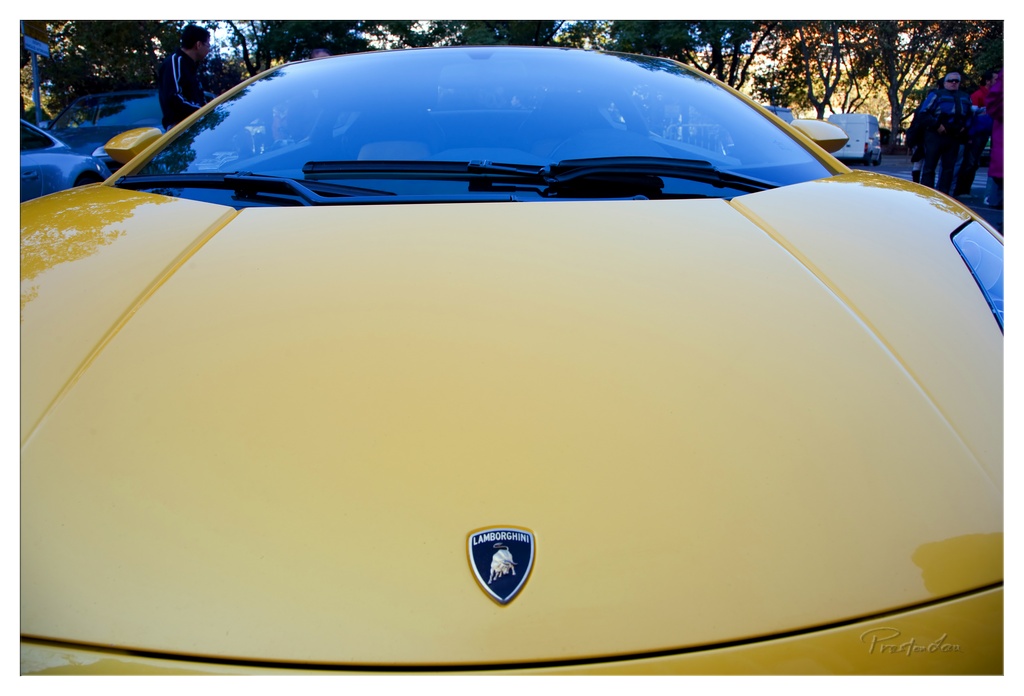

1. Overall Rating (0–10) — 7.0
This photograph captures the sleek elegance of a yellow Lamborghini with a focus on its iconic hood emblem, evoking a sense of luxury and speed. The warm golden hour light enhances the car’s polished surface, while the soft background blur draws attention to the vehicle’s refined lines. Though the composition is strong, the background distractions slightly undermine the image’s exclusivity, preventing it from feeling fully immersive.
2. Composition (0–10) — 7.5
The low-angle perspective emphasizes the car’s aerodynamic form, and the central placement of the Lamborghini badge creates a strong focal point. The diagonal lines of the hood guide the eye toward the emblem, while the blurred background keeps attention on the subject.
3. Lighting (0–10) — 8.0
The soft, golden light of late afternoon bathes the car in a warm glow, enhancing its curves and reflective surface. The backlighting creates a gentle rim around the vehicle, adding depth and dimension to the image.
4. Color & Tone (0–10) — 8.5
The vibrant yellow of the car stands out against the muted tones of the surrounding environment. The warm color palette complements the golden hour lighting, creating a harmonious and visually appealing contrast.
5. Creativity (0–10) — 7.0
The choice to focus on the hood and emblem rather than the full car offers a unique perspective, emphasizing brand identity. While the idea is strong, the inclusion of people and vehicles in the background slightly reduces the image’s conceptual purity.
6. Technical Quality (0–10) — 8.0
The image is sharp and well-focused, with excellent detail on the car’s surface. The depth of field is well-managed, keeping the subject clear while softly blurring the background.
7. Emotional Impact (0–10) — 7.5
The photograph conveys a sense of admiration and desire, capturing the allure of speed and luxury. The warm lighting and sleek design evoke feelings of excitement and prestige, making the viewer feel a connection to the power and elegance of the Lamborghini.
Loading map...